 HOTEL FOOD & DRINK
HOTEL FOOD & DRINK
– THE NETHERLANDS •
•
AT
PILLOWS HOTELS
JOSH NILAND
THE LINK
ONE ZA’ABEEL – DUBAI




003 CONTENTS ISSUE 36 STARTERS The Pinky Ring 032 Bellagio Hotel & Casino Las Vegas Le Petit Beefbar 034 InterContinental The George Edinburgh Hakuba 036 Cheval Blanc Paris 092 072 MAIN
Atria 038 The Ritz-Carlton Melbourne Raffles at The OWO 044 London One Za’abeel 052 Dubai Pillows Hotels 060 The Netherlands 069
COURSES
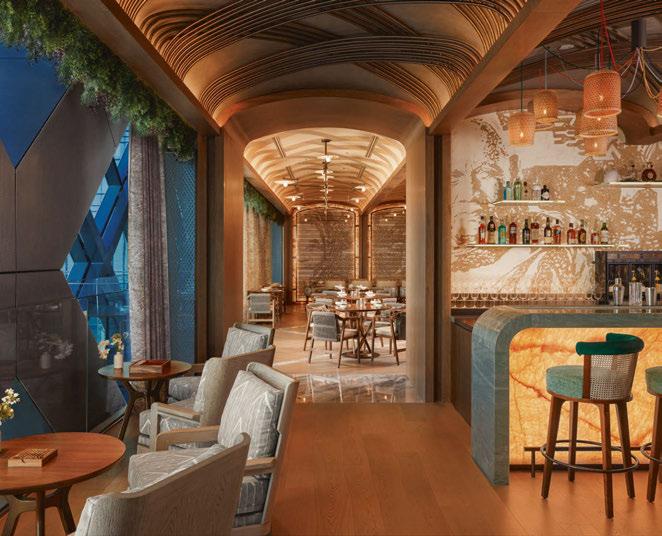


SERVICE
Chef’s Table 024
The illustrious six-Michelin-starred French chef behind the luxurious Hélène Darroze at The Connaught shares a snapshot of her life in food.
The Fisher King 026
Pioneering Australian seafood chef Josh Niland reflects on diving head-first into his new restaurant at The Singapore Edition, where diners are already hooked on his scale-to-tail philosophy.
Cooking Up Opportunity 030
Following Accor’s recent reorganisation, Tony Chisholm, Vice President of F&B MEAT and Asia for Premium, Midscale and Economy brands, discusses financial discipline, international trends and the enduring power of ‘concept’.
DINING
In The Wild 072
In response to the growing desire to reconnect with nature, hotels are embracing the great outdoors with dining experiences nestled in the wild.
SIPPING
The Spirit of Scotland 084
Continuing a time-honoured tale of provenance, prowess and passion, The Glenturret adds accommodation to its award-winning whisky distillery and Michelin-starred restaurant.
004 CONTENTS ISSUE 36
Entrée 017 Appetisers 021 Signatures 069 Aperitifs 079 Cocktails 092 Drinks 097 Spotlight 101 Petits Fours 109 Washing-Up 122 REGULARS 038 052 © Vincent Leroux 036
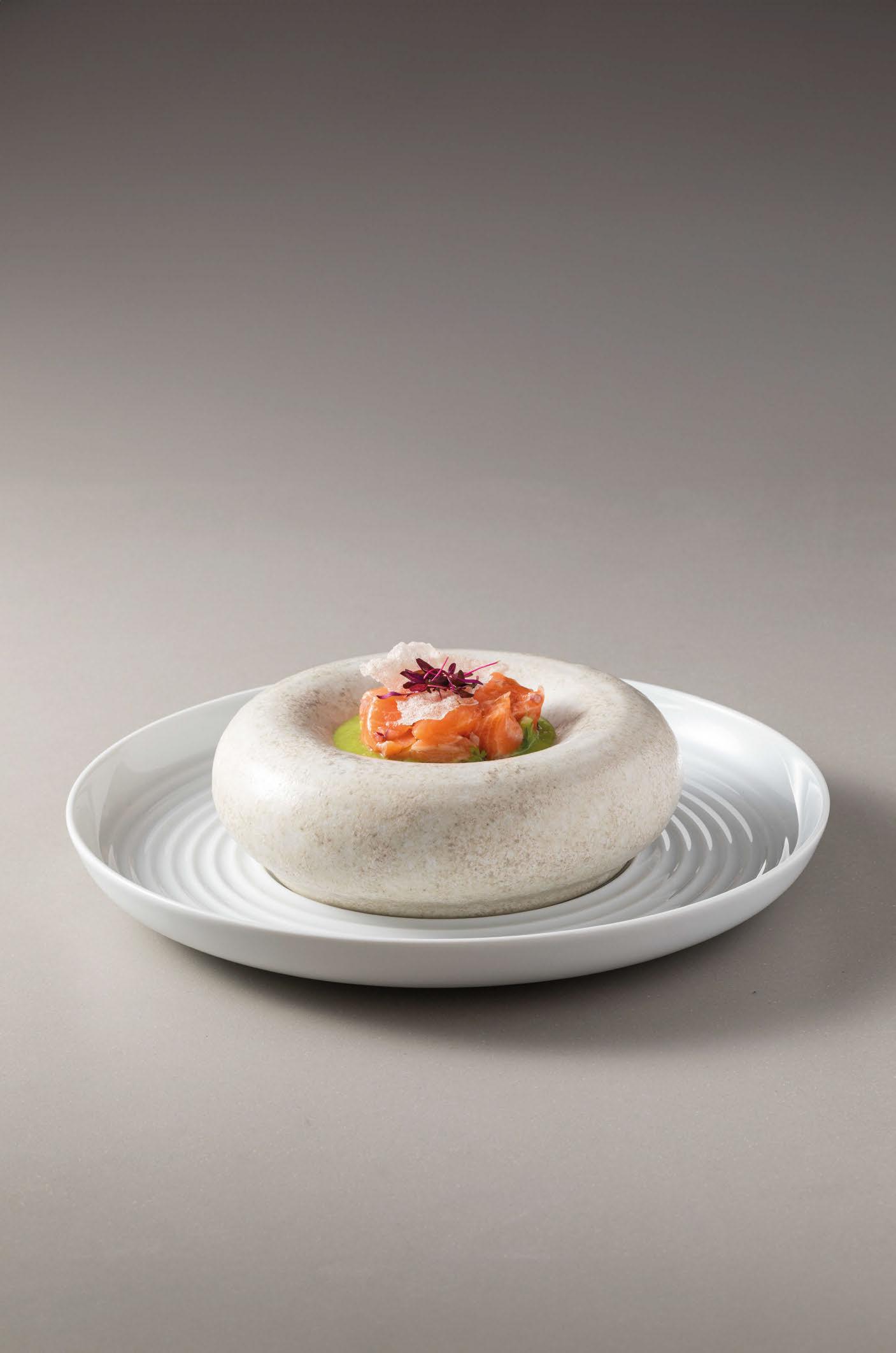
www.costanovaprofessional.com
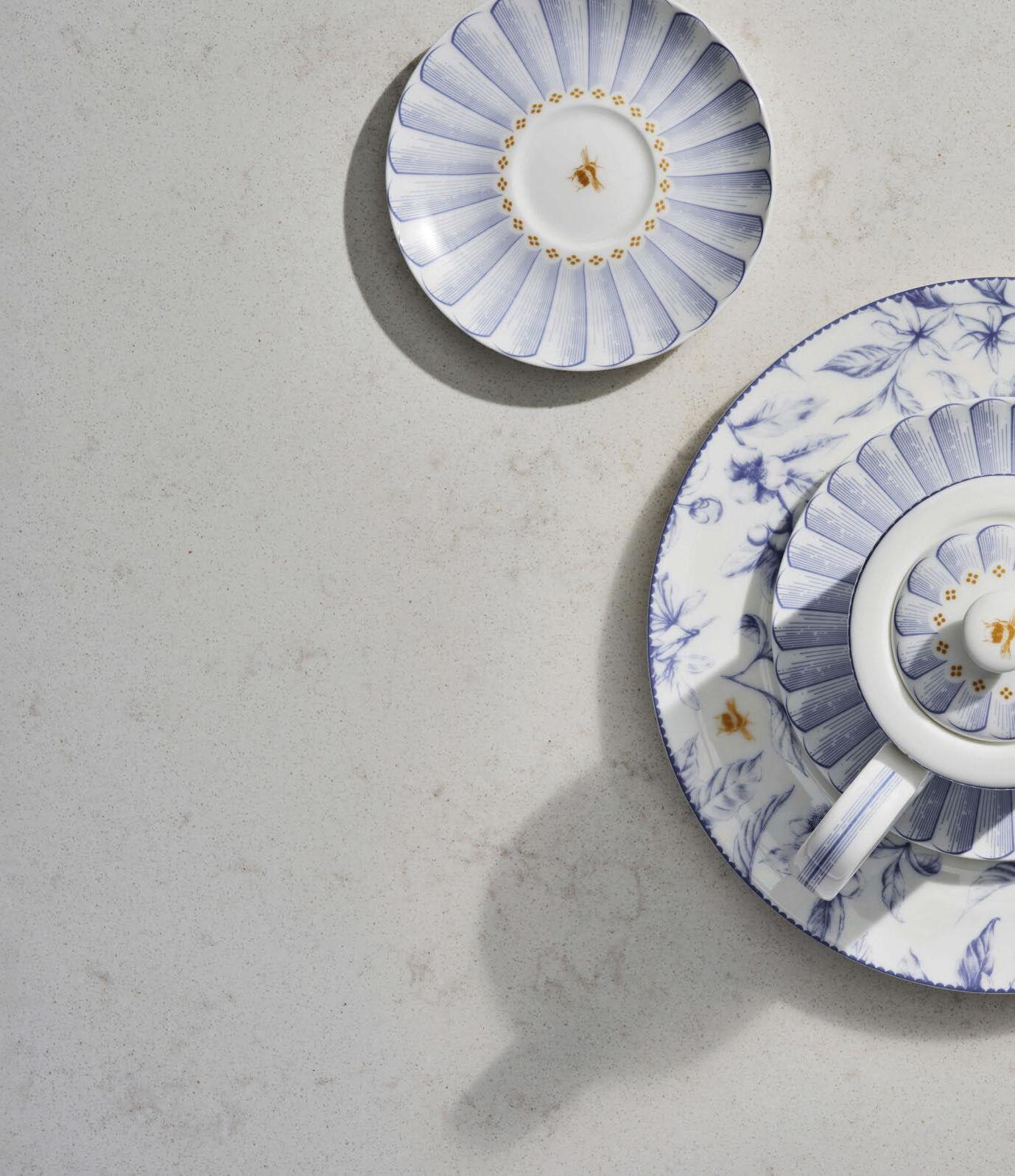
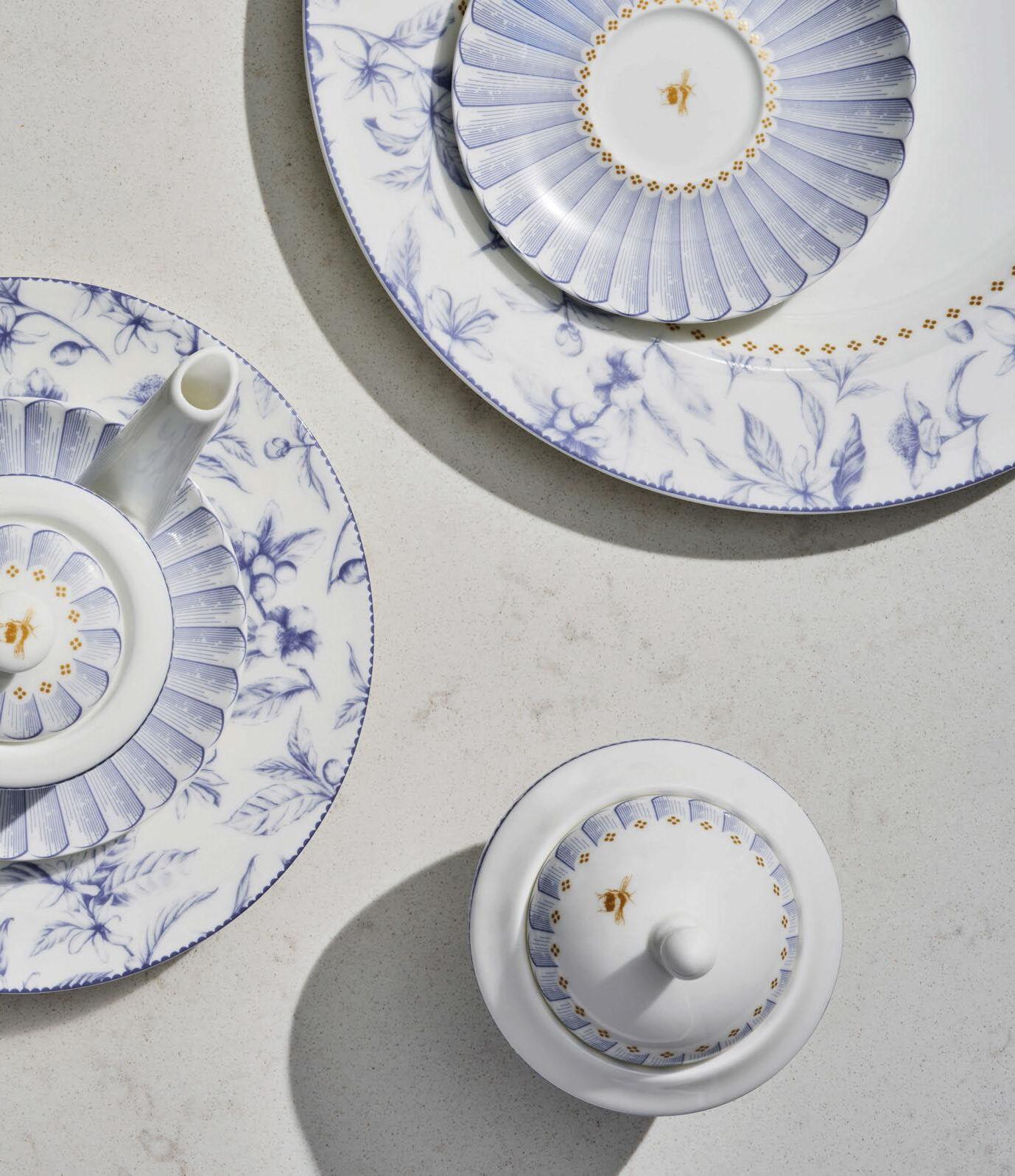



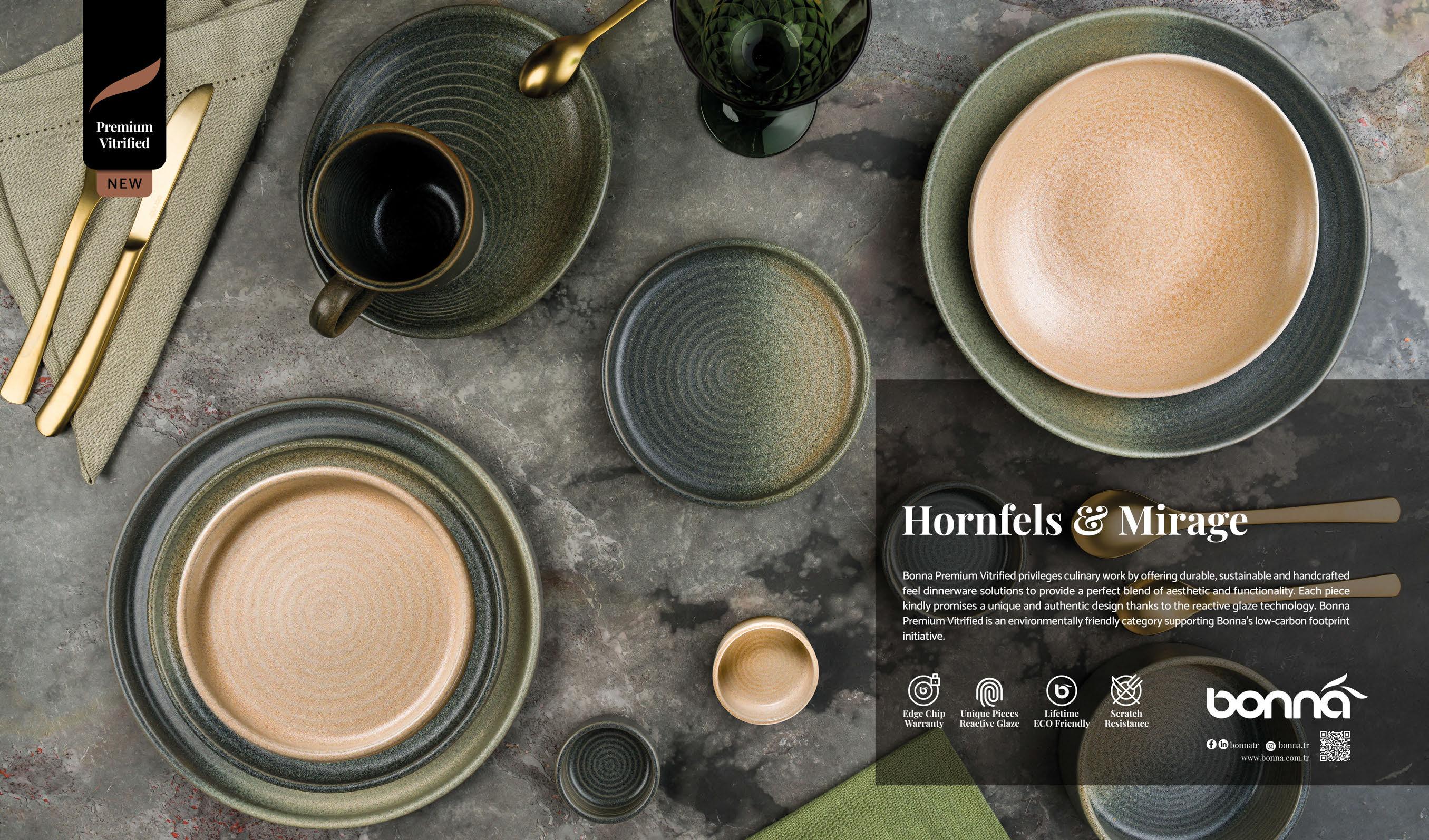



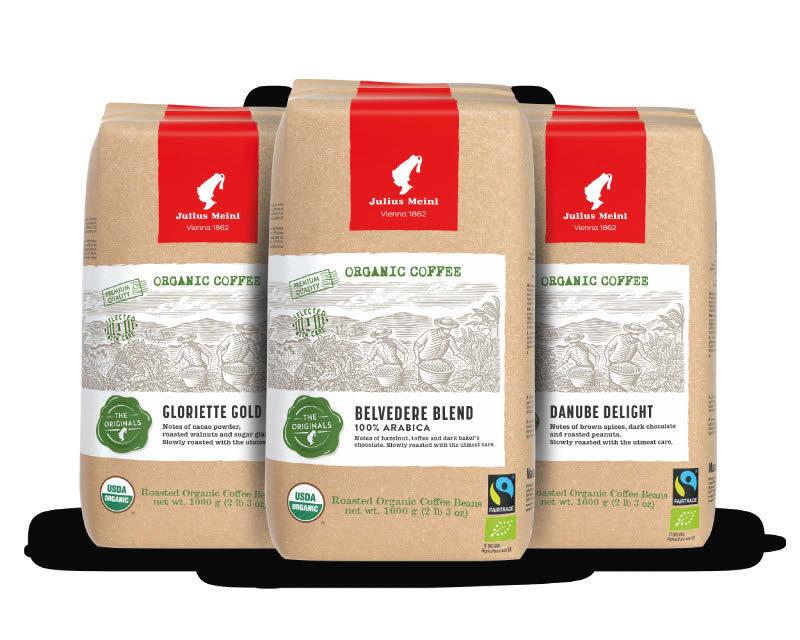
DOUBLE CERTIFIED
Introducing THE ORIGINALS BIO FAIRTRADE.
A range of three doublecertified coffees, with every single bean nurtured through responsible organic agriculture and our trademark Viennese craftsmanship.









COFFEE THAT’S BETTER IN EVERY WAY.
SUSTAINABLE MOMENTS IN EVERY CUP

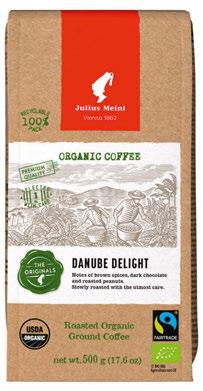
NEW. NOW AVAILABLE IN GROUND COFFEE.


Discover our double-certified coffee collection with three irresistible blends!
BELVEDERE BLEND
100% Arabica
Notes of hazelnut, toffee and baker‘s dark chocolate.
GLORIETTE GOLD
Notes of cocoa powder, roasted walnuts and sugar glaze.
DANUBE DELIGHT
Notes of brown spices, dark chocolate and roasted peanuts.









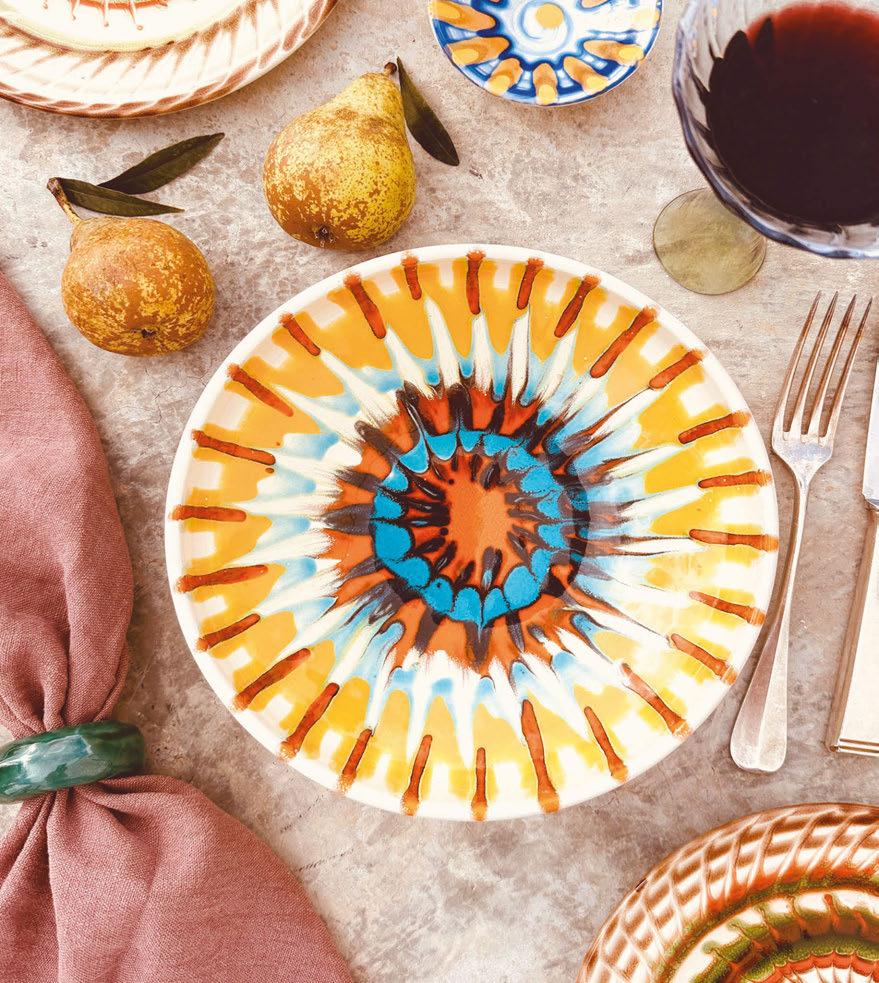


ENTRÉE
The Power of Hotel F&B
Even as little as 20 years ago, the world of hotel dining was in a sorry state. A single restaurant would supposedly suffice for breakfast, business lunches and romantic dinners, with guests begrudgingly enduring a one-size-fitsall approach to both design and cuisine; a last resort after a late-check in rather than a must-visit destination – that luxury was reserved for the five-star establishments. Hotel restaurants weren’t a particularly appealing career choice for the rising cohort of celebrity chefs either; back then, Michelinstarred chefs stationed within hotels were few and far between.
But times have changed, and we aren’t the only ones to take notice. It seems the traditionally food-focused bodies are recognising the merits of the once-humble hotel. Last year, The World’s 50 Best – known for its annual ranking of the top restaurants and bars around the world – stepped into the world of hotels for the first time, producing its own list of leading establishments as voted for by 600 travel experts. And now, Michelin has got in on the act too. Best known for its prestigious star ratings for restaurants in various locations worldwide – a distinction that many chefs aspire to – the guide is now expanding to accommodation. In much the same way that the stars system operates, hotels can be awarded one, two or three Michelin keys, rated according to concept, character and service.
Though such programmes target the end-consumer, their launch is indicative of a change in perception towards hotel dining. Here at Sleeper Media, we have long recognised the shift, introducing Restaurant and Bar, Lounge or Club categories for the AHEAD awards, and launching this very magazine focusing specifically on hotel F&B. Across the sector,
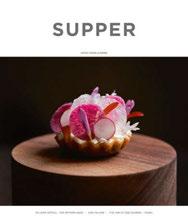
there’s been a growing desire to bring destination dining on site, and the benefits are multi-fold: for the operator, a reputable restaurant or bar will appeal to locals and drive overnight stays, while chefs and restaurateurs benefit from the support of a larger operation, enabling them to focus on cuisine and concept.
So what does this mean for the sector in general? There’s certainly been diversification in choice; hotels now feature everything from grab-and-go and street food outlets to food halls, fine dining and chef’s table concepts. A notable move away from single concept, large-scale venues – often difficult to fill – has resulted in hotels opening up multiple smaller venues, essentially bringing more opportunities for F&B concept developers, more opportunities for chefs and more opportunities for designers and suppliers.
It’s a topic we discuss in this issue during a chat with Accor F&B leader Tony Chisholm – and of course the projects featured on these pages further illustrate the point beautifully. From a resort nightclub in Bali to a landmark London hotel with no less than 12 restaurants and bars, via a dual-branded development in Dubai driven principally by F&B, this issue is testament to both the cultural charm and the financial power of our industry. As always, I hope you enjoy reading this issue. Supper is served.
Catherine Martin • Managing Editor
017
ON THE COVER
The
©
Pillow Hotels,
Netherlands
Courtesy of Pillow Hotels
THE BRIGADE
EDITORIAL
Editor-in-Chief
Matt Turner m.turner@mondiale.co.uk
Managing Editor
Catherine Martin c.martin@mondiale.co.uk
Deputy Editor
Shanna McGoldrick s.mcgoldrick@mondiale.co.uk
Assistant Editor Eleanor Howard e.howard@mondiale.co.uk
Editorial Assistant Cara Rogers c.rogers@mondiale.co.uk
COMMERCIAL
Advertising Manager Rachel Chadwick r.chadwick@mondiale.co.uk
Account Manager
Marley Helme m.helme@mondiale.co.uk
EVENTS
Commercial Lead Kirsty Studholme k.studholme@mondiale.co.uk
Marketing & Events
Olivia Mavers o.mavers@mondiale.co.uk
RESEARCH & MARKETING
Content & Research
Ellie Foster e.foster@mondiale.co.uk
Data & Marketing
Lauren Blain l.blain@mondiale.co.uk
@SupperMag
DESIGN
Design Manager
David Bell
Production Jez Reid
CORPORATE
Accounts ar@mondiale.co.uk
Finance Director Amanda Giles
Chairman Damian Walsh
SUBSCRIPTIONS
Visit the online store to subscribe and save across all Sleeper Media magazines.

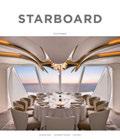
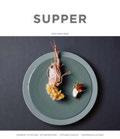
Subscription records are maintained at Sleeper Media. For address changes, email enquiry@sleeper.media. Supper (ISSN: 3033-4349) is published bi-monthly by Sleeper Media Ltd and is distributed by Spatial Global.
SUSTAINABILITY
Natural • Renewable • Recyclable
Supper is printed by Buxton Press on FSC Mix-certified paper using 100% vegetable-based inks. Magazines mailed from Spatial Global are packaged in FSC-certified wrap that is fully recyclable.
Strawberry Studios, Stockport, SK1 3AZ, UK Tel: +44 (0)161 464 4750 • www.sleeper.media
POWERED BY
PORTFOLIO
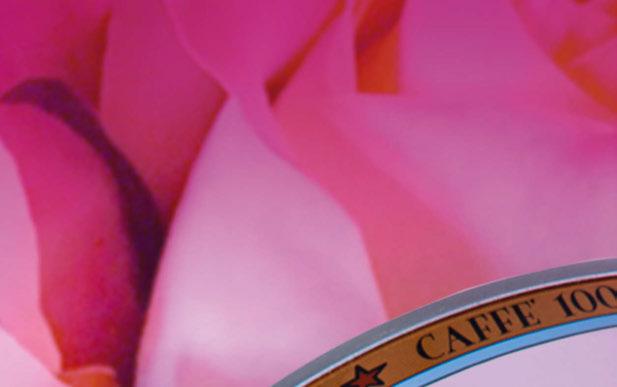













CONSIDERED DESIGN
trade.lsa-international.com Arc Contrast Collection
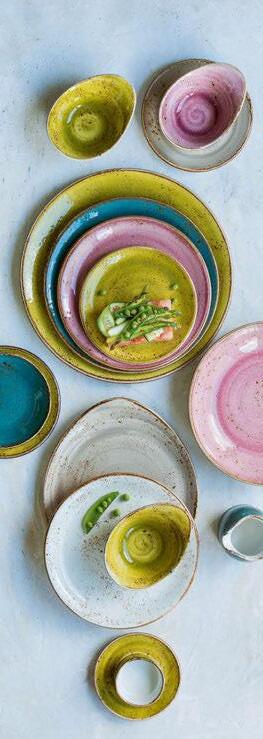
We eat first with our eyes, as the saying goes, and it’s well documented that the dining experience is by no means limited to the sense of taste. Touch, smell and even sound – particularly when it comes to sizzling beef – all have a role to play, as does the way in which food is presented. Studies show that the colour of food can have a strong influence on perceived taste, but does this also apply to tableware? Jozef Youssef, chef and founder of experimental gastronomic design firm Studio Kitchen, set out to answer this very question at Ambiente in February, with a comprehensive survey investigating how coloured tableware influences palates.
hotel operators, restaurateurs, chefs and F&B directors on a similarly colourful multi-sensory journey with a specially-created finger food menu. According to Youssef, red plates increase the perception of sweetness, while yellow proved to be both stimulating and appetising, particularly for fruit-based cuisine. In assessing the perceived healthiness of a dish, blue, green and white plates came out on top. And the worst performing colour on all fronts was revealed to be black, with tasters rating the deep hue to be the least appetising, healthy or sweet.
Reflecting on his investigation, Youssef concludes that there is definite correlation between the colour of tableware and a diner’s
The Power of Colour
Chef Jozef Youssef takes to the stage at Ambiente to explore the impact of coloured tableware on the tastebuds.
Inspired by Professor Charles Spence’s ‘Gastrophysics: The New Science of Eating’ –which details how experiences with food and drink are informed by the five senses and their surroundings – Youssef enlisted hundreds of tasters from around the world to put his hypothesis to the test. He selected three desserts that are familiar across different cultures and presented each on a range of coloured plates. Granola with fruit and yoghurt, fruit salad with ice cream and a slice of chocolate cake with ice cream were served on tableware from Ambiente exhibitors including Bonna, Maham Studio, Revol, Rosenthal, Steelite International and Villeroy & Boch – with a spectrum of hues ranging from vibrant red and yellow to tonal blues and plain white. Participants were invited to peruse the sweet treats online and rate them according to appetite, healthiness and sweetness.
After analysing the results, Youssef presented his findings at Ambiente’s Horeca Academy on Hotelier’s Day, taking the audience of
perception of food, both in terms of increasing appetite appeal and overall visual aesthetics. The latter alludes to the fact that colours could illustrate the menu offering in a supportive way and thus be used to announce seasonal dishes –meadow green in spring for example, or pumpkin orange for autumn. The colour of the plate can also influence taste expectations and aroma, particularly when it comes to desserts. Coloured tableware therefore enables cuisine to be tailored to a specific occasion or target group.
Beyond influencing taste, the style and colour of tableware can help to establish the ambience of a venue, particularly when it harmonises with the overall design scheme and brand identity. Hoteliers and restaurateurs can capitalise on this influence to exceed guest expectations, optimise marketing strategies and contribute to the creation of bespoke dining experiences –resulting in satisfied customers and long-term business success.
021
APPETISERS Courtesy of Steelite International
Edible Histories
Heston Blumenthal creates a sustainable lunch menu that takes diners on a journey through history.
Tackling food waste has become a major initiative across the hospitality sector, with sustainable practices not only beneficial for the environment, but good for profitability too. While many venues are changing their ways through sourcing, preparation and service, Heston Blumenthal is taking a different approach, looking to dining traditions of the past to showcase conscious cuisine for the future. At the two Michelinstarred Dinner by Heston Blumenthal at Mandarin Oriental Hyde Park, the chef has created a new menu inspired by recipes that date back to the 17th century, when nose-to-tail cuisine was simply a way of life. Developed by Head Chef Adam Tooby-Desmond together with Deiniol Pritchard, Creative Director of The Fat Duck Group, The Luncheon is a culinary journey through history, demonstrating how past societies embraced a more sustainable approach to food by minimising waste in their daily eating habits. Across the three courses, each dish is a reinvention of the past, proving that sustainability is not a modernday innovation, but an approach that can help boost understanding of how to make the most of produce and decrease waste.

Menu highlights include:
Ragoo of Pigs Ear on Toast (c.1727): Making use of pigs’ ears and oxtails – undervalued ingredients that are not often used for human consumption – this dish sees the ingredients pressure-cooked for deep flavour and served with a dash of mustard.
Smoked Salmon Belly (c.1847): Originating from ‘The Whole Art of Curing, Pickling and Smoking Meat and Fish’ by James Robinson, this demonstrates Britain’s long tradition for smoking foods; the salmon belly is smoked inhouse on meadow hay, with distinct flavours drawn from coriander, peppercorn, bergamot, lemon and lime.
Salt Cod (c.1769): An example of how off-cuts can be utilised rather than wasted, this dish combines the throat, cheek and collar of cod – all of which are full of flavour and texture – dressed with a tangy horseradish vinegar.
Forced Artichoke (c.1732): Taken from ‘The Compleat City and Country Cook’ by Charles Carter, this meat-free option demonstrates how a vegetable-first diet can be achieved without sacrificing taste, through the use of bone marrow and leftover breadcrumbs in the stuffing.
Pineapple and Cardamom Tart (c.1728): Paying homage to Blumenthal’s love for pineapple, this dessert is inspired by a recipe featured in ‘The Country Housewife and Lady’s Director’ by Richard Bradley, which uses leftover spit-roast pineapple trimmings to make a jam filling for the tart.
Bringing an element of storytelling to the table, The Luncheon is served with informative insight on the origins of the dish and its place in today’s society. In all, the initiative is designed to encourage diners to think about how food is utilised, whilst appreciating some of the unknown cuts that are more than worthy to take their place on the plate.
022 APPETISERS

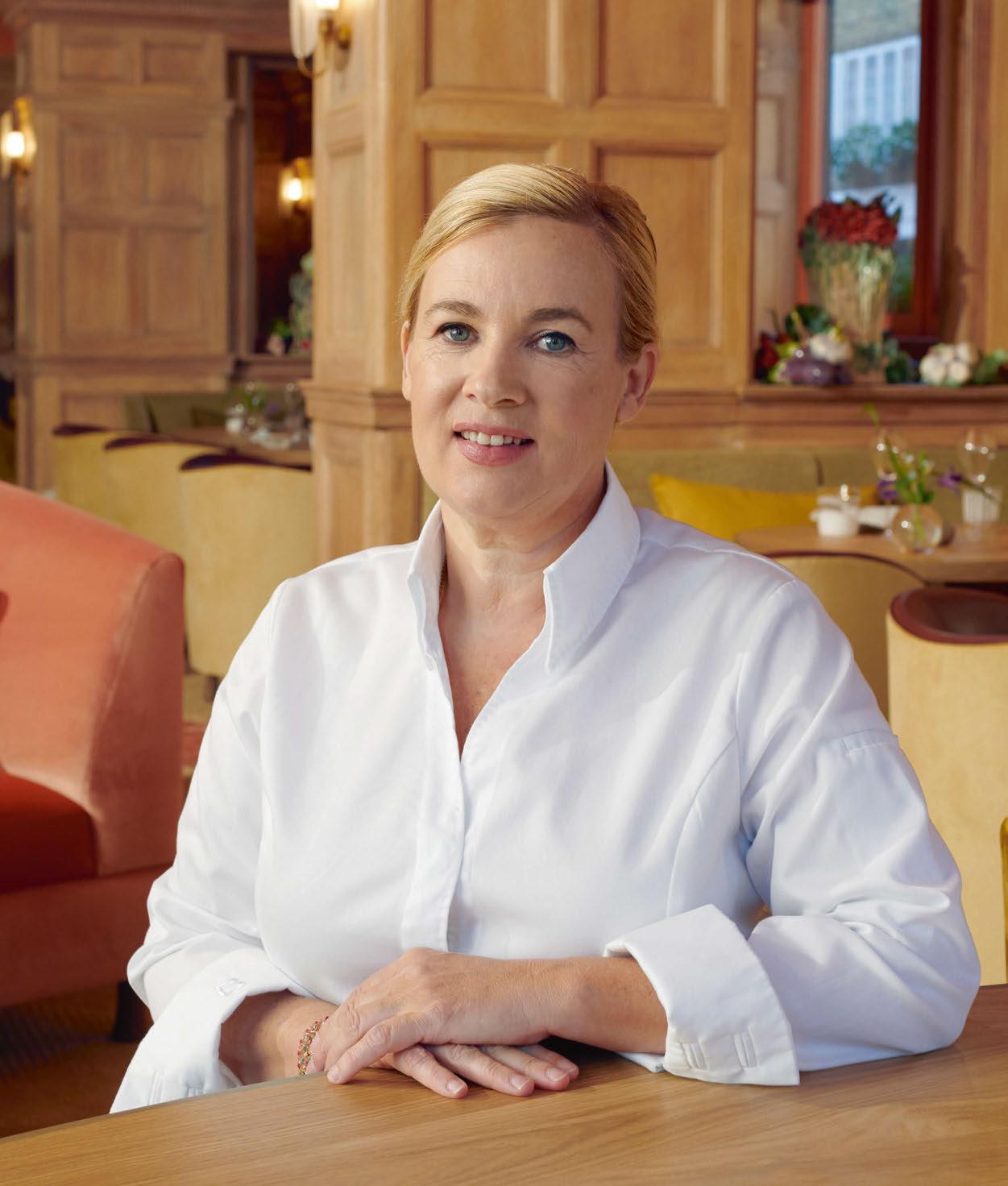
© Jérôme Galland
CHEF’S TABLE
Hélène Darroze
The eminent French chef behind the three-Michelin-starred Hélène Darroze at The Connaught shares her passions, inspiration and favourite food memories.
When did you first fall in love with cooking?
I was raised in the kitchen by a family of chefs, so cooking is in my DNA. My mum tells me that I was interested in food from a very early age, particularly tasting it. One day when I was little, she was cooking something whilst holding me in her arms when I stuck my finger right into the mixture. It must have been a reflex because she was a chemist, not a chef, so I never saw her do that to copy her.
Which chefs have inspired you?
For me, Michel Guérard has always been a source of inspiration. His restaurant was located close to my family’s, so our two families were very close and I would go there often. He was inspiring in many ways; in cooking and what he brought to gastronomy, but also in how he managed people and welcomed guests.
Restaurant dining or room service?
Restaurant dining.
How often do you dine out?
It depends – around 10 times a month.
Are you an easygoing or a demanding restaurant customer?
I’m very easygoing. I decided a long time ago that when I go to a restaurant it’s just for my pleasure. The only thing that might annoy me is if the dining experience is too long.
Which new restaurant are you eager to try out?
My friend, the Michelin-starred Italian chef
Viviana Varese, recently took over the F&B offering at Passalacqua in Lake Como, and I can’t wait to see what she’s doing there. I also want to visit because the hotel is a converted 18th century family villa – I like places where there’s spirit and soul.
Tell us about your most memorable meal. There are so many, it’s difficult to choose just one! I remember in my twenties dining at La Tour d’Argent in Paris, back when they had three Michelin stars, which was very special. Another standout experience was visiting Pujol in Mexico City – it’s super connected to the history and spirit of its location.
What’s your favourite dish, and who cooks it?
My grandmother’s confit chicken with roast potatoes. It reminds me of my childhood because my family would gather every Sunday evening after a busy day at the restaurant to have dinner together. Not only was she an excellent chef, but she brought everyone together.
Who is your favourite person to cook for?
My friends and family because it allows us to spend more time together. Generally when I cook for the ones I love, they help me in the kitchen and then we share a moment around the dining table when sit down to eat.
It’s Sunday evening at home: who’s doing the cooking and what’s on the menu?
I love to cook a dish that we can share, such as pasta and potato with mozzarella. It’s not very
light but it tastes so good. In the winter, I make pumpkin soup with boiled eggs and soldiers because my daughter loves it.
What’s your go-to cooking soundtrack?
I have very eclectic taste in music. When I’m cooking alone I love listening to Bach’s Cello Suites, but I also enjoy Nina Simone and Dua Lipa – it depends on my mood.
Which cookbooks can we find on your shelf?
I Love New York by Daniel Humm and Will Guidara, because it’s all about comfort food and local suppliers.
Sweet or savoury? Both.
Healthy dishes or full-fat indulgence? Healthy dishes.
Where do you get your creative inspiration?
I start with the products and the seasons, then I think about a memory from childhood or travel and the emotions it conjures. It’s a very personal process, developing new dishes. I need to be alone and preferably at home with a blank piece of paper.
Which city is food heaven for you?
San Sebastián. Here you can find all sorts of eateries, from little tapas bars to Michelinstarred restaurants. I have a lot of friends with restaurants here and the ambience, the quality of food and products is superb.
025
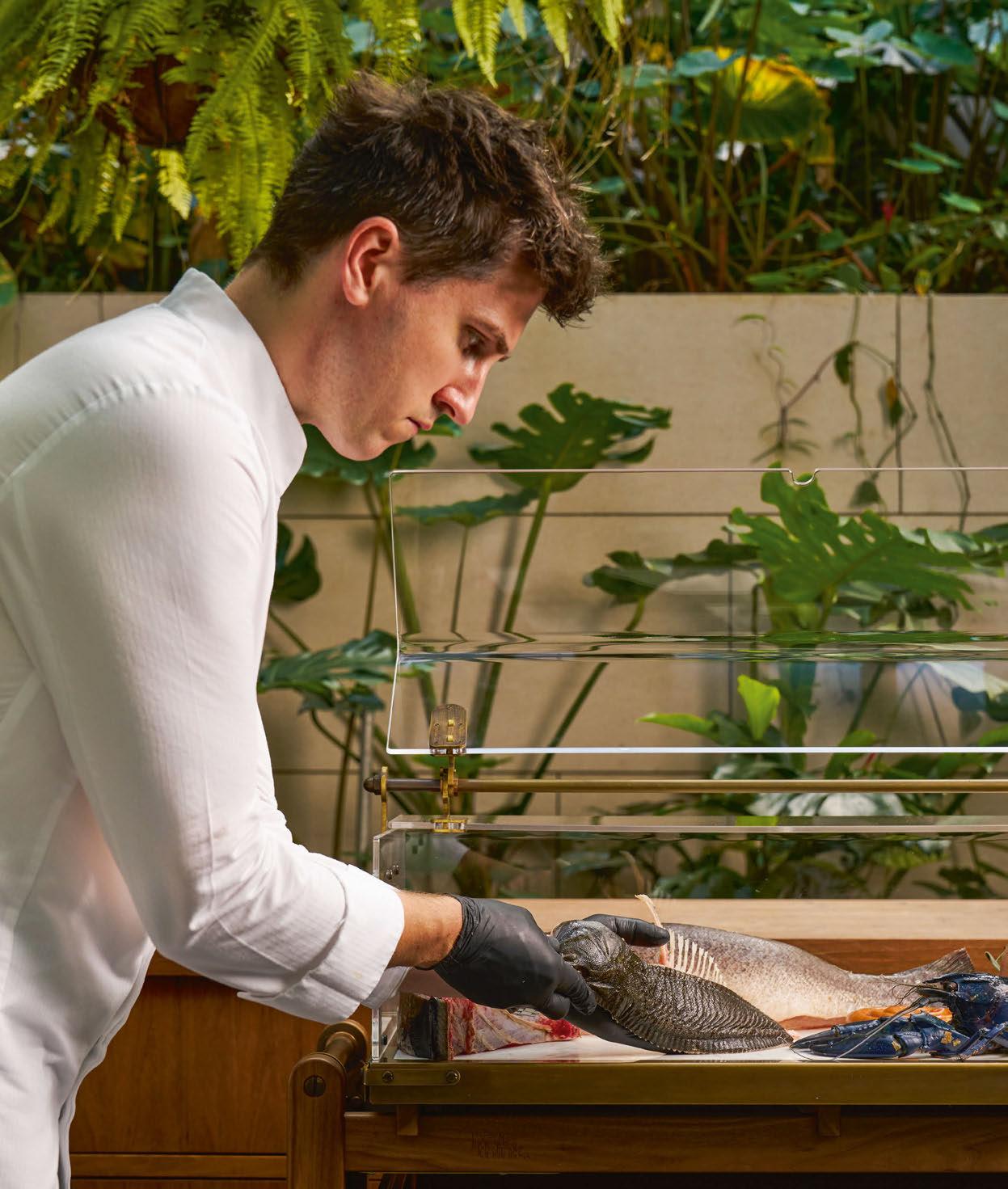
The
Courtesy of
Singapore Edition
The Fisher King
Pioneering Australian seafood chef Josh Niland is diving head-first into his new restaurant at The Singapore Edition, where diners are already hooked on his scale-to-tail philosophy.
Words: Renate Ruge
Wide-eyed Nelson Bay nannygai hang from hooks in neat lines at Josh Niland’s Fish Butchery shop in Sydney’s Waterloo. He dry-ages fish for flavour in cool storage, extending its shelf life from a couple of days to weeks. He applies all the principles of butchery, looking beyond the fillet and treating fish with the same reverence as meat, since “anything you can do with an animal, you can do with a fish”. His flavourful dishes have redefined how the ocean’s bounty is respected and savoured, reimagining the way the world cooks with seafood.
For starters, a fish typically yields less than 50% for most chefs, where Niland maximises 95%, and just like nose-totail cooking with animals, he encourages making use of the whole fish, pushing forward the agenda of eliminating food waste. “Tuna could be a cow, swordfish could be a pig, and mackerel could be a pigeon,” he says. “Without provocation there won’t be any change. It’s no longer okay to throw half a fish in the bin.”
The chef-restaurateur’s legendary knack is drawing the most out of every part of the fish, like heads and eyeballs, livers and blood; some traditionally reviled by the Western world. Not even milt (fish sperm) is considered off-limits. Mastering the catch and the craft is king, as highlighted in the pages of his latest book, Fish Butchery.
The book also serves as a battle cry for action, with Niland challenging the industry to reject traditional
cooking methods. And while diners crave new flavours and experiences, the appetite for making ethical choices when eating out tops the menu, leaving chefs around the world seeking ways to make fine dining more sustainable.
It’s these ethical choices that have snared Niland a Best Chef Innovation Award and the No 32 spot on the Top 100 Chefs in the World list, as well as La Liste’s Gamechanger award. He was named Oceania Cruises Chef of the Year in The Sydney Morning Herald Good Food Guide 2024, and is a board member of The Basque Culinary Centre.
His first fishy tome, The Whole Fish Cookbook, reprinted in a dozen languages, received the coveted James Beard Book of the Year accolade and embraced by international chefs like Nigella Lawson and Yotam Ottolenghi. Niland has joined the top table in conversations on creating change, and the world is listening.
Niland’s passion has quickly reeled diners in. At his takeaway joints in Sydney, the queue often snakes down the street to snag one of his tasty ‘cheeseburgers’, where every single part of a Mooloolaba yellowfin tuna is used with sundries like the head and organs pressed into a fish patty, replacing the traditional beef. Grilled and served with ‘swordfish bacon’, barbecue sauce, cheese and pickles, this dish showcases many sustainable facets, including dryageing, seeing fish as meat and using fish offal. And for dessert? The ice cream may be made from the veins of fish eyes – bringing creaminess to the chocolate macaron – but it tastes delicious.
027 DINING

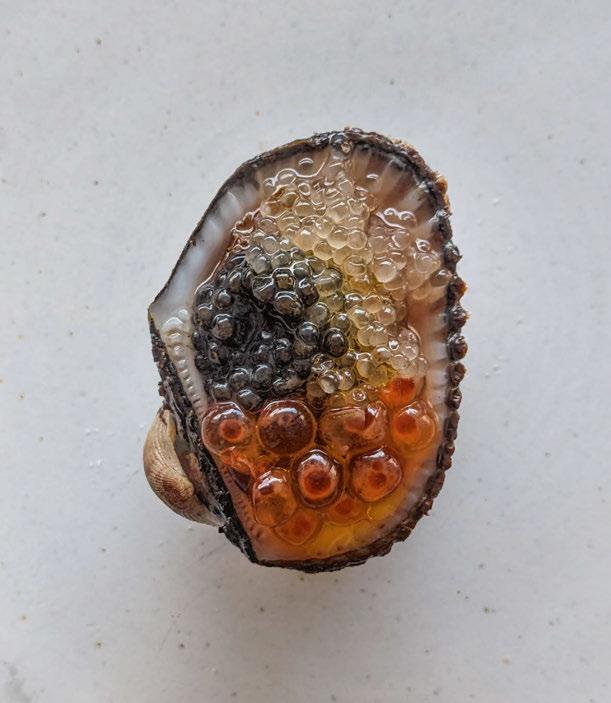
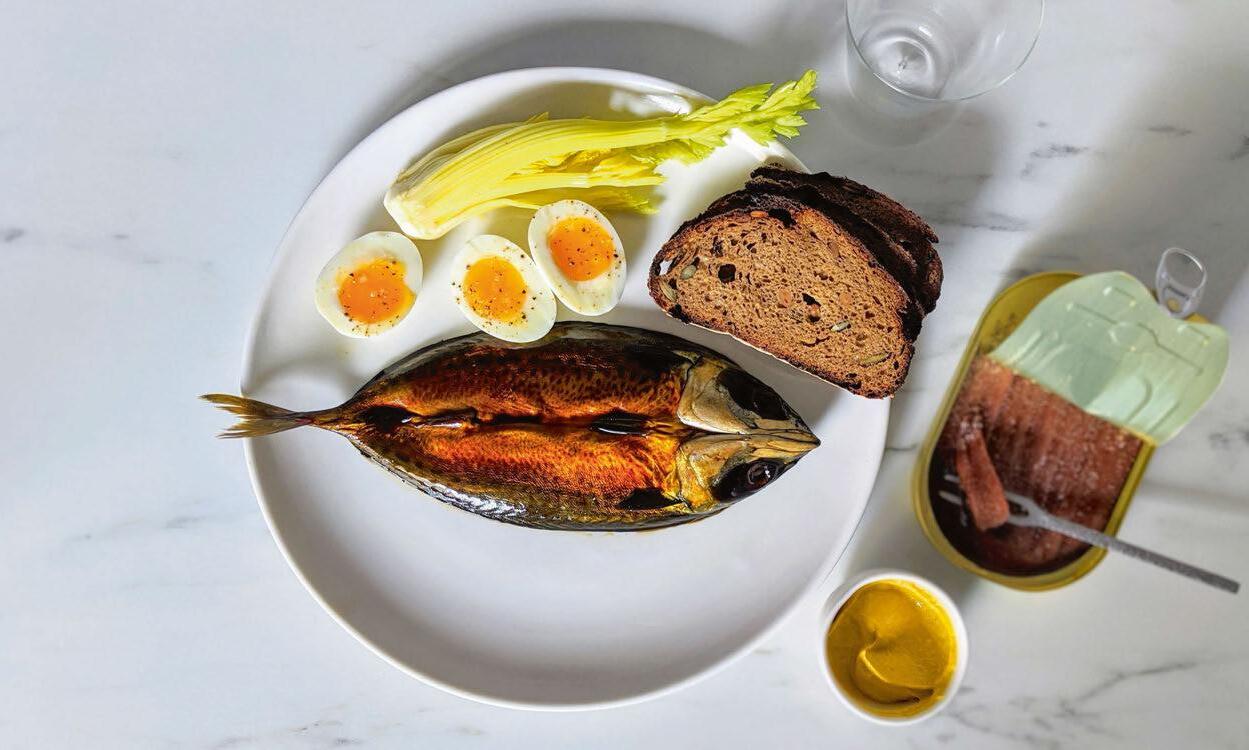 © Josh Niland
© Josh
Niland
© Josh Niland
© Josh
Niland
Niland’s scale-to-tail mission sees him apply the principles of butchery to fish
Now, having carved out his own niche on Sydney’s food scene, Niland is continuing his scale-to-tail mission on Southeast Asian shores with Fysh at The Singapore Edition. The launch makes him the latest in a line of award-winning chefs to have partnered with Marriott’s Edition brand, from Jason Atherton and Tom Aikens to John Fraser and Enrique Olvera. With his new signature restaurant, Niland is as devoted as ever to changing Western perceptions around trawling, eating and cooking more sustainably. The chef hopes that his legacy will mean people view fish as, “a hugely opportunistic product”, continuing to give off-cuts new life, making them as desirable as the primary cuts, mirroring the innovative practices he employs back home. “I love the simplicity of fish,” he states. “There are very few other proteins as exacting – the muscles of the different parts of the fish, the eyes, blood, bones, scales, liver and heart,” he says of the endless potential in culinary applications, cooking offal over charcoal with XO sauce, likening fish liver to foie gras, all “rich and buttery”.
Adding to the Lion City’s cultural melting pot of world-class culinary experiences, creating “something truly special and unique” was equally as appealing to Niland as scaling up his sustainable concept internationally to take his philosophy forward. Being surrounded by “special people” helped in opening an outpost 6,500km from home – “I now have the confidence to push myself professionally,” he admits.
Named after 20th-century Australian aviator Hudson Fysh, who helped to establish the Australia-Singapore air route, Fysh is a green oasis amidst the hustle and bustle of Singapore. The 102-cover all-day dining
Just like nose-to-tail cooking with animals, Niland encourages making use of the whole fish, pushing forward the agenda of eliminating food waste: “It’s no longer okay to throw half a fish in the bin.”
destination, conceived by Ian Schrager Company in collaboration with Cap Atelier, is characterised by high vaulted ceilings and timber-lined walls with a custom scalloped bar in green Antico Verde marble anchoring the space. Upon entry, guests are greeted by a 14-carat gold leaf etching before entering the main dining room, where jade velvet banquettes and Calacatta white marble tables set the tone for intimate and sophisticated ambiance. A sculpture by Jan van der Laan completes the space, while seating under the pergola outside accommodates al fresco dining on tropical nights.
As previous restaurant successes relied on making the most of what Niland had, Fysh falls in line with the tradition of its Australian sibling venues, retaining a strong focus on sustainably sourced seafood. And though he’s widened the offering with quail, chicken and beef options, even the aperitif is in on the concept, with Murray cod fat-washed gin in the house Martini. Fish dishes include rib-on-the-bone cuts and crown roasts, served on plates fashioned from fish bones by Australian ceramicist Sam Gordon. Clams bathed in umami XO sauce are scattered over cod bone noodles and, given that this is a seafood steakhouse, smartly butchered fish is wheeled in on a trolley for guests’ approval, prior to cooking. Grilled swordfish sirloin, yellowfin tuna ribeye and turbot chop and bone are just a few of the tempting options.
With global attention swirling around the new restaurant, it’s likely that Singapore is just the maiden of Josh Niland’s many voyages to distant shores, with his quest to educate the world on scale-to-tail cooking already having a ripple effect.
029
DINING

PROFILE
Tony Chisholm Vice President of F&B – Middle East, Africa, Turkey (MEAT) and Asia, overseeing Premium, Midscale and Economy brands Accor
Growing up with parents who worked in the restaurant industry, Tony Chisholm was perhaps destined for a career in food and beverage. The New Zealand native started his hospitality journey in Auckland with Hyatt, getting experience across various factions of the business and working in locations across Asia, before moving to Accor to further climb the corporate ladder. A foray into private equity saw him work for Gore Capital and KSL Capital Partners, before he returned to Accor in July 2023 as Vice President of Food & Beverage for the Middle East, Africa and Turkey (MEAT) and Asia for Premium, Midscale and Economy brands. His remit encompasses some 938 restaurants and 529 bars across approximately 700 hotels operating throughout the diverse region, with venues located within brands such as Pullman, Swissôtel, Novotel, Mercure and Ibis.
Cooking Up Opportunity
Following Accor’s recent re-organisation, Tony Chisholm, Vice President of F&B MEAT and Asia for Premium, Midscale and Economy brands, discusses financial discipline, international trends and the enduring power of ‘concept’.
Words: Shanna McGoldrick
Accor’s 2023 organisational restructure was designed to accelerate growth and better address market developments, with the shake-up presenting an opportunity for the hotel giant to refresh its approach in the F&B space, in particular, focusing on driving momentum across all property levels, from luxury to budget. Enter Tony Chisholm, whose newly created role as Vice President of Food & Beverage, MEAT and Asia within the new Premium, Midscale and Economy pillar requires overseeing around 1,500 bars and restaurants across the region.
TASTY EATS AND BALANCE SHEETS
“Gastronomy has never been as important in the modern hotel experience as it is today,” says Chisholm. “Everyone’s looking for an experience; everyone’s looking for more authenticity.”
Crucially, he believes awareness of the commercial potential afforded by a strong F&B policy has grown amongst owners at all property levels.
“Whether owners or investors are reselling an asset or it’s a long-term investment, having a successful food and beverage element is on the tip of everyone’s tongue,” he explains. “It’s increasingly apparent that food and beverage is more important to investors than it has been at any point in the last two decades.”
The interest is justified. F&B is projected to pull in €1.3billion across Chisholm’s portfolio
in 2024, accounting for around 30% of total revenue from the Asia and MEAT regions.
Chisholm’s background in private equity means he runs a tight ship, with the Vice President of Operations of each country in his portfolio given access to dashboards displaying precise financial performance metrics and identifying successful venues, as well as opportunities for growth.
“We’re always aware of where we sit monthto-date and year-to-date,” he says. “Overall, it’s about bringing that investment focus to the operating platform and applying it to the way operators run hotels regionally.”
On the ground, that means shifting ideals about how to best manage overheads and boost bottom lines, with longevity becoming an increasingly important buzzword, as owners seek to lock in at least three to five years of success before a change of concept is needed.
INTERNATIONAL APPEAL
So, money talks – and as it turns out, Chisholm isn’t the only one with his eye on the numbers. Amidst the varied and creative gastronomic trends flourishing in his markets, he pinpoints a surprising one: the return of the set lunchtime menu. The appeal, he believes, is partially a response to the global cost-of-living crisis, and partially due to increasingly demanding lifestyles. “Everyone appears to be a little bit
030
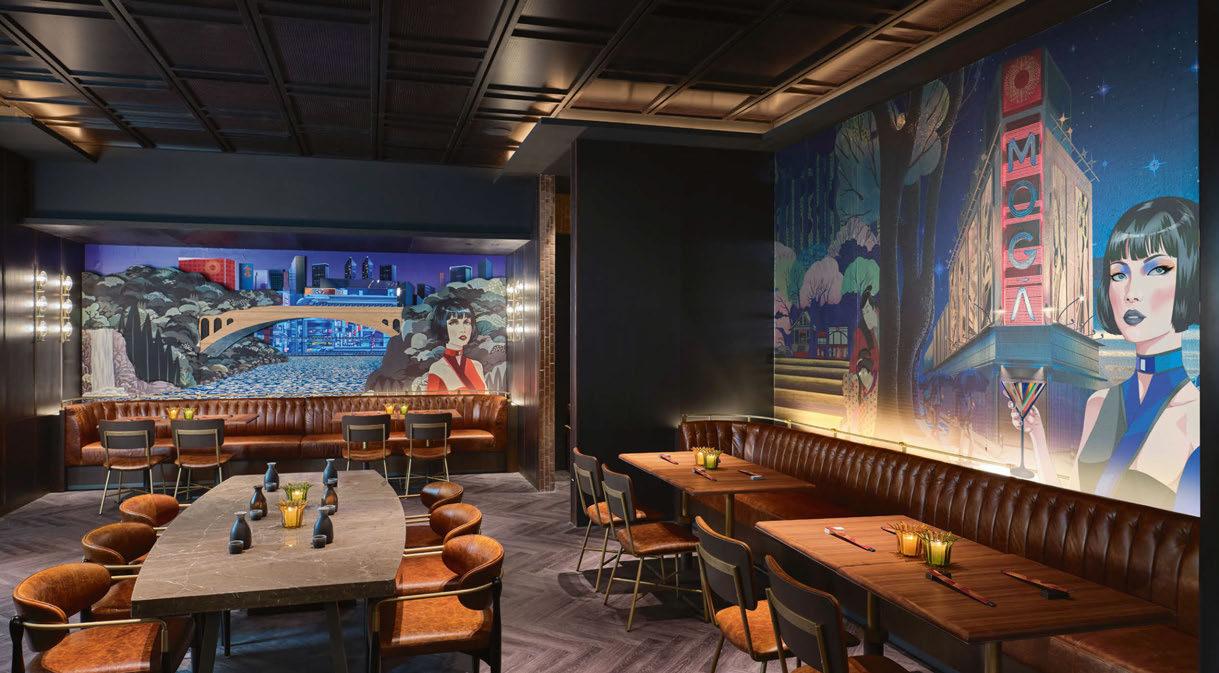
more time-poor than they used to be,” he notes, identifying the 30-45 minute slot as a sweet spot for diners to be able to enjoy two courses at an accessible price, as successfully executed at Pullman Orchard and Mercure On Stevens in Singapore. “The value proposition has become more and more important,” he says.
Meanwhile, venues that skilfully pair cuisines from different ends of the culinary spectrum remain popular. “Mexican, Italian and Indian concepts are working quite well at the moment and there are some venues making great success out of that,” he says. Striking the right balance between offering authentic local dining options and adventurous international foods remains as delicate an undertaking as ever, and fusion cuisine can be a helpful way of ticking different boxes for both international and local guests.
“I’ve just come back from South Korea where, at the moment, there’s a 50/50 or 60/40 split between domestic and international guests,” he explains. “International travellers want to try Korean street food and have local experiences, but at hotels with more of a domestic client base, the Korean guests like to have Italian, Mediterranean, Greek or Indian food.” Putting an international twist on local cuisines, such as the recently-opened Woobriand Korean Omakase concept at Novotel Ambassador Seoul Gangnam, can be an effective way of appealing
to both tourists and locals. The trick to getting the balance right, he says, is carrying out successful market research before F&B concepts are brought to life. “Who is coming to your hotel, what country are they coming from, what’s their spending power, what’s in and around the location?” he asks. “It is very much determined by the origin of the guest that stays in the hotel.”
Though he firmly believes there is space for both local authenticity and global reach when it comes to hotel F&B menus, he stresses that there’s a limit. “It’s really important that people have a sense of place and location,” he says. “But I do think there comes a time when hotels must stop trying to cover the world with a global menu and dial into something that’s relevant, on trend and appropriate for that particular location. I believe hotels are becoming more and more strategic about this approach.”
WHAT’S THE CONCEPT?
One example of blending the international and the local is Gemma’s, an Italian bar and restaurant set to make its debut at Novotel Nairobi in Q4 of this year. Based on the fictional story of an Italian painter who trains as a chef following a trip to Nairobi and opens a gallery-restaurant serving up Italian sharing plates with a dash of Kenyan spice, the ‘social dining destination’ concept is being lined up for at least six more launches over
the next 12-18 months. Elsewhere in the economy sector, Charlie’s Corner is breathing new life into the international buffet dinner in Ibis Doha and Adagio Doha, while the Mad Cow Wine & Grill concept that debuted at Hotel Pullman Saigon Centre back in 2017 continues to expand in the premium division, now counting five venues across Asia, with three more in development.
Chisholm believes that the success of a venue lies in the effective communication of the concept. “Everyone’s talking about ‘concept’,” he laughs. “This was a word you used to hear every six months in the hotel world, and now it’s become a common term – even the general public are asking: ‘what’s the F&B concept?’” Success, though, takes time, with Chisholm targeting three years as the litmus test for viability.
“If three years down the track, the restaurant is still well-regarded in the community by locals, has regular repeat business, and is hitting food sustainability charter ticks, that’s a mark of success,” he says. And of course, it needs to pay its way: “We don’t talk enough about the profitability payback of food and beverage as a business. If you considered the equivalent market rate for rent, lighting and energy per square metre, I think a lot of hotel P&Ls would look different to how they do today. But this is the mindset and the culture that we’re trying to transpose into the teams.”
031
SERVICE
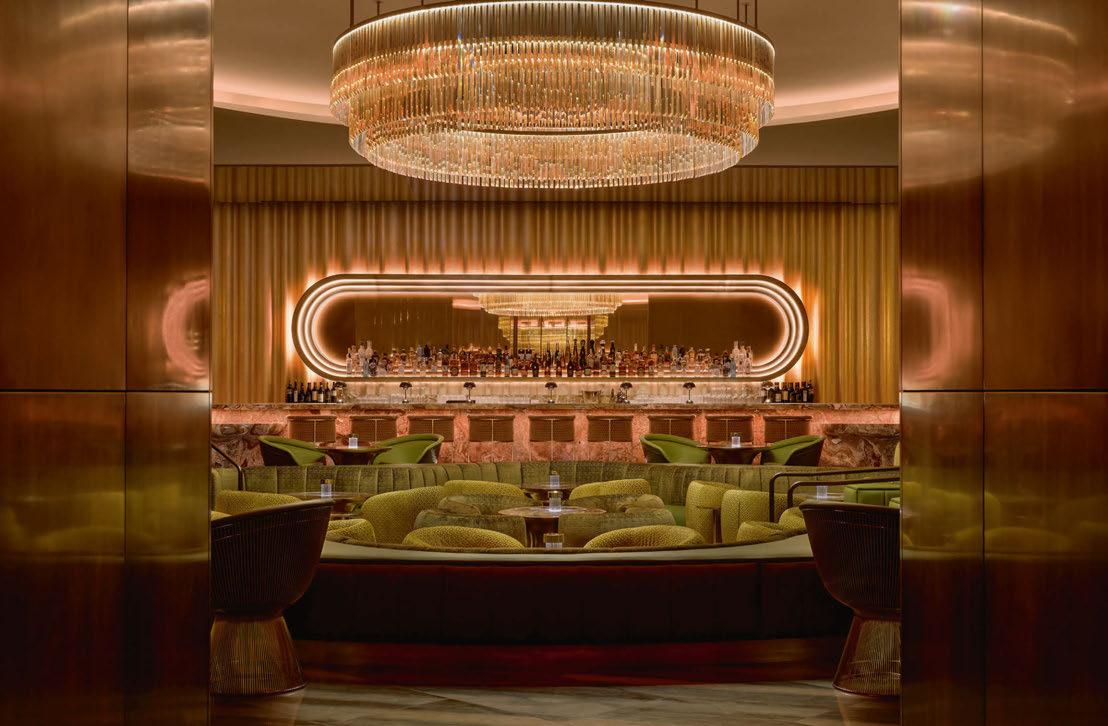
Grammy award-winning musician Bruno Mars has enlisted the talents of Yabu Pushelberg to bring his signature ‘24K magic’ to The Pinky Ring, a new cocktail bar and jazz lounge at the Bellagio Hotel & Casino.
LAS VEGAS
Words: Eleanor Howard
Photography: Courtesy of Yabu Pushelberg
Taking over a former lounge bar, the retrochic venue is a highly curated experience, with the entertainer putting his spin on everything from the design to the live entertainment. “I’ve been performing in Vegas for years and have always wanted a place where I could throw glamorous parties when I’m in town; a place that feels like my personal penthouse suite, with live music and sensational cocktails,” says Mars. “The Pinky Ring is that.”
Upon arrival, a mirrored passageway adorned with Mars’ own Grammy awards leads through to a 70s-inspired Conversation Pit, where seating upholstered in olive green leather snakes through space beneath a tiered glass chandelier. At the rear, a marble counter with mirrored barback spans the length of the lounge, emanating a warm glow. There’s also
a VIP champagne room lined with decadent panelling and banquette seating; plush carpeting and circular tables with built-in ice buckets complete the space.
“In the pursuit of perpetual allure, where lighting not only transforms spaces, but perceptions, The Pinky Ring unveils a strategic lighting innovation, schemed to make people look and feel their best,” explains Glenn Pushelberg. “Through a strategic interplay of low-level, contrast and accent lighting, The Pinky Ring lighting design unveils the unseen.”
Of the extensive cocktail list, signature concoctions include The Hooligan, a spicy margarita named after Mars’ accompanying band, and The Mars Mocha, made with chocolate rum, cognac and espresso, topped with toasted sesame froth and a banana garnish.
The delecatable drinks and Instagrammable interiors are complemented by memorable music performances – however no phones are allowed inside. After all, ‘what happens in The Pinky Ring, stays in The Pinky Ring’.
STARTER 032
The Pinky Ring Bellagio Hotel & Casino
IN A BITE Operator:
Interior Design:
bellagio.mgmresorts.com
MGM Resorts International
Yabu Pushelberg
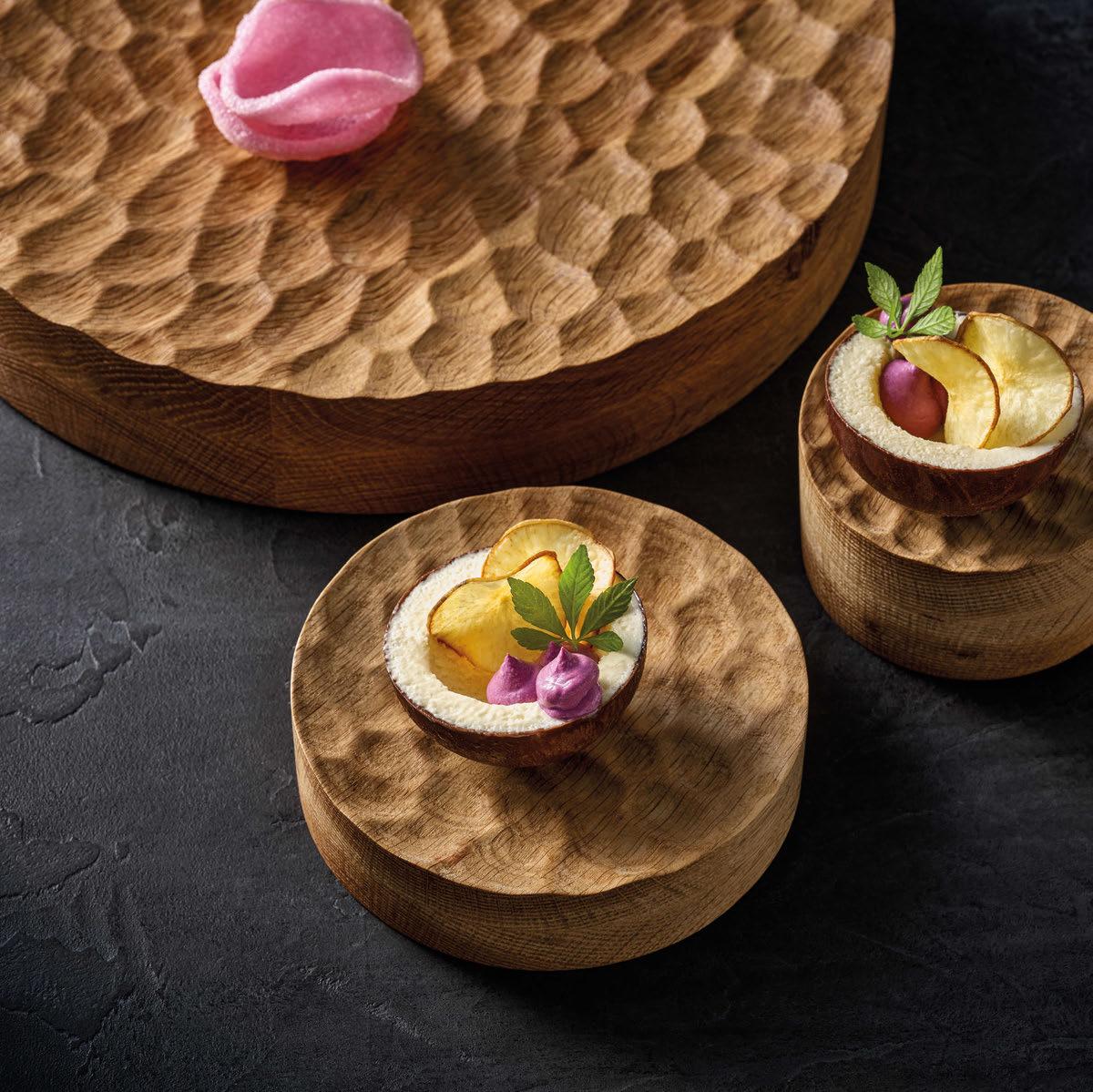
BHSTABLETOP_HOMEOFTABLEWARE

Le Petit Beefbar
InterContinental
Words: Catherine Martin
Photography: Courtesy of Beefbar IN A BITE
Operator: IHG, Beefbar
Architecture: 3DReid
Interior Design: 3Stories
Lighting Design: SSLD
F&B Manager: JF Geyer
Executive Chef: Matthew Parker
Head Chef: Jakub Konrad
Buffetware: Craster
Glassware: Utopia
www.beefbar.com
When IHG brought InterContinental Edinburgh The George back into the fold in 2019, the vision was to create a destination befitting of the historic building, with an F&B offer that is more approachable than the traditional grande dame hotels of times gone by. Following refurbishment of the guestrooms, the restaurant and bar have now undergone a redesign and rebrand, taking the form of Le Petit Beefbar – a laidback version of Riccardo Giraudi’s flagship Beefbar eateries.
The interiors come courtesy of 3Stories, a London-based studio founded by Jordan Littler and Ben Webb, who were tasked with creating a scheme that aligns with both the Beefbar brand and the architecture of the hotel. Their approach sees ornate plasterwork and timber panelling retained in honour of the building’s roots, with new FF&E to mirror the elegant yet cosy aesthetic of Le Petit Beefbar sister restaurants in London, Paris and Dubai.
In Edinburgh, the venue has its own street access to draw in passing trade, with the
interiors spanning two distinct zones. The bar is characterised by plush banquettes set against a backdrop of antique mirror and panelling painted in a handsome shade of British racing green, while the dining room features a lighter base palette accompanied by Beefbar’s signature navy and vibrant accents. 3Stories has been savvy in creating a space that serves multiple uses. By day, a transition zone at the entrance becomes the breakfast buffet – beautifully displayed on Craster buffetware; and by night, the buffet area can be used for wine tastings, while the low-hanging lighting dims to create a cosy, intimate atmosphere.
The cuisine meanwhile is a more approachable take on the original Beefbar menu, featuring premium cuts of meat and sharing-style street food. Favourites include braised short ribs, Kobe beef jamon and an Angus beef shawarma, as well as the signature steak frites, served with the famous Le Sauce Beefbar made using butter, herbs and truffle, finished with a luxurious extract of the ‘Sauce Originale Relais de Paris’.
STARTER 034
The George EDINBURGH


North Hall - Stand 6851 Visit us at Craster.com
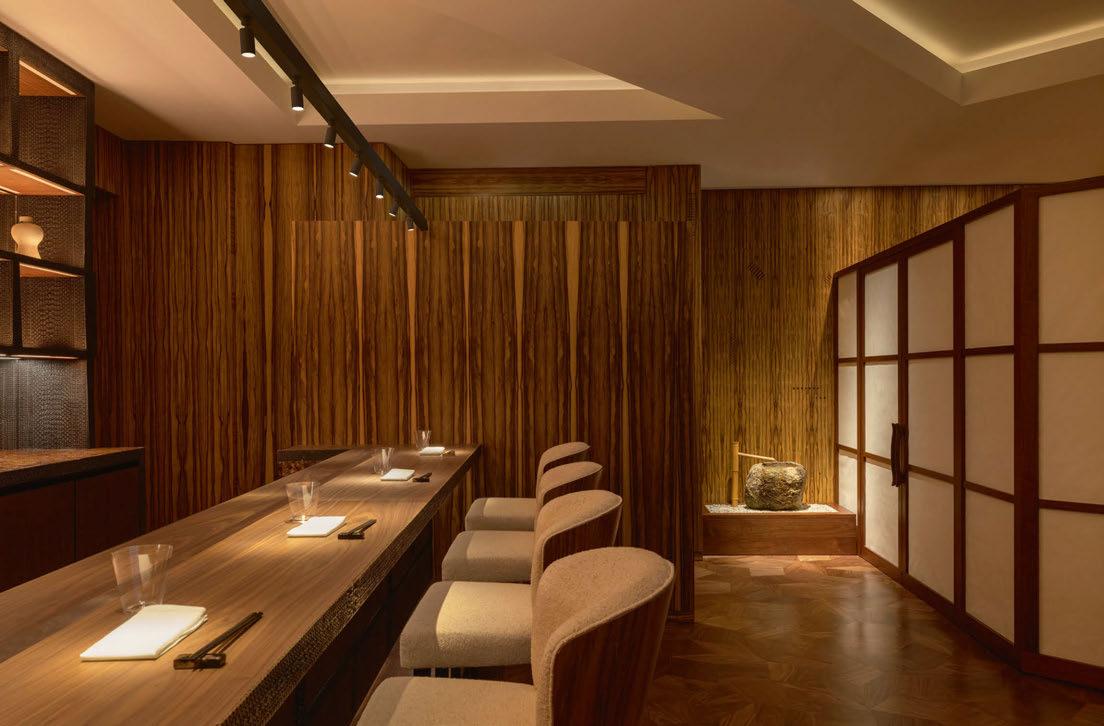
Hakuba
Cheval Blanc
PARIS
Words: Eleanor Howard
Photography: © Vincent Leroux IN A BITE
Owner: LVMH
Operator: LVMH Hotel Management
Head Chef: Arnaud Donckele
Chef: Takuya Watanabe
Pastry Chef: Maxime Frédéric
Wine Director: Emmanuel Cadieu
www.chevalblanc.com
Three years after first opening its doors, Cheval Blanc Paris has enhanced its F&B offer, transforming its ground-floor tea room into a Japanese restaurant.
Meaning ‘white horse’ in Japanese, Hakuba is the result of a collaboration between Head Chef Arnaud Donckele, Pastry Chef Maxime Frédéric and Michelin-starred chef Takuya Watanabe. Together, the trio have combined their expertise to craft two unique omakase menus – Shunkan and Yume. “I knew straight away that this encounter with Arnaud would be a creative fusion that would give birth to the most beautiful Japanese culinary postcard, coloured by his talent,” says Watanabe of the partnership. “Nothing is superfluous. Everything is done in pursuit of the perfect balance of flavours.”
Under the guidance of Donckele – whose skill with sauces has won him six Michelin stars –Watanabe has been granted creative freedom to develop his dishes, making use of authentic ingredients such as raw and caramelised fish, Iio jozo brewery vinegar, soba, finger lime and
seaweed, resulting in a total immersion into Japanese art and gastronomy.
Complementing the omakase menus is an array of sakés and wines, curated by Wine Director Emmanuel Cadieu. And for dessert, Frédéric has brought his analytical finesse to signature Japanese sweet treats such as fruity mochis. “We were keen to reflect the Japanese culture, to create an encounter between the craftsmanship of French pastry and Japanese traditions,” the chef declares. “I have learned a lot about textures, the finer crispiness and working with rice paste.”
The interiors meanwhile offer a similarly contemporary vision of Japanese tradition, with a Tsukubai stone and bamboo fountain establishing a serene atmosphere upon arrival, and dark timber panels in the dining room recalling the Japanese forest. Chefs move between three counters to create a changing theatre, while glassware and plates crafted by artisans from Kyoto and Fukuoka embrace the codes of ancestral craftsmanship.
STARTER 036
The range has a very ne polished rim for an elegant look & feel and re ned drinking experience.

The range has an elegant thin yet robust stem. Proof that elegance can go hand in hand with sturdiness.
BESPOKE

Atria The Ritz-Carlton MELBOURNE
A sky-high restaurant in central Melbourne reaches for the stars with its innovative use of hyper-seasonal regional produce.
Naming a restaurant after the brightest star in the Southern Sky is certainly an audacious move – but for Michael Greenlaw, Executive Chef of Atria, the ambitious astral moniker serves as a fitting reminder of his culinary vision. “We use Atria as our shining star,” says the chef of his latest project, which is located 80 storeys high at the top of the newly minted The Ritz-Carlton Melbourne. “I can walk around the whole 360 degrees of the 80th floor and point to Port Philip Bay, where we source beautiful seafood, or Mount Macedon where we get our ducks.”
The sweeping panoramic views provide diners with a visual embodiment of Atria’s fundamental purpose; to explore and promote the depth of the state of Victoria’s world-class ingredients through a relaxed and adventurous fine-dining lens. In addition to focusing heavily on local produce, Greenlaw has eschewed the classic approach of crafting menus in line with
the four seasons, choosing instead to closely follow the nuances of the region’s weather, inspired by the seven seasons of the Wurundjeri calendar. The result is a menu that changes weekly or even daily, depending on the produce available to the chef and his team.
“Our cuisine at Atria is shaped by the rhythms of our unique Victorian climate and environs,” explains Greenlaw. “Every month is a new adventure, and our menus shift accordingly. It’s not just about heroing what’s in season; it’s often about preserving produce whilst it is abundant and at its peak, in order to create and elevate dishes for the coming months.”
As a keen diver and spearfisherman, Greenlaw naturally gravitates towards dishes that showcase the best of Victoria’s fish and seafood stocks, placing the emphasis on underrepresented and underutilised species. “It takes the pressure off the commercial supply chain,” he asserts. To this end, everything
Words: Shanna McGoldrick
MAIN COURSE
Photography: Courtesy of The Ritz-Carlton Melbourne (unless otherwise stated)

Atria’s menus champion lesserknown Victorian fish and seafood species, in addition to some of Australia’s finest met cuts and hyper-seasonal native produce
from hand-dived sea urchin and dry-aged Murray cod to handpicked mud crab and wild blacklip abalone has appeared on the menu at some point. One of his favourite dishes is a giant Bass Strait crab, which is found off the Southern coast of Australia and can weigh up to 12 kilos. “We steam the crab and pair it with a very light saffron foam and a sea urchin custard,” he says. “It’s nice and fresh for summer; it’s really delicious.”
Occasionally he casts his net a little wider. “First and foremost, we always try to be as Melburnian and as Victorian as we can, but we are flexible and fluid,” he says, adding that he will look further afield “when the time is right for that really incredible Australian produce, such as Western Australian marron or beautiful oysters from the East Coast.” He estimates that around 80% of Atria’s ingredients are sourced in-state and emphasises that no fresh ingredients are shipped from overseas.
It isn’t all about the seafood; Atria’s menus also feature some of Australia’s finest
meat cuts, from venison eye fillet from the Southeastern regions, served as a tartare with smoked bone marrow and blackberry, to dryaged duck from the nearby Macedon Ranges, served with daikon, hakurei turnip and shiso. Other signature cuts throughout the seasons have included Blackmore Wagyu from the Victorian High Country, while native vegetables and plants that have been spotlighted include Victorian spring peas and truffles cultivated in the Central Highlands.
Sustainability, naturally, forms a central part of the culinary ethos at Atria, and in addition to working with small-scale growers and artisan producers, Greenlaw is committed to minimising waste through pickling and preserving. Dreaming up creative ways to incorporate ingredients that would otherwise be discarded is also a key part of the process –in fact, it is literally the restaurant’s bread and butter. Diners are welcomed to their tables with crusty hunks of sourdough served with a hearty scoop of moreish Gippsland cultured butter and
040

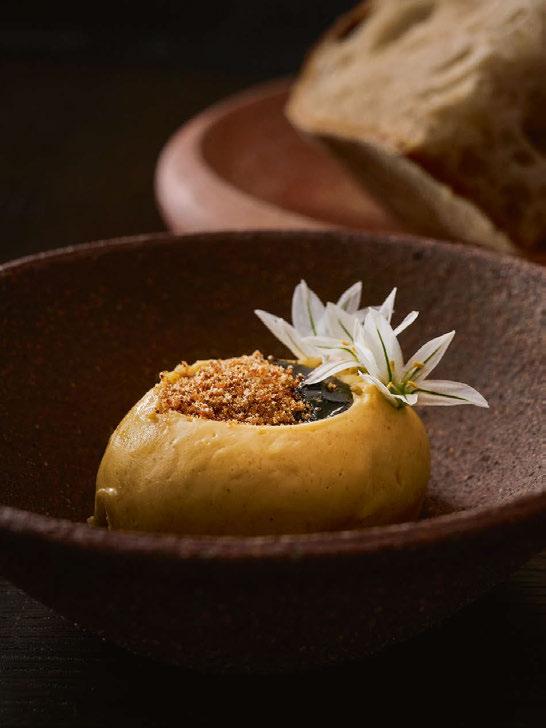

041 MAIN COURSE © Anthony Hart
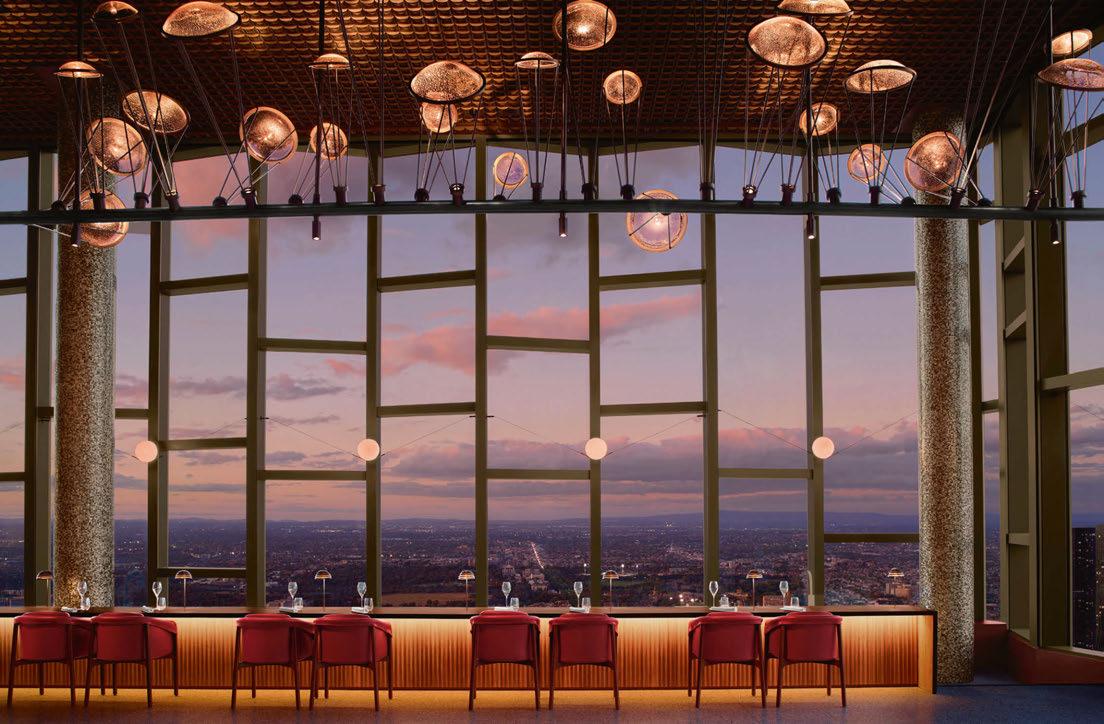
sourdough miso that perfectly embodies the no-waste philosophy. “We’ve got these giant sourdough loaves that are almost 60cm wide, but there’s a lot of crust and the guests often don’t want too much crust,” says Greenlaw. “So, we take that sourdough crust and create miso. We preserve it for three months with koji and make what is almost a traditional miso and incorporate it back into the butter.” He adds: “Being creative with our waste and turning it into something delicious is at the heart of what we try to do.”
The sense of place is reiterated in Atria’s design. The restaurant’s soft interplay of marble, brass and glass echo the sophisticated glamour of the Art Deco and Art Nouveau eras with a feather-light touch, but the true showstopper is a 26-seater bar made from a 19-metre Victorian Ash that anchors the restaurant to its culinary ethos with stylish aplomb. Elsewhere, artwork inspired by acclaimed Australian painter Fred Williams frames the corridor leading to the dining area, while a statement chandelier
handmade by local artists at The Flaming Beacon is a nod to Melbourne’s first-rate reputation for the arts. Bespoke ceramic tableware from the Australian potter and artist Andrei Davidoff adds an artisanal effect to the tablescapes, neatly offset by delicate glassware from Riedel and sleek appliances such as the countertop La Marzocco KB90 espresso machine.
Committing to a constantly evolving menu led by the land cannot be without its challenges, but Greenlaw maintains that it helps to keep the process intriguing. “It’s a very collaborative team environment – you need that with this level of creativity and the amount of dishes and techniques involved,” he says, explaining that he and his sous chefs each spend one day per week planning for what’s coming up and how to maximise preservation opportunities. “The chefs are passionate and hungry and we’re all constantly learning about new produce and new techniques and having a lot of fun” he adds. “Nothing gets stale. It’s always a nice, relaxed pace but we get excited about what’s next.”
IN A BITE
Owner / Developer: Far East Consortium
Operator: The Ritz-Carlton
Interior Design: Layan
Graphic Design: 3 Deep
Executive Chef: Michael Greenlaw
F&B Director: Benjamin Vernes
Head Bartender: Jean-Christophe Beysecker
Head Sommelier: Sean Lam
Beverage Manager: Rosie Kim
Beverage Consultant: Michael and Zara Madrusan
Coffee Machine: La Marzocco www.ritzcarlton.com
MAIN COURSE 042
© Christopher
Cypert


Objects to be admired by the Feel
Raffles at The OWO
LONDON
Leaders behind the transformation of London’s Old War Office bring together award-winning chefs, brand debuts and industry firsts for a new culinary landmark.
Words: Catherine Martin • Photography: Courtesy of Raffles (unless otherwise stated)
Making a mark in a hospitality hotspot such as London is no easy feat in today’s ever-changing culinary landscape, so when the Hinduja Group embarked on the conversion of The Old War Office into a luxury hotel, they knew the F&B programme had to be as monumental as the building itself. Along with a goal of securing a best-in-class operator to manage the 120 guestrooms and 85 branded residences, there has been clear ambition in the culinary line-up, differentiating through brand debuts and industry firsts.
In total, The OWO as a destination houses a collection of nine restaurants and three bars, seven of which are under the Raffles banner, with the remaining venues operated independently within the mixed-use scheme. Ranging from Italian to Japanese, casual to fine dining, all are unapologetically sumptuous, whether it be in the interior design scheme or the cuisine.
On the design side, EPR led on the architectural conversion with The Office of Thierry Despont taking on the interior design of the hotel component, while in the culinary realm, Mauro Colagreco headlines the F&B programme. Taking charge of three venues, the Michelinstarred chef makes his UK debut following huge
success with Mirazur, widely regarded as one of the best restaurants in the world. Driven by a commitment to seasonality and local sourcing, all three of Colagreco’s dining experiences showcase the UK’s best organic produce, procured daily from farms, fields and shores across the country. The signature restaurant –Mauro Colagreco at Raffles London at The OWO, to give its full name – is an ode to discovery through food, with particular focus on the rich diversity of native British vegetables. The fivecourse Land & Sea menu is listed simply by the name of a vegetable, though the finished dish showcases a multitude of innovative flavour combinations. ‘Lettuce’ for example, is in fact local red oak lettuce accompanied by succulent smoked fish and vermouth sauce. ‘Kohlrabi’ comes with crab, rosemary cream, apple and celery juice. And ‘Pear’ accompanies Merrifield Farm duck, spiced wine and Bordelaise sauce. Each dish is served with a beautifully illustrated postcard describing the history of the vegetable in question. Colagreco calls it a love letter to the British country garden, and the interior design scheme of the restaurant follows suit, with the selection of artwork a reflection of what’s on the plate.

044

MAIN COURSE 045 © Justin de Souza
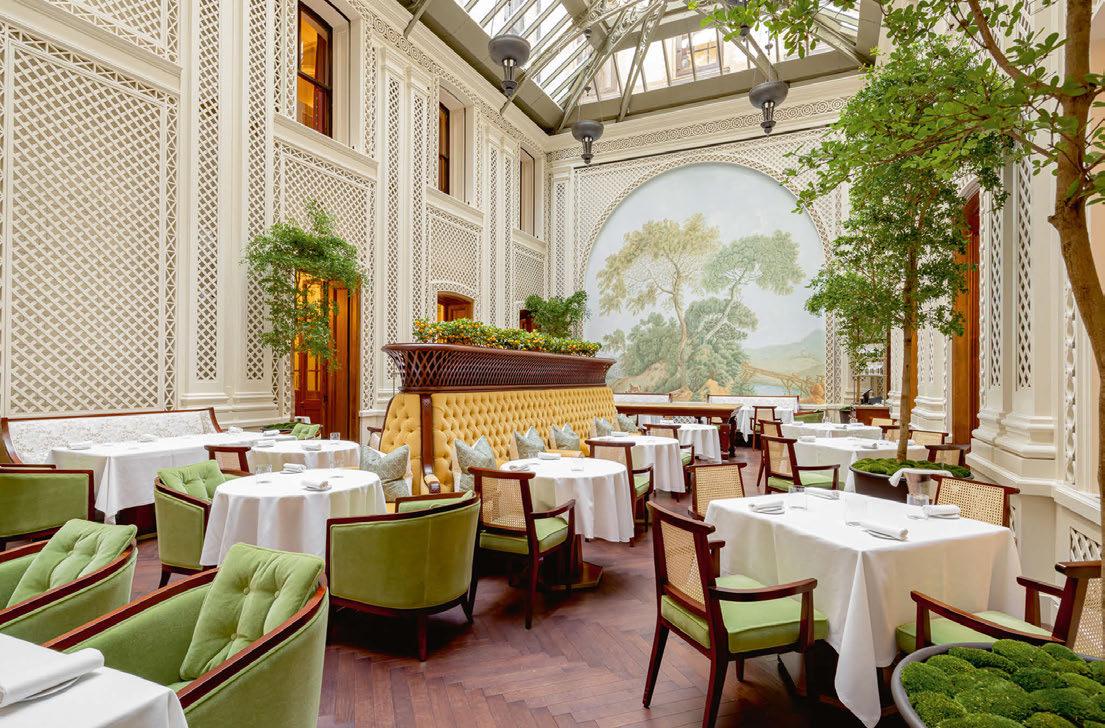
Dishes at Mauro Colagreco’s signature restaurant are a love letter to the British country garden, while Saison (above) is a more casual affair occupying a courtyard beneath a restored glass arcade. Throughout the development, the leadership team has been savvy in selecting OS&E that is both functional and aesthetically pleasing, such as the versatile Moove tables from Meveca
Of Colagreco’s other venues, Mauro’s Table is an intimate chef’s table experience for up to 20 diners, while Saison is a more casual affair, occupying a courtyard space beneath a restored glass arcade. A fresh take on the traditional all-day brasserie, its interiors are characterised by greenery, a large-scale mural and latticework screens, while the cuisine tours the Mediterranean with dishes such as beetroot salad, sea bream carpaccio and line-caught Cornish turbot served with capers, fennel and citrus beurre blanc.
Aside from Colagreco’s venues, for the health conscious, there’s Pillar Kitchen – part of the vast Pillar Wellbeing Club and Guerlain Spa designed by Goddard Littlefair. The menu here has Michelinstarred backing too, having been curated by Culinary Director Jason Atherton to fuel mind and body. Vegcentric dishes packed with whole grains, fibre and pre- and pro-biotics are accompanied by fresh juices, fermented tea and heady shots of ginger and turmeric, with guest favourites including chia seed coconut yoghurt, kelp noodles and peanut protein balls.
Of the bar venues, The Guards Bar sits in an enviable spot within one of the rounded pavilion corners of
the historic building, overlooking the Household Cavalry that stand guard on Whitehall. As such, the design scheme honours The OWO’s long association with the Great British institution, taking cues from the signature uniforms of the guardsmen, with rich red fabrics and bronze accents accompanying floorto-ceiling oak panelling and striking chandeliers. The drinks programme is equally impressive, with Head Bartender William Campbell-Rowntree creating a vibrant selection of cocktails that focus on the bestof-British ingredients, highlighting small-scale local brands or inspired by the locations of other Raffles hotels around the world. Naturally, the legendary Singapore Sling is on the menu, and there’s an exclusive London Sling too, made using Sipsmith Raffles 1915 Gin, cherry bitters and London honey.
The hotel has also enlisted the expertise of Alice Taraschi, who joins as Bar Manager following stints at Claridge’s and Artesian. Taking the lead on partnerships, her achievements at Raffles include collaborations with the likes of Eco Spirits and Nc’Nean to reduce the carbon footprint of the supply chain and champion organic, sustainable spirits. Further
046
© Justin de Souza

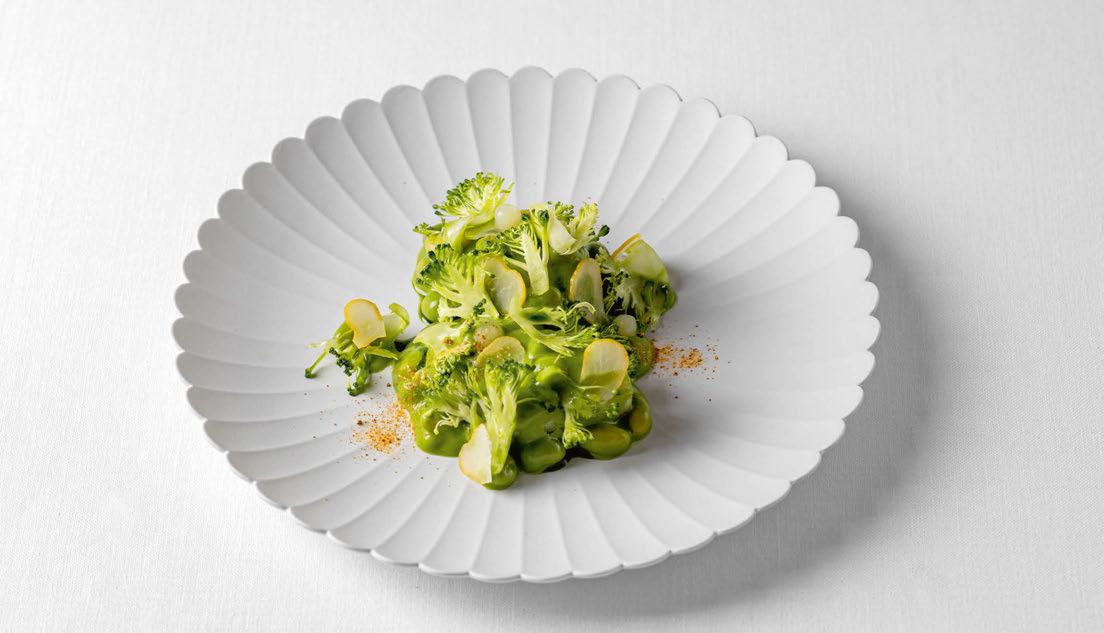
MAIN COURSE 047 © Justin de Souza © Justin
de Souza
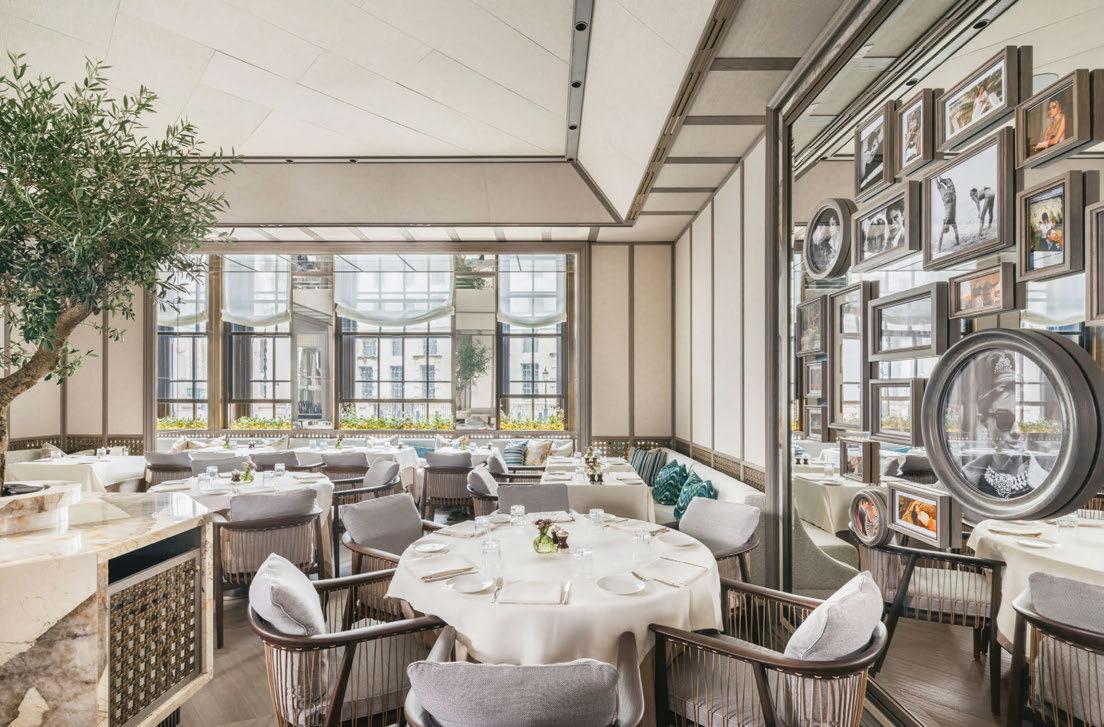
partnerships include a world-first from Louis XIII; the French cognac house offers a by-theglass pour from a 6L crystal decanter, which itself is housed in a tailor-made trunk.
Down below, deep in the bowels of the building, a secret speakeasy is open to those inthe-know. Accessed through a back-of-house corridor – intentionally spartan to enhance the clandestine nature – The Spy Bar pays homage to the military intelligence spies whose secrets were guarded by the walls of The Old War Office. It’s strictly a no-cameras-allowed experience, so only those who have cracked the code and been lucky enough to step inside know of the Bond-style adventures that await.
Outside of the Raffles-operated venues, the wider development features four further F&B destinations that have been carefully selected by the owners. Making its London debut is Café Lapérouse, a more accessible take on the legendary Parisian institution Lapérouse. With a history that traces back to the 1700s, the modern incarnation opened at Hôtel de la Marine in
2021, and has since garnered a loyal following for its French fare and photogenic interiors. At The OWO, the Moma Group venture is equally striking. Though part of the restaurant occupies a grand salon in the main building, visitors will likely first encounter the contemporary pavilion that sits in the central courtyard. Designed by DaeWha Kang in the form of a glass structure beneath rippling polished mirror, the sculptural installation is intentionally at odds with the heritage building, creating a juxtaposition that speaks to the past and future. Like the Paris outpost, interiors are by Cordélia de Castellane – best known for her work with Dior Maison –and feature a rich tapestry of colour, shape and pattern. Think geometric prints, scallop-back chairs and a central bar adorned with seashells. And for the cuisine, French classics such as escargots de Bourgogne, sole meunière and the famous gratinées des halles onion soup are served on the all-day dining menu, along with meatier dishes of filet château and côte de veau.
In another first, The OWO also secured the
first UK outpost of Paper Moon, introducing the Milanese brand to a new audience. Following expansion in the Middle East and Asia, the prospect of a London presence proved too good an opportunity to miss, and so co-owner Claudio Bertoni set the wheels in motion, enlisting AB Concept to create the interiors. Having worked with the family-run group on restaurants in Milan and the Algarve, the design studio was familiar with the Paper Moon promise of providing honest Italian cuisine in a relaxed and welcoming environment. “We set out to create a design that speaks to the restaurant’s Milanese roots yet is adapted to the majestic building of The OWO,” explains Ed Ng, co-founder of AB Concept. “As such, the design concept centres around inviting guests into the warmth of an Italian home within an Edwardian setting. With a tonal colour palette, we have used the finest of Italian fabrics, furniture and techniques to create a textured and ambient dining environment.”
The space is divided into three areas beginning
MAIN COURSE 048
©
Tom Parker
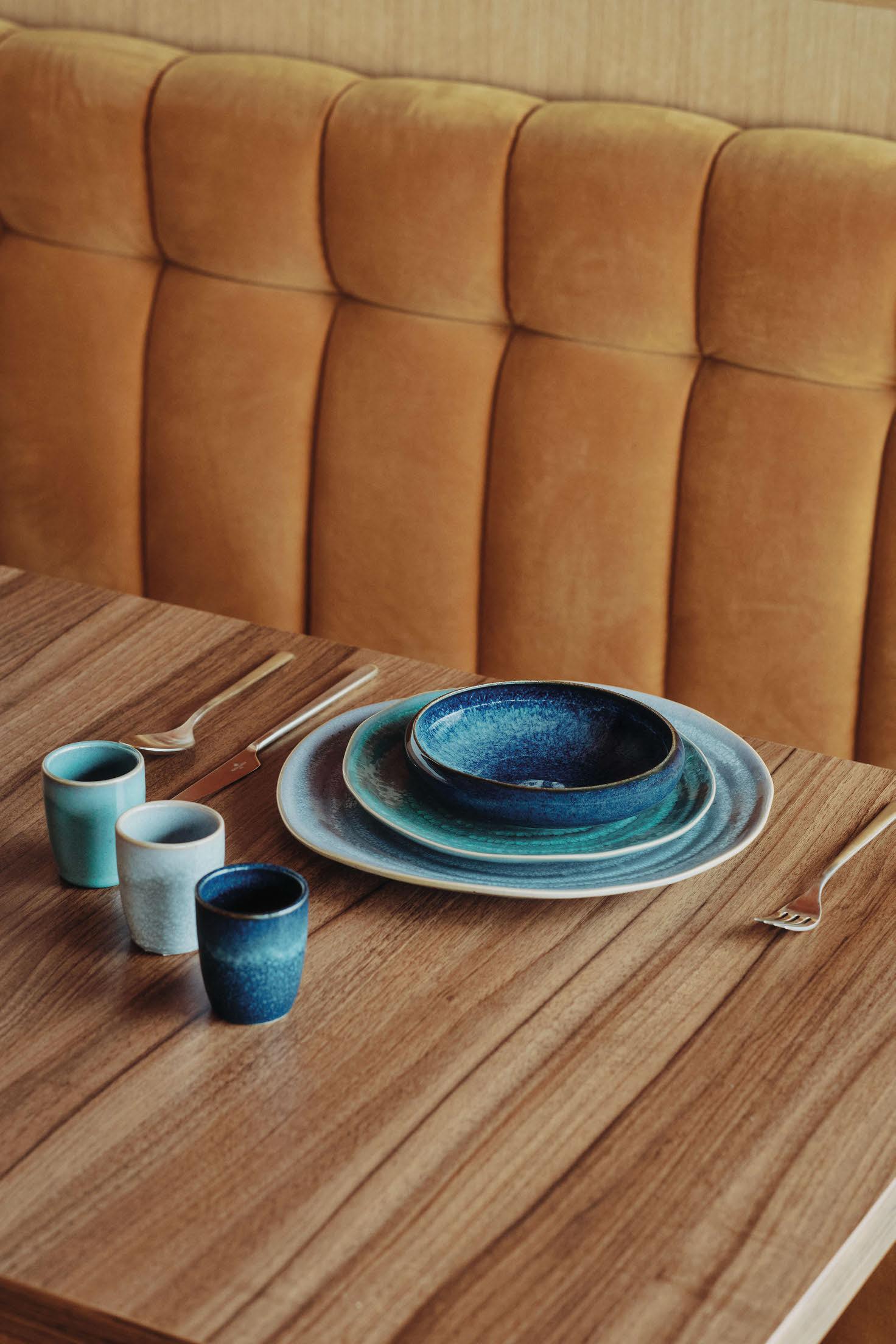
GEMSTONE
Available in Jade, Lapis Lazuli, Moonstone and Coral colors, characteristic of semiprecious minerals, the Gemstone collection is fascinating due to the surprisingly irregularities of stoneware. This is a set which enhances the mix & match thanks to its organic shapes and its sober and versatile shades.
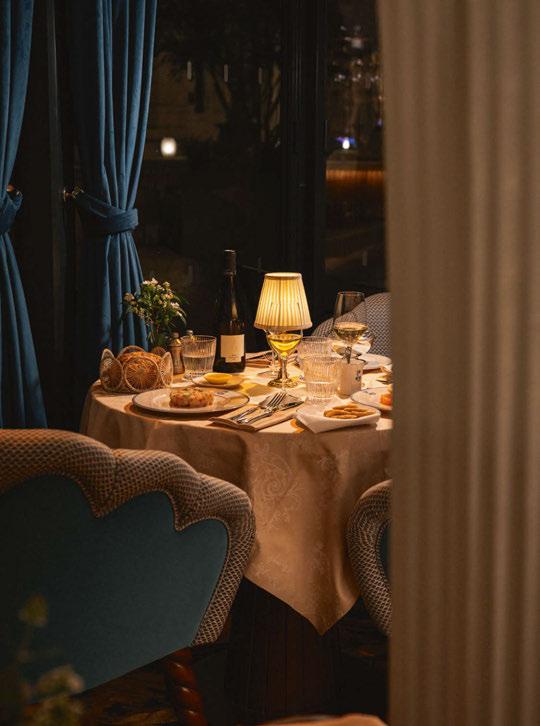
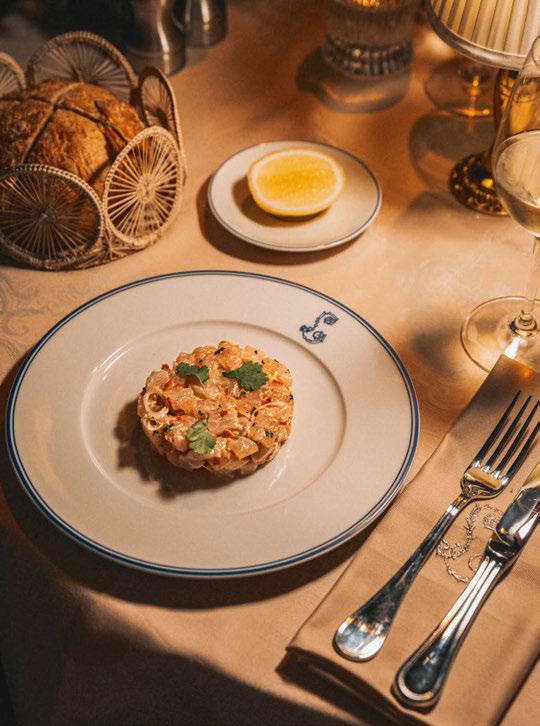
with the foyer, where walls are lined with framed prints of famous movie scenes; despite the familiarity of the subjects, the gallery is reminiscent of a family-home hallway, instantly setting the scene for within. In the bar, a natural quartz counter and sensitively restored alcoves clad in mirrored mosaic tiles create an elegant setting for a pre-dinner aperitivo, while the main dining room oozes understated luxury, with tactile wallcoverings, wool upholstery and brass lamps set around a central statement tree.
And the OWO still has a few more culinary tricks up its sleeve. Opening imminently is Kioku by Endo, a Japanese concept from sushi master Endo Kazutoshi, Culinary Director of Creative Restaurant Group. Building on the success of his eponymous omakase experience in London’s White City – awarded a Michelin star within six months of launch – the new offer combines Japanese technique with Mediterranean flavour, the latter influenced by the chef’s culinary journey through Spain. Speaking prior to the opening, Endo explains: “Kioku, meaning
memory, will combine all the experiences and events I have encountered throughout my personal and professional journey. It is a reflection of my life and the passion I developed throughout my travels in Yokohama, Tokyo and Spain; the moments that resonate with me will influence what I will bring to The OWO.”
The venue comprises a 55-cover rooftop restaurant and outdoor terrace, as well as an intimate cocktail bar modelled on traditional Japanese listening bars, where guests can play vinyl on a bespoke record player as they sip rice wine selected by Sake Samurai Natsuki Kikuya.
The final addition to the line-up, coming later in 2024, is Langosteria, a fine-dining Italian founded by Enrico Buonocore. From his Milan flagship, the restaurateur will bring favourites such as the Catalan-style langoustine, smoked spaghetti with rock lobster and Amalfi lemons, and the popular spillo squid served ‘all’assassina’. It promises to be a suitably cosmopolitan finishing touch for this tasteful reworking of a grand old classic.
IN A BITE
Owner: Hinduja Group
Development Manager: Westminster Development Services
Operator: Raffles Hotels & Resorts
Architecture: EPR, DaeWha Kang (Café Lapérouse)
Interior Design: The Office of Thierry Despont, Goddard Littlefair, AB Concept, Cordélia de Castellane
Art Consultant: Artiq
Lighting Design: DPA
F&B Consultant: Anna Sebastian
Banqueting Solutions: Meveca, Rewthink www.raffles.com
MAIN COURSE 050
Époques - exclusive novelty 2024
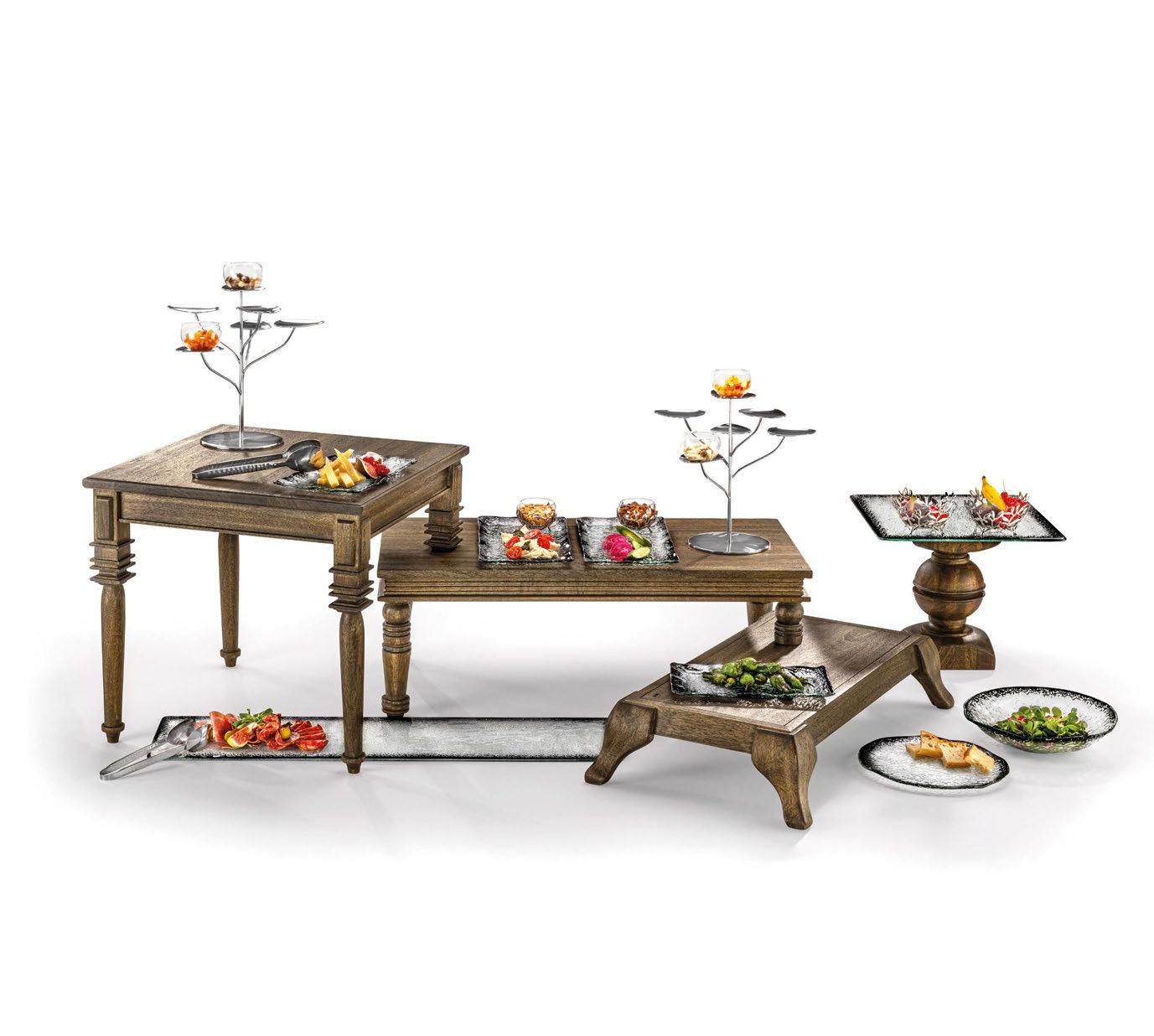

WWW.ZIEHER.COM
The Link One Za’abeel
DUBAI
With 11 culinary concepts and six Michelinstarred chefs, a new F&B hub is poised to revolutionise Dubai’s dining scene.
Words: Shiraz Randeria
Photography: © Neil Corder (unless otherwise stated)
Following the success of Atlantis The Royal’s ambitious F&B programme, Kerzner International is doubling down on its mission to satisfy the Emirate’s sophisticated palates with an expansive culinary destination in the highly anticipated mixed-use development One Za’abeel.
Perched between two Nikken Sekkei-designed skyscrapers housing One&Only’s first urban resort and Siro’s debut is a 230m triple-storey cantilever – the largest in the world – called The Link. Its 11 culinary concepts include venues helmed by six Michelin-starred chefs, from Anne-Sophie Pic and Paco Morales to Mehmet Gürs, Tetsuya Wakuda and Bo.Lan, as well as Dabiz Muñoz.
“Our space in F&B is very luxury driven,” says Daniel Follett, Kerzner’s Global Director of Restaurants & Bars. “So we had to find the right chefs at the right point in their career, either up-and-coming stars of the future or well-established chefs who are exclusive to us in Dubai.”
In addition to the culinary cachet, the general design was of equal importance to the endeavour, so the company enlisted a quartet of global firms to bring the gastronomic hub to life: New York’s Rockwell Group, Denniston in Kuala Lumpur, Dubai-based LW Design and Social F+B in Singapore.
While access to The Link is clearly an attractive part of the hotel experience for guests at One&Only and Siro, Follett stresses that it is fundamentally its own destination. “While

052

MAIN COURSE 053 © Rupert Peace


054
Courtesy of One Za’abeel
we always want to give exceptional dining experiences to inhouse guests, we also wanted the energy that comes from outside guests who provide the hustle and bustle – something that’s often missing in hotel dining environments,” he explains. “The Link works as a street in the sky where people can mingle and interact, but it’s very important to us that we retain that positioning in the luxury space.”
The hub’s largest and most conceptual dining space is the acclaimed Finnish chef Mehmet Gürs’ Arrazuna. Conceived and branded by Social F+B in response to Kerzner’s vision for an upscale marketplace spotlighting cuisines from Turkey, the Levant and the Arabian Peninsula, the food hall required someone with an intrinsic appreciation of all three geographies to take the helm. “Mehmet took our base understanding of the 4,000-year legacy of food across Arabia and focused on the regions’ great produce: olive oils, coffees, honeys, caviar,” explains Social F+B’s Global Principal Stephan Brutti. “He takes the traditional and elevates and celebrates it.”
Spanning 100m and holding more than 400 covers, Arrazuna features multiple individual cooking stations, each tailored to incorporate immersive theatre, storytelling and retail into the dining experience. A veritable feast for the senses, the venue spotlights flatbreads, baklava, vegetables and meats, with drinks stations including a rosewater still and juice bars. Dune-like wooden canopies and pockets of leather seating throughout lend the space a sense of intimacy, despite its square footage. Arrazuna also functions as a gourmet market that sells cookery books, teas and ingredients, in addition to housing Dubai’s only hotel-based licensed wineshop.
Putting a sufficiently refined spin on the traditional food hall experience to meet the expectations of luxury hotel guests required a strong understanding when it came to addressing everything from materials and packaging to local culture. “As a food hall, it’s upmarket enough for guests to
come for dinner and relax with a great bottle of wine for a couple of hours as opposed to the feeling that this has to be a fast experience,” notes Follett. Rockwell Group, meanwhile, was responsible for designing four smaller destination restaurants, each run by Michelinstarred chefs. While each one differs in concept and execution, the venues share the same exterior architecture. “We needed to create a common thread for these four restaurants and ensure that we were celebrating the views of downtown Dubai,” explains Partner and Studio Leader Greg Keffer. “The Link’s column-free spaces are supported by an exterior cross-bracing structure and we carried this ‘X’ motif throughout the interiors.” To this end, a familiar palette of materials appears at key locations in each restaurant to create a throughline: textured metal and leather details, wooden flooring at entrances and bars and custom diamond-shaped textured glass feature throughout. To define the individual spirit of each eatery, and craft the narrative of its culinary origins and features, the chefs stepped in with their own suggestions.
At DuangDy by Bo.Lan, for example, the husband-andwife chef duo Duangporn ‘Bo’ Songvisava and Dylan Jones wanted to pay tribute to the traditions and origins of Thai cuisine while demonstrating a commitment to sustainability.
Billed as ‘an expression of rural Thailand’, the restaurant’s menu is described by the chefs as “Thai food faithful to its roots”. “We use a lot of old recipes with a contemporary approach to presentation,” they explain. “We want to introduce regional tastes and dishes to our guests, including elevating pungent and spicy flavours such as shrimp paste, to show that Thai food can be fine dining.”
A business-wide focus on ‘eco-gastronomy’ that the chefs and Kerzner claim is new to Dubai drives every decision, from selecting the material of the menus – “we used a plant from the pandan family, dried in a durable and beautiful way” – to stipulating a preference for as much reclaimed
MAIN COURSE 055
Amongst The Link’s 11-venue assemblage is souk-inspired food hall Arrazuna (top) and Thai DunagDy (bottom)
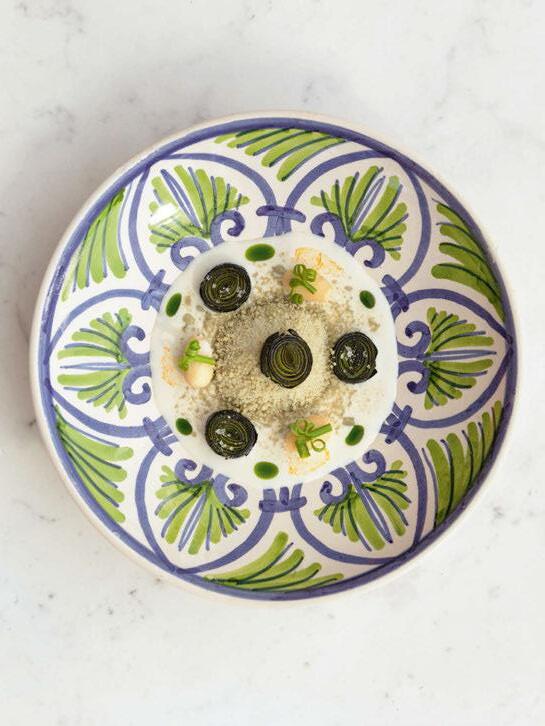
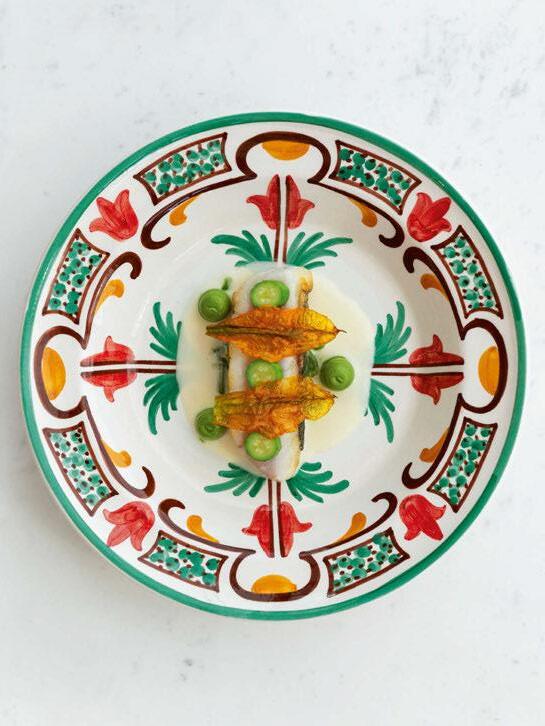
wood and fabric as possible in the interior design. Provenance is also paramount when it comes to the kitchen’s ingredients, with the team sourcing as much as possible locally. “We also have a kitchen waste management programme and a philosophy of zero waste to landfill, which means upcycling or composting,” the chefs explain. One example of this approach is DuangDy’s craft cola, which takes two days to make, using the syrup from spent coffee, used limes and Thai basil stalks. “Everything we’re doing is a process for us and our team and with each step we find ways of improving and showing how fine dining can be ultra-sustainable,” the duo concludes.
Another example of Dubai’s niche fine-dining evolution is Qabu, the Middle Eastern transplant of Spanish chef Paco Morales’ three-star Córdoba restaurant Noor. “I’m trying to add a cultural ingredient to the dining experience,” says the chef of his didactic approach to introducing dishes and wines from Al-Andalus to Dubai for the first time, highlighting centuries of Moorish culture and Iberian cuisine for a new international audience.
In terms of design, Qabu excels in both grand
statements and small details. “Rockwell created a warm atmosphere, lit like a stage, and with our central cupola we use the restaurant as a temple of history and culture,” explains Morales. Keffer elaborates: “The focal point is a deconstructed dome in thin wood elements that contains a dark crystal chandelier. The floor underneath features a theatrical, sculptural millwork piece that captures the drama of chef’s mission.” Morales’ laser-sharp attention to detail even extends to the tablescapes, with the chef going so far as to design and create certain elements of the tableware himself, including plate and glass coasters and cork holders. “I use 3D printing as a tool to express our design soul, because for me design isn’t only the cooking,” he says. “It isn’t usual to serve dishes in very colourful plates, but here all our servings are colourful. At Qabu, you have to observe and be attentive.”
Another headline European-inspired billing comes courtesy of the renowned French finedining establishment La Dame de Pic. Helmed by Anne-Sophie Pic – the most decorated female chef in the world – the avant-garde restaurant’s first
MAIN COURSE 056
At Qabu, Paco Morales adds a finedining edge to the Moorish cuisine of Andalusia with dishes presented on 3D-printed tableware

Timelessly elegant, simple and beautiful. nudeglass.com

Middle Eastern outpost brings modern French sensibilities and innovative flavour pairings to the fore via a series of elaborate degustation menus featuring dishes such as roasted guinea fowl perfumed with hojicha and Atlantic crab infused with sobacha, as well as her signature ‘les berlingots’ pasta parcels.
Exuding elegance and femininity, the interiors are characterised by pastel pink and cream leather seats with a marble bar and rose gold accents, while an open kitchen invites diners to participate in the theatre of the experience. “At La Dame de Pic, lighting was enormously important,” explains Keffer of Rockwell’s design scheme. “The dining room is grounded under a custom, monolithic light feature with a floral design and metal mesh and faces an open show kitchen.”
The Link’s stellar F&B line-up is further bolstered by The Garden, a secluded dining oasis in which the eminent Spanish chef Dabiz Muñoz presents his unique take on street food, bringing the vivid flavours of Indonesia to life
in another dramatic open kitchen. Meanwhile, both StreetXO and Andaliman, envisioned by LW Design, commend the specific luxury of the urban resort experience. “The Link restaurants are focused on celebrating the views of both old and new Dubai, as well as the engineering marvel of floating above a highway between two buildings,” explains Pooja Shah Mulani, Partner and Design Director at LW Design. “The Garden is an escape designed to blur the sense of its physical location and celebrate diversity in the centre of the city.”
The unique views afforded by The Link’s privileged location – it is really the only place offering a perspective on both Dubai’s highrise skyline on one side and the historical Deira district on the other – are an indisputable boost to One&Only’s offering for its first urban resort. Kerzner’s attention to detail and design execution assists the brand in smoothly and stylishly expanding its market presence into a glittering vertical and horizontal city setting that looks as good as it tastes.
IN A BITE
Owner:
Investment Corporation of Dubai
Operator: Kerzner International
Architecture: Nikken Sekkei
Interior Design: Rockwell Group, Denniston, LW Design, Social F+B
Chefs: Anne-Sophie Pic, Paco Morales, Mehmet Gürs, Tetsuya Wakuda, Bo.Lan, Dabiz Muñoz
Tableware: Renarte (select outlets) www.onezaabeel.com/the-link
MAIN COURSE 058
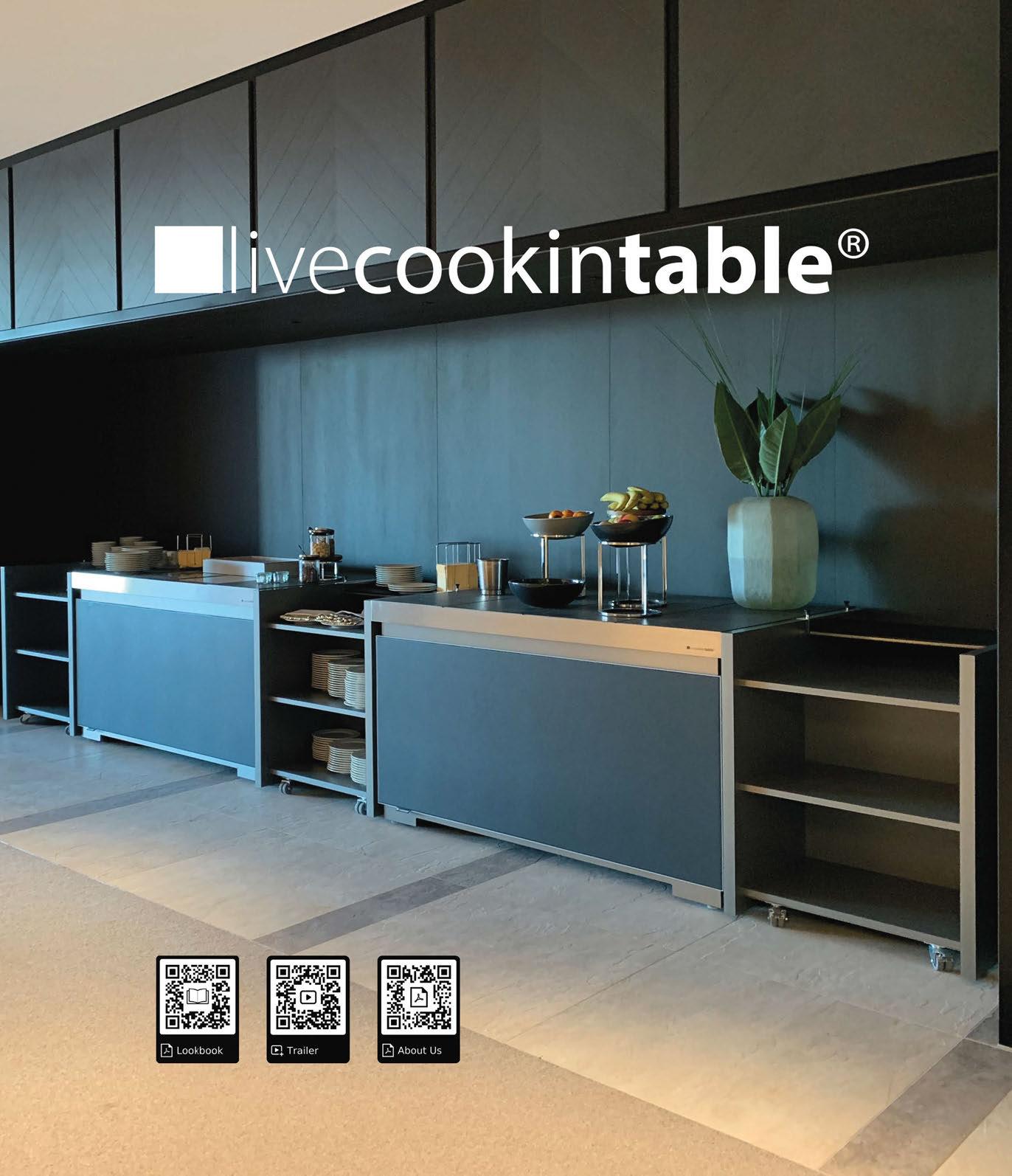

Pillows Hotels
THE NETHERLANDS
A Dutch portfolio of boutique hotels is taking the Netherlands by storm with its renewed culinary focus.
Words: Eleanor Howard • Photography: © Chantal Arnts (unless otherwise stated)
Born in 2017 from Dutch management group Amerborgh, Pillows Hotels is an intimate portfolio of residentialstyle boutique properties in the Netherlands and Belgium, with a strong emphasis on gastronomy. In fact, many of their restaurants have been commended by Michelin or Gault Millau.
“Pillows Hotels has grown, focusing more on food and beverage, especially fine dining in an easy-going setting, which has become increasingly important,” explains CEO Loes Dingemans. “This is because offering exceptional dining experiences enhances the hotel’s reputation, attracts guests and boosts overall satisfaction. Looking ahead, it’s crucial to continue prioritising F&B excellence to maintain our brand’s reputation and stay competitive in the evolving hospitality industry.”
Nowhere embodies this approach more than Pillows Grand Boutique Hotel, Maurits at the Park, in Amsterdam Oost. Occupying a former University of Amsterdam medical laboratory, the five-star hotel bears all the hallmarks of a Pillows property: a historic building, residential design scheme and a carefully-curated art collection, as well as elevated gastronomy courtesy of the Spring Brasserie, the Roaring Twenties-inspired Fitz Bar helmed by Dutch IBA World Cocktail champion Nick Vrielink, and the fine-dining restaurant VanOost.
Following an original staircase lined with stained glass windows, guests reach the former museum hall, which has
been reimagined as an industrial dining room. Original wooden vaults and 15m-high ceilings are contrasted against a contemporary open kitchen where diners can soak up the theatre of Floris van Straalen’s creative cuisine, using local ingredients to produce innovative flavour combinations from around the world.
Before being named New Chef on the Block by Gault Millau and receiving an impressive 14/20 just four months after VanOost’s debut, van Straalen honed his culinary chops volunteering at Michelin-starred restaurant Linnen and working at renowned restaurants such as Oud Sluis, Pure C, Vinkeles and Envy. “My style is to be innovative with flavours and technique,” he reflects. “Daring to use seasoning on high profiled dishes throughout the menu but also keep the ‘flow’ nice and balanced throughout the experience. The influences come from all over the world, and we try to use local ingredients in preparing them.”
The eight-course tasting menu kicks off with Asianinspired welcome bites, from Thai Terong Balado to an elevated interpretation of Takoyaki, the Japanese street food snack of battered octopus balls. What follows is a stimulating sequence of dishes inspired by nature’s bounty through the seasons including the chef’s favourite – glazed langoustine accompanied by spicy carrot and a lemon verbena sauce served tableside with liquid nitrogen. “The spice and sweetness and acidity is really the unami flavour that makes it special,” he notes.
060

MAIN COURSE 061
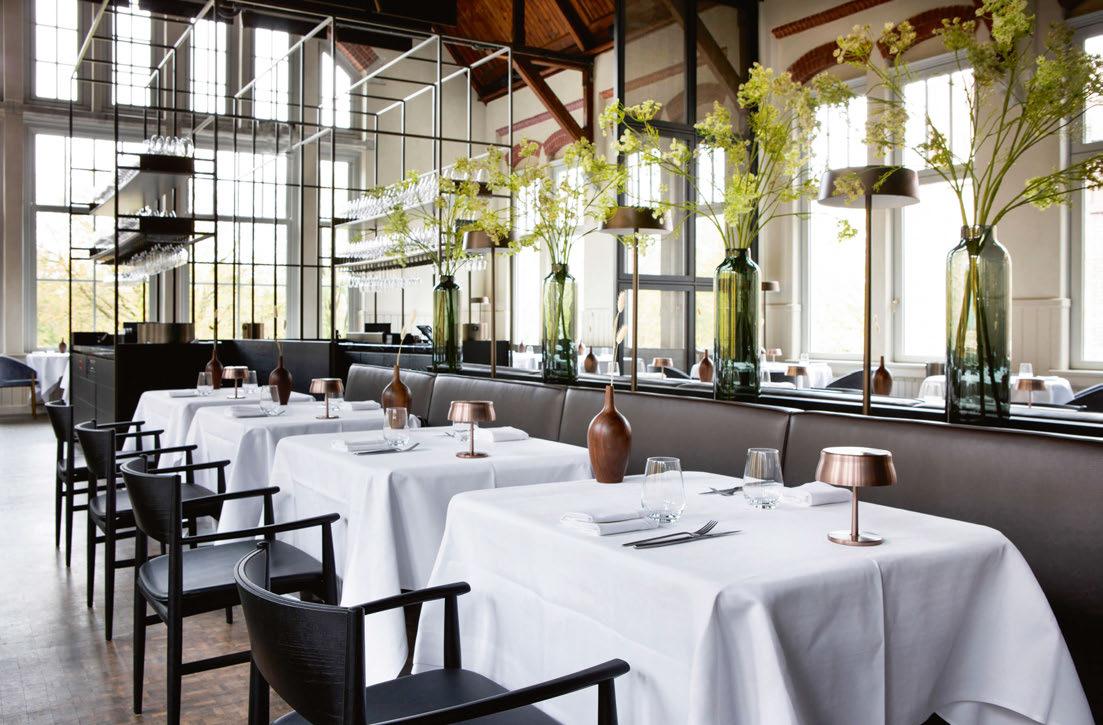
Presentation forms a core pillar of the dining experience at VanOost, and that comes directly from van Straalen. “The plating and presentation is really important for me,” he states. “Before we opened VanOost, we spent almost a year searching for and selecting our plates and cutlery in different places. I looked at the materials inside VanOost and wanted to mirror them in our plating,” he explains. For example, fresh Japanese milk bread is presented on a Studio Mattes walnut plate reminiscent of the wood-panelled ceiling overhead, while dehydrated beetroot is served on a glass craquele plate in a nod to the vast windows that line the room looking out over Oosterpark. “I think the overall experience doesn’t need to stop at the plate, but each needs to make each other better and embrace one or the other,” he adds. “This makes your restaurant one of a kind and will be the reason guests come back because they like your style and it makes you stand out from the rest.”
Standing out from the crowd was clearly
on the agenda for Pillows with regards to its latest acquisition: Inter Scaldes, a storied Dutch restaurant with rooms, located near the Belgian border in Zeeland. The property is steeped in history; under the ownership of Kees and Maartje Boudeling, the restaurant received its first Michelin star in 1978 with the second following six years later. In 2001, Jannis and Claudia Brevet purchased it, elevating the venue to new culinary heights with a rare third Michelin star, making it the fifth Dutch restaurant at the time to receive such critical acclaim. Late last year, renowned Dutch chef Jeroen Achtien and his wife Sanne took over, ready to breathe new life into the property with the help of Pillows Hotels.
“The acquisition of Inter Scaldes, one of the top restaurants in The Netherlands and Europe, highlights our company’s focus on excellence and its long-standing commitment of offering one-of-a-kind culinary experiences,” reflects Dingemans. “We were drawn to its blend of culinary excellence and luxurious stay, which
062
Floris van Straalen presents his creative cuisine in an open kitchen overlooking an industrial dining room with original wooden vaults and soaring ceilings
Courtesy of Pillows Hotels
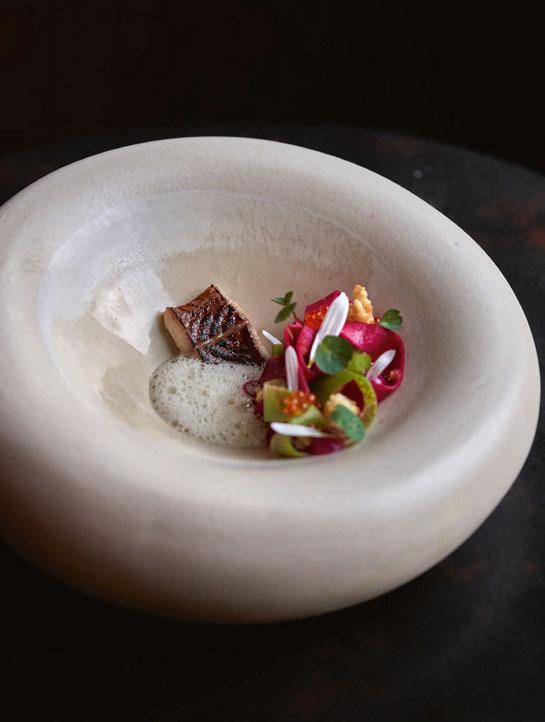

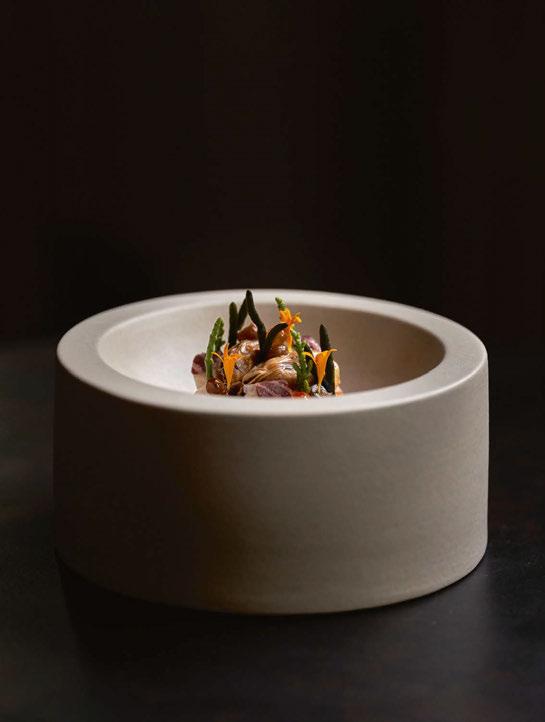
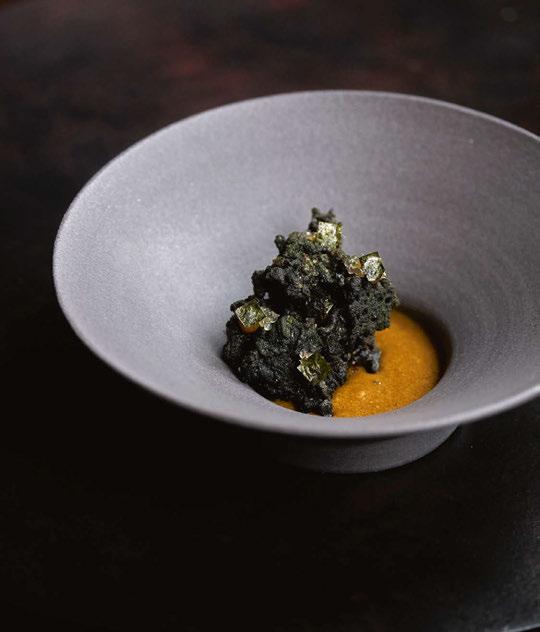
MAIN COURSE 063 Courtesy of Pillows Hotels
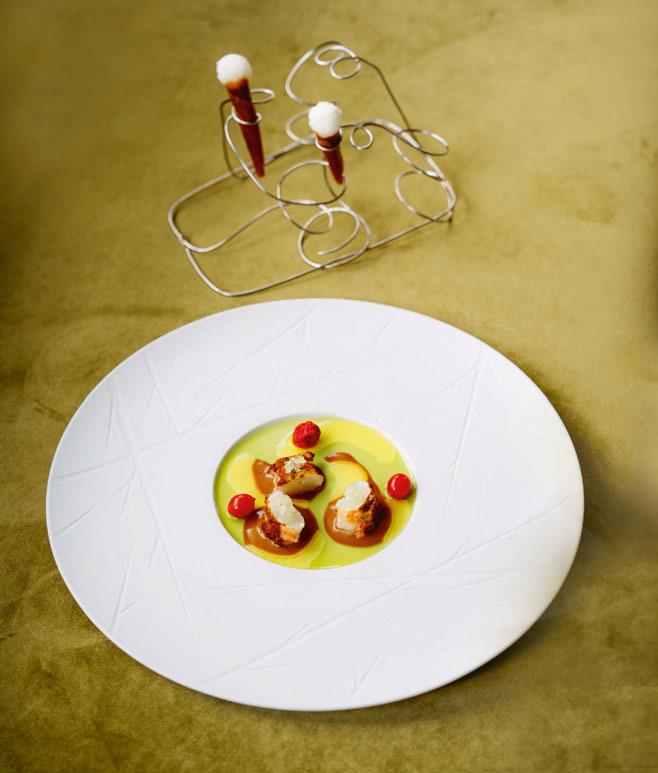
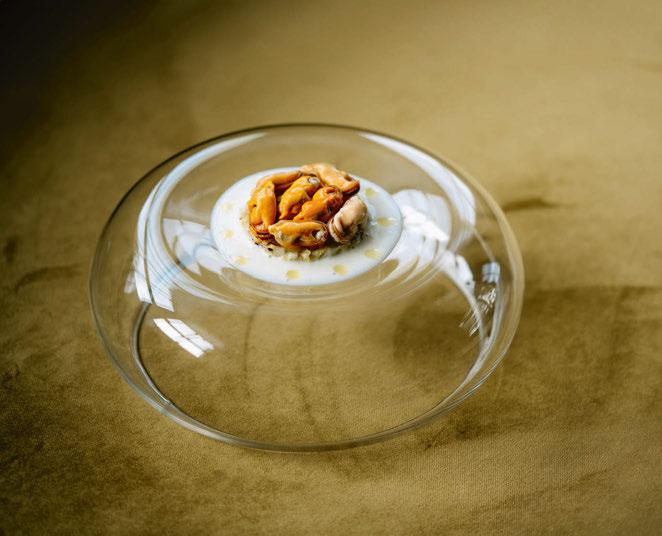
Rooted in Zeeland’s terroir, Achiten’s creations evolve with the seasons whilst constantly showcasing his passion for fermentation, drying and ageing
aligns well with what Pillows aims to offer guests. Additionally, its serene location in the Dutch countryside adds to the appeal, providing a tranquil retreat for travellers. Overall, Inter Scaldes’ combination of great food, a luxurious and warm atmosphere, wonderful interior and scenic surroundings make it an ideal addition to the Pillows portfolio.”
The first order of business for the husbandand-wife duo was altering the restaurant layout to bring the chef and diners closer together. Envisioned by Paul Linse of Linse Studio, which also designed Maurits at The Park, the interiors now allow guests to enjoy an aperitif and a selection of appetisers in the lounge before passing through to the kitchen, where the chefs prepare a dish for them to consume while standing and watching. Afterwards, diners take their seats in the dining room for the main event.
“From the versatile colour palette to the lush forms of the natural environment, everything has been carefully considered to capture the feeling of Zeeland,” explains Linse. “The foundation of the interiors are the velvety soft blue sofas, inspired by the waving shape of the Scheldt river.”
Not only is the fluid design scheme an allusion to the nearby bodies of water, it is also a signifier
064 MAIN COURSE
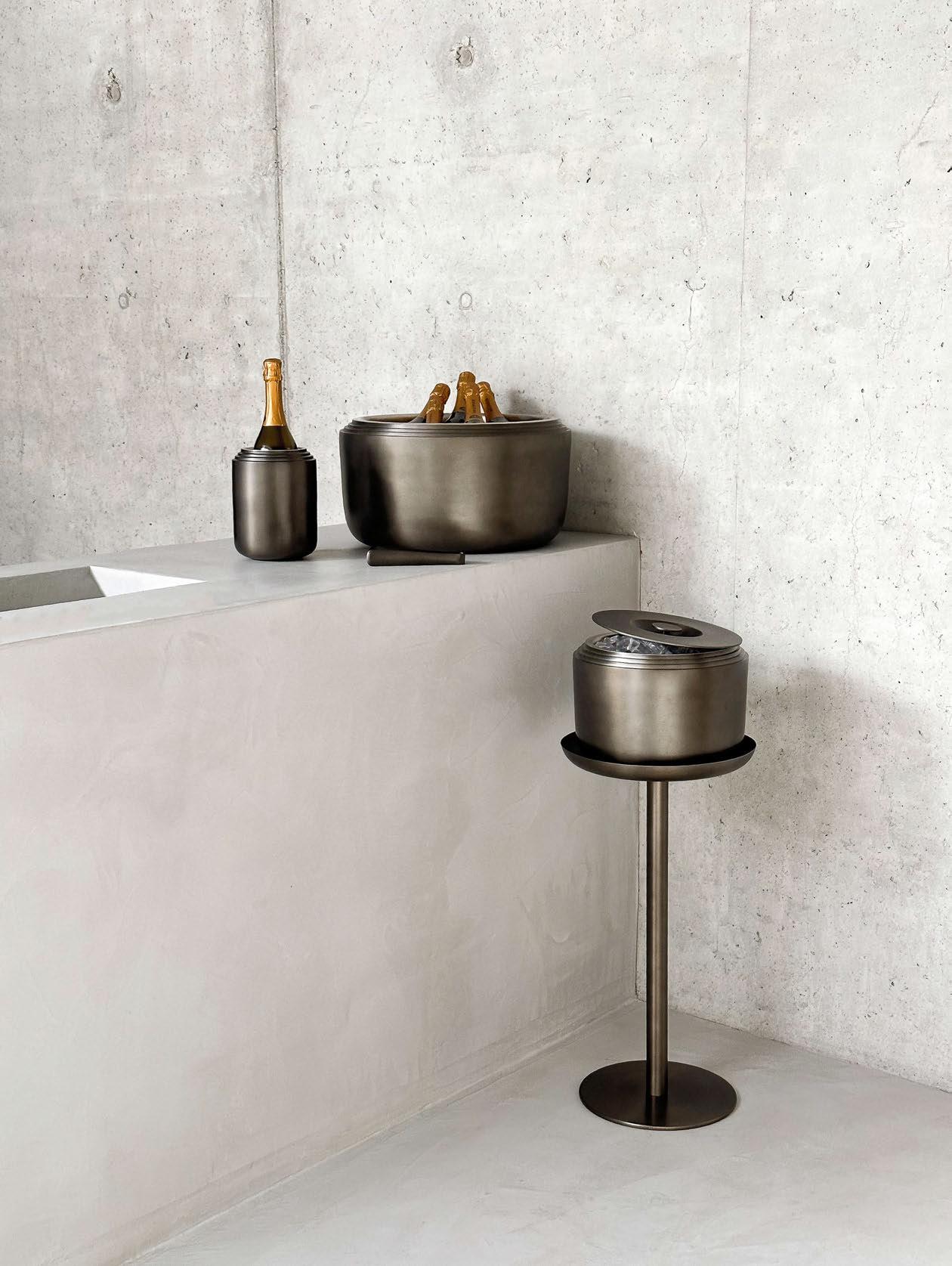


www.xlboom.com info@xlboom.com +32 3 213 50 20 @xlboom
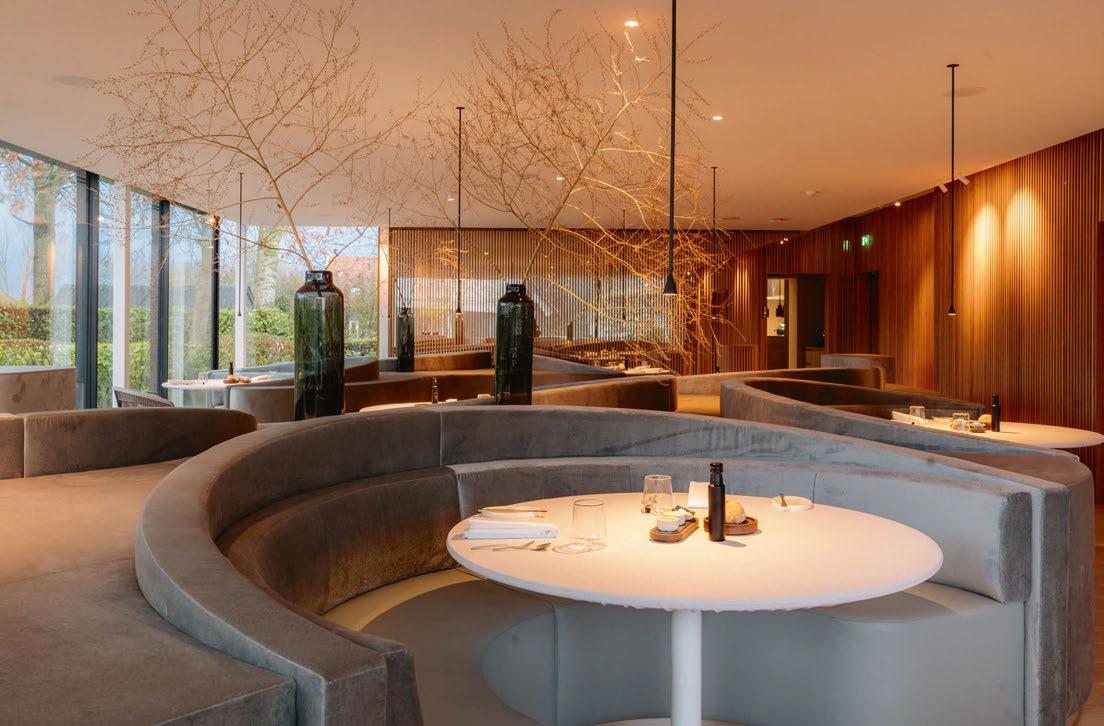
of what is to follow on the menu. Renowned for championing local and sustainable ingredients, Achtien elevates produce from the surrounding region with his skilled fermentation, drying, and ageing techniques. “Zeeland stands for seafood, fish and seaweed, as well as fruit. The place is full of them,” explains Achtien. It follows, then, that everything from Yerseke dry-aged seabass and Oosterschelde lobster to Dodewaard saibling and North Sea sole has appeared on the menu. “With these local ingredients, you create a taste that stands out and suits the environment. The flavour is also at its best when it is in season.”
In addition to fish, Achtien has made a concerted effort to showcase some of the Netherlands’ finest cuts of meat, such as Dutch Simmental beef matured for 10 weeks. In fact, his favourite dish is currently Zeeland-reared fallow deer – a main course on the à la carte menu. “The deer is aged in-house for 14 days, potato risotto flavoured with koji, cold salad with cabbage and heavy smoked bacon, black winter truffle,” he explains before highlighting
that lamb will become the star of the show as Spring approaches.
“Honestly I am often a little disappointed by main courses in gourmet restaurants – that’s why we put always a lot of effort in to ours,” he reveals. “A lot of guests from Belgium and the surrounding especially come for our à la carte menu where you will find more traditional main courses, some great caviar dishes and a beautiful cassis-based souffle with a twist.”
Similar attention has been paid to the wine list curated by Sommelier Tessa van de Wouw, with barware and chillers designed by Alain Gilles for XLBoom underpinning the elegance of the fine-dining experience.
And the proof is in the pudding: this year, the revamped Inter Scaldes became the Highest Newcomer of the Year in the Gault Millau 2024 guide, receiving an impressive 16.5 points by inspectors. With five of Pillows’ six hotels boasting critically-acclaimed culinary concepts, the boutique operator has cemented its position as a pioneer in the Dutch culinary landscape.
IN A BITE
Owner: Amerborgh
Operator: International Hotel Management Group
Interior Design: Studio Linse Chef: Floris van Straalen (VanOost), Jeroen Achtien (Inter Scaldes)
Restaurant Manager: Fenna Kentie (VanOost)
Sommelier: Tessa van de Wouw (Inter Scaldes)
Barware: XLBoom (Inter Scaldes) www.pillowshotels.com
MAIN COURSE 066
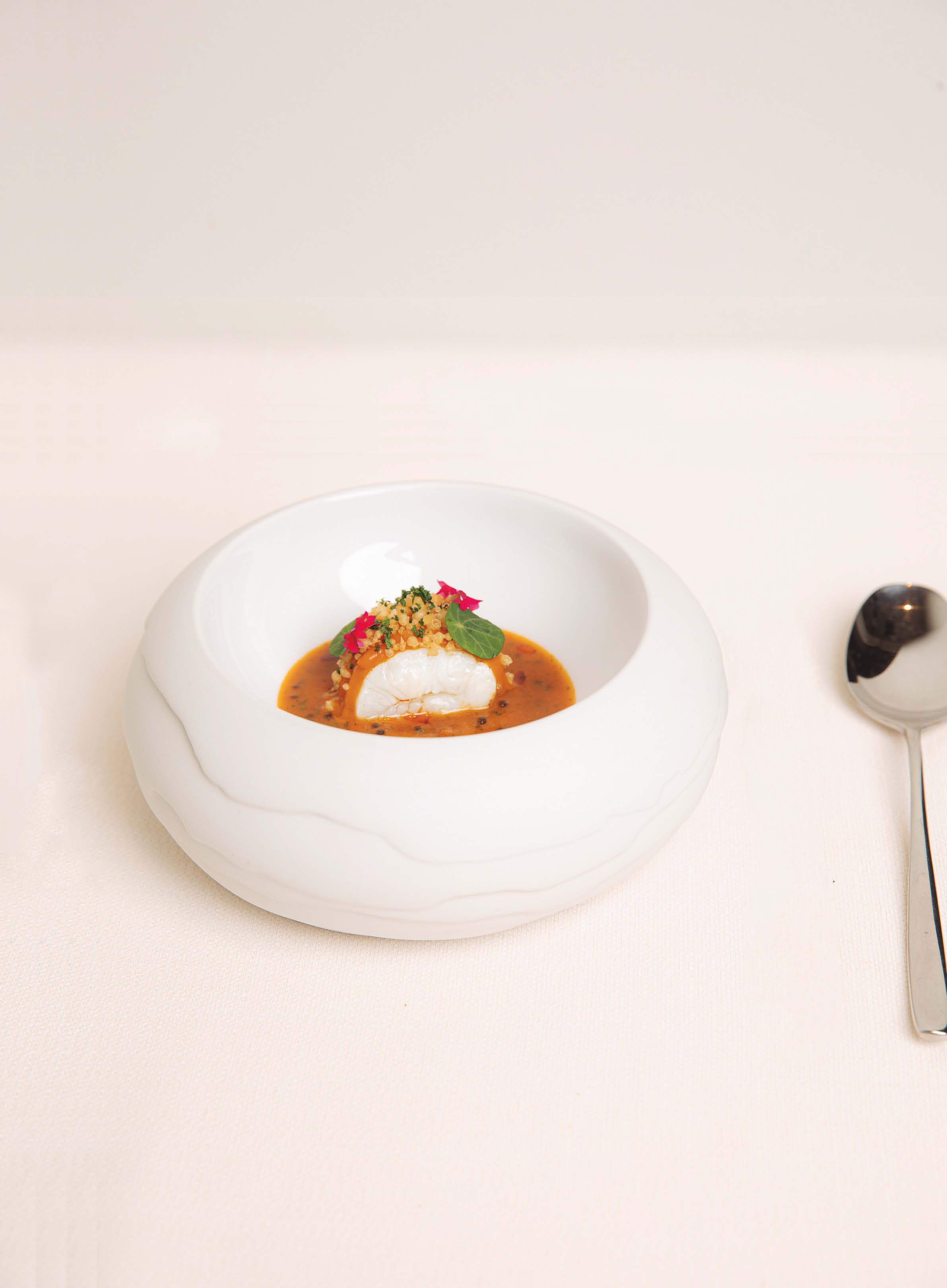
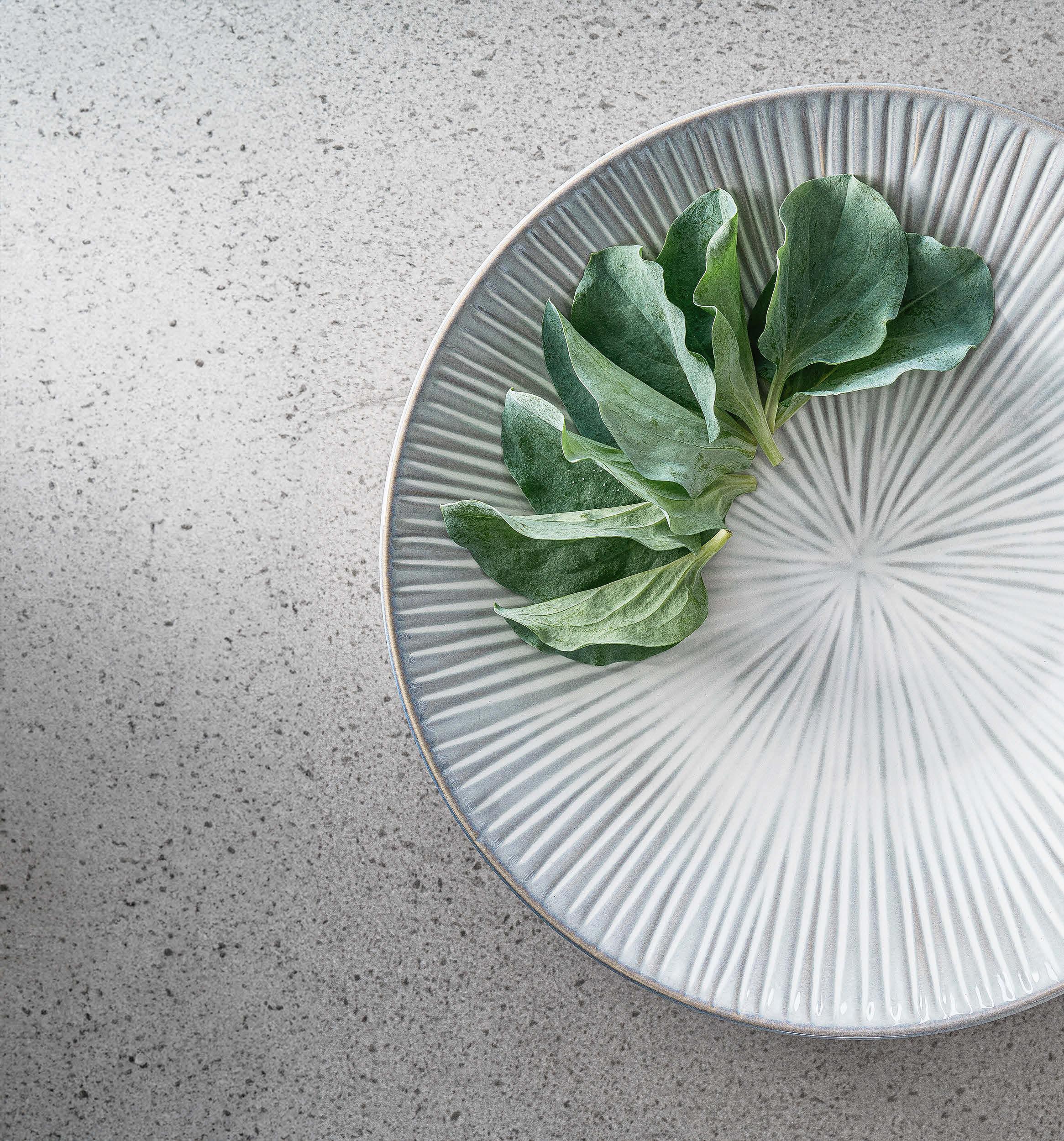


Halo
Visit us at The Hotel Show Dubai! Stand SS2 A92
Cloud.
Piglet, Myrtle and Maritata Soup
Enoteca la Torre
Villa Laetitia
ROME
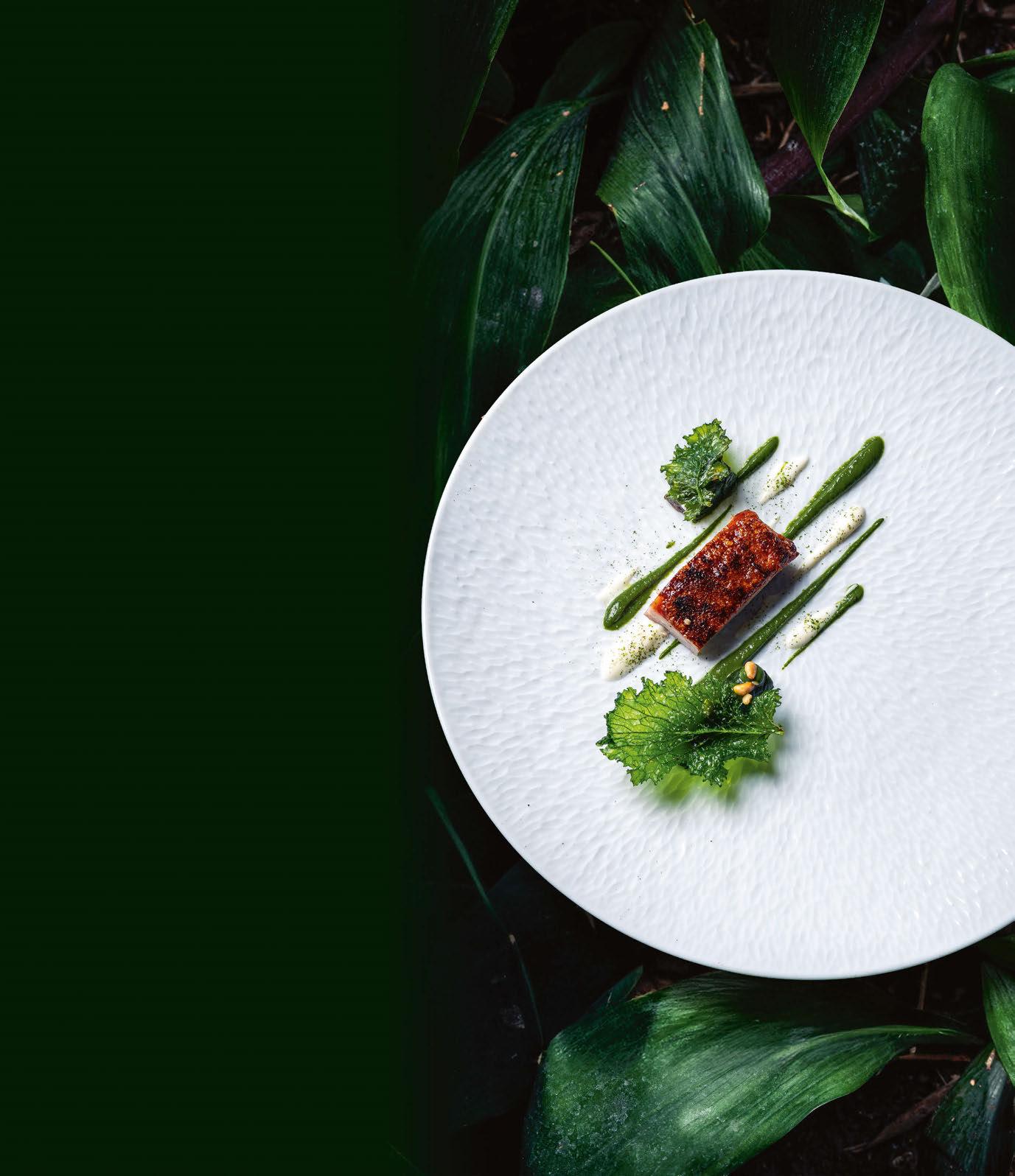
Two-Michelin-starred chef Domenico Stile is putting pork back on the fine-dining map with his Piglet, Myrtle and Maritata Soup. Served at Enoteca la Torre within Villa Laetitia in Rome, the dish recently made an appearance in the Maldives, where the chef took up a week-long residency at The St Regis Vommuli.
“The inspiration for this dish comes from my grandparents, who were passionate about working with pork in its many facets, from classic sausages to delicate salamis in various preparations,” explains Stile. “Given that pork has almost disappeared from fine-dining menus in recent years, I wanted to relaunch it in a more refined and elegant way.”
To prepare, a 12kg Tuscan Cinta Senese suckling pig is deboned and seasoned with chopped lard and fennel, before being sewn up to retain moisture. The pork is then combined with a Sardinian wild myrtle chutney, a provola fondue from Monti Lattari and a cream of minestra maritata made with vegetables grown in Agro Sarnese Nocerino.
“This dish is one of my favourites because I have an emotional bond with it,” Stile concludes. “Its many nuances somehow bring my beloved Naples home to me.”
SIGNATURE
SIGNATURE
 Photo by RAIZ PHOTOGRAPHY
Photo by RAIZ PHOTOGRAPHY
Lightly Smoked Lobster, Seaweed, Bisque
William Reid’s Palace

Heralding the dawn of a new era for Reid’s Palace, newly appointed Executive Chef José Diogo Costa has revamped the menus at the Michelinstarred William, with culinary creations that nod to his global travels, whilst celebrating Madeira’s rich gastronomic heritage. Nothing epitomises his approach more than the Lightly Smoked Lobster, Seaweed, Bisque. “The dish is inspired by my time in the Nordic countries, where fresh products are key,” explains Costa. “It’s important to not overwork them and just take advantage of their richness. The same goes for Portugal and its seafood offering. My aim was to blend the two countries in a single dish, keeping it both fresh and local.”
To prepare, lobster from the Algarve is lightly smoked over a charcoal fire, whilst locallysourced kale is sautéed with cider vinegar and a variety of seaweed species. To serve, the seafood is plated with Madeiran passion fruit gel and a bisque made from shells and shiso oil. “This was actually the first dish I created for William and it has fast become a firm favourite with guests,” Costa concludes. “It is simple yet complex, because we play around with flavour and texture. My personal touch comes in the use of seaweed; it is said that humans will use more seaweed to sustain their diet in the future, so I wanted to introduce it to the menu at William.”
FUNCHAL SIGNATURE SIGNATURE

In The Wild
In response to the growing desire to reconnect with nature, hotels are embracing the great outdoors with dining experiences nestled in the wild.

In today’s vast and varied dining sector, concepts that embrace the great outdoors – such as foraging and fire cooking – are increasingly popular; yet typically, diners tend to sit indoors to feast on the fruits of a chef’s labour. This is not the case at Beaverbrook in the Surrey Hills, which launched
The Wild Kitchen last autumn – a first for a UK hotel.
The invention of filmmaker and barbeque fanatic Guy Ritchie, who wanted to offer bespoke private dining for up to 22 guests, it sits a short stroll from the main house to offer panoramic lawn and forest vistas.
The space – which is raised on stilts and has a fullyretractable canvas roof and roll-up sides – wouldn’t look out of place on safari. Two charcoal grills sit at either end of the long communal table so diners can finish cooking Tomahawk steaks, say, or jumbo prawns themselves; there is also heating and a copper tabletop to keep plates warm.
Menus include ‘Surf & Turf’ by Adam Sharpe, who helms the hotel’s Garden House restaurant, and ‘Nomadic’ and ‘Japanese Wild BBQ’, both by Wojciech Popow, who is in charge of the cuisine in The Dining
Room. “I love to spend my time camping in the forest and cooking over fire so for me, it doesn’t feel so much like work,” says Popow of The Wild Kitchen. “The surroundings are magical; as soon as you step into the tent, you feel the warmth of the fire. It’s a very relaxed experience; dishes are eaten familystyle, there’s interaction with the guests and I wear a sweatshirt with an apron rather than chef whites. I want people to feel that they are out in the woods, rather than in a restaurant.”
For General Manager Jorge De Jesus, the setting adds another layer to the experience. “Many of the ingredients served in The Wild Kitchen are inspired by produce found on the estate, so it makes sense to be immersed in nature while eating them,” he explains.
“You really feel the elements too: when it’s raining you can hear it on the roof and the fire keeps you cosy; when it’s warm and sunny, we can roll the canvas back to enjoy a gentle breeze and nature views.”
Beaverbrook isn’t the only hotel tapping into the growing desire to spend more time outdoors – in fact, trend forecasting agency WGSN has labelled it
DINING
Words: Emma Love
© Courtesy of Wildhive Callow Hall
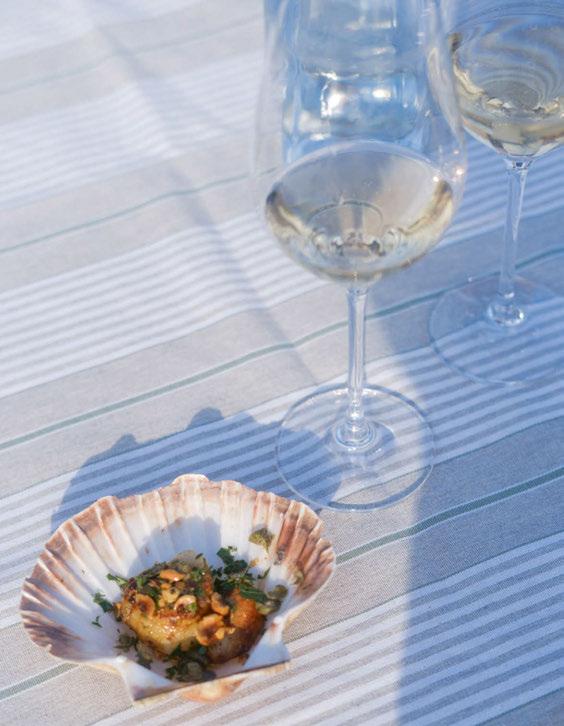

a cross-industry ‘outdoor boom’. At Glebe House, a guesthouse, restaurant and 15-acre smallholding in Devon, activities include breadmaking, mackerel fishing and a vineyard tour, followed by a three-course twilight dinner on the beach. “We started offering mackerel fishing two summers ago after my husband Hugo and I did our own version during lockdown,” recalls Glebe House co-owner Olive Guest. Up to ten guests go out with a local fisherman, while the couple set up a communal table among the fishing boats and start cooking on a Japanese Konro grill.
Starters range from homemade bread and charcuterie to scallops and charred vegetables grown in their garden; the main is mackerel cooked over coals and served with new potatoes, salad and aioli. “We cook whatever has been caught but we also have plenty already bought from the fishermen, just in case,” continues Guest. “When you’re visiting a part of the world like Devon, it’s not only about the room you’re staying in, but experiencing the land in different ways. Hugo moved from cooking in London restaurants because he wanted to be closer to growing and seasonality, and these experiences enhance that.
If you’re eating outside on a beach or in the woods, then you feel more connected to the food and location. The setting, in a picturesque fishing village with a beautiful cove as a backdrop, is quite idyllic.”
Skye Gyngell, Culinary Director of Hampshire’s Heckfield Place, who is behind a series of suppers on the hotel’s Home Farm, agrees that eating amidst nature is increasingly appealing. “More and more people are looking to reconnect with the land and the source of the food on their plate. There’s something very visceral about dining in the midst of the fruits and vegetables you’re being served; all your senses are being nourished,” she says. “As it gets increasingly difficult to disconnect from our busy lives, the ultimate luxury is experiences that bring an opportunity to slow down and be absorbed in the moment.”
The suppers, together with another dining experience that combines a cooking demonstration with a three-course lunch by chefs from the hotel’s Green Michelin-starred Marle restaurant, are aimed at encouraging guests to share in the organic farm and biodynamic market garden in an immersive way. “Part of the joy of our Home Farm Suppers is how embedded
© Holly Fielder
074 DINING
At Glebe House in Devon, activities include breadmaking, mackerel fishing and a vineyard tour, followed by a three-course twilight dinner on the beach

“There’s something visceral about dining in the midst of the fruits and vegetables you’re being served; all your senses are being nourished.”
SKYE GYNGELL
they are in the changing seasons; you might be surrounded by blackberries and sweet peas one month and tomatoes and sunflowers the next. The flowers on the table and the ingredients on the plate will always be those at their peak in that very moment,” continues Gyngell. “I find there’s an instant sense of ease that comes with being in such a natural environment and it becomes this incredible celebration of the care the growers and chefs put into every detail.”
Similarly, the Peak District’s Wildhive Callow Hall hosts private woodland dinners among trees, prettily strung with festoon lights. Evenings begin with drinks at the woodland bar, before guests tuck into food from a choice of three menus. Dishes include grilled Derbyshire lamb cutlets and salsa verde or native lobster with mussels and sorrel butter, followed by wood-fired seasonal fruit compote and marshmallows toasted on the fire. “Wild dining is an extension of the Wildhive ethos,” confirms General Manager Jeremy Whitworth. “We have treehouse accommodation in the
woods and this is a more relaxed dining offering immersed in nature. Not everyone wants to be in a restaurant, sometimes they want to cut away the formality. It’s so popular that we’re looking at expanding the venture year round.”
For hotels that don’t want a permanent wild dining set-up or to host seasonal popups, another alternative is to host one-off wild dining events. For instance, Fallachan Kitchen in Glasgow – a communal chef’s table in a railway arch – also offers bespoke, onlocation wild dining. Cooked on a cast iron grill over a fire or on a Japanese barbecue, dishes could include anything from wild turbot and elderflower vinegar sauce to aged mutton with lamb fat onions and flatbreads. “Without doubt I’ve seen a rise in outdoor dining experiences over the last few years,” notes chef-owner Craig Grozier. “There’s a romance to analogue cooking. As a chef, there’s nowhere to hide, and as a diner, it triggers childhood memories and reminds us that we’re not so far removed from nature after all.”
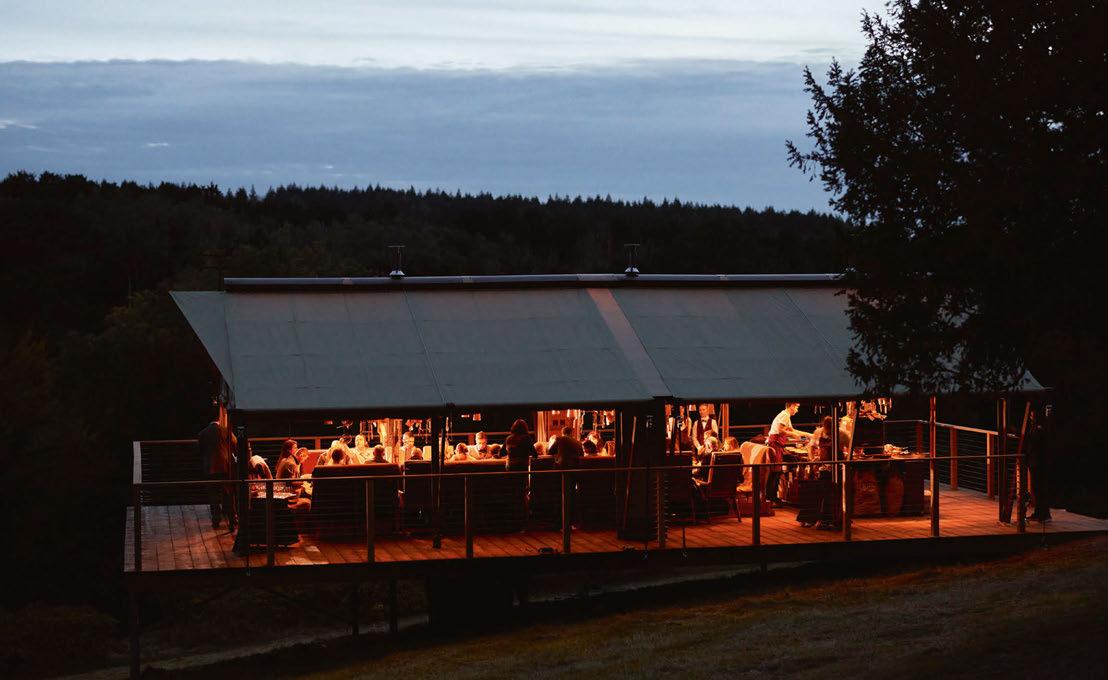
076 DINING
The Wild Kitchen at Beaverbrook offers a dining experience in a safari-style tent in the Surrey Hills
© Benjamin Wheeler

NYEWOOD, ROGATE, PETERSFIELD, HAMPSHIRE, GU31 5HZ Tel: 01730 821811 Email: office@johnjenkins.co.uk NEW YORK SHOWROOM, 41 MADISON AVENUE, 9TH FLOOR, NEW YORK NY 10010 Tel: 1-800-818-8484 www.johnjenkins.co.uk A perfect cocktail...the perfect glass Glassware for Professionals Havana
“The Best Rum, Period”
— LA Spirits Awards

“Ten To One’s Caribbean white rum is among my all-time-favorites for cocktails.”
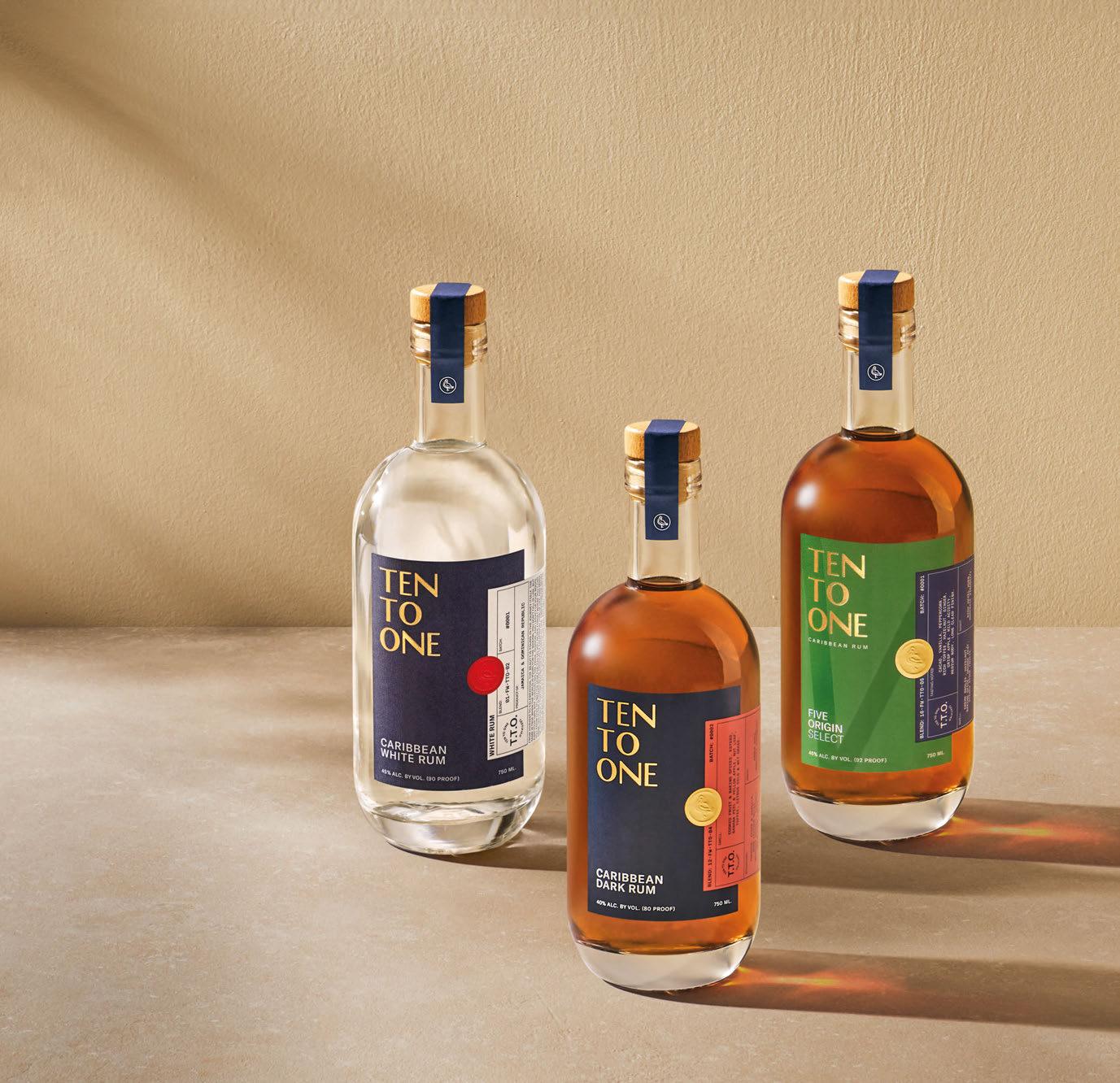

“Ideal for both mixing or enjoying on the rocks... full of buttery molasses, cedar and vanilla”
The brainchild of proud Trinidadian, Marc Farrell, Ten To One is a contemporary and elevated spirit, designed to challenge expectations, and reinvigorate the way people taste, experience, and talk about rum.





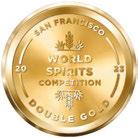

tentoonerum.com | @tentoonerum 94
APÉRITIFS

A Hotel with Spirit
Ardbeg has been distilling whisky in the Southern Hebrides for over 200 years, making use of the rich peatlands to produce a single malt that is revered for its smokiness.
However, the distillery’s location on the remote Scottish island of Islay – a two-hour ferry trip from the mainland – is perhaps not the easiest place to stop by for a dram, so when the opportunity came to acquire a hotel in the nearby town of Port Ellen, Ardbeg jumped at the chance.
Having operated the property in its current guise since 2022, the LVMH-owned brand has now revealed plans for a multi-million-pound enhancement, with Russell Sage Studio selected to take the lead on interiors. The Londonbased firm has already played a role in the transformation of the distillery’s visitor centre, and is set to bring its distinct style of storytelling to the hotel in a scheme that honours
the spirit of Islay. Proposed changes include a new-look restaurant and reimagined bar with a courtyard, as well as upgraded guestrooms featuring playful details and hidden surprises. There will also be a members-only lounge with a games room and whisky cave, and exclusive tastings of a limited-edition Scotch. Following the refurbishment, the hotel will reopen in 2025 under the name Ardbeg House.
“We are dedicated to making our island a great place to live and visit, so we are tremendously excited about our plans to create a world-class whisky and hospitality experience,” comments CEO Caspar MacRae. “While the hotel will, of course, be a spiritual home for the most ardent Ardbeggians, we promise even those just getting to know the world’s smokiest, peatiest Islay malt, will leave lifelong fans.”
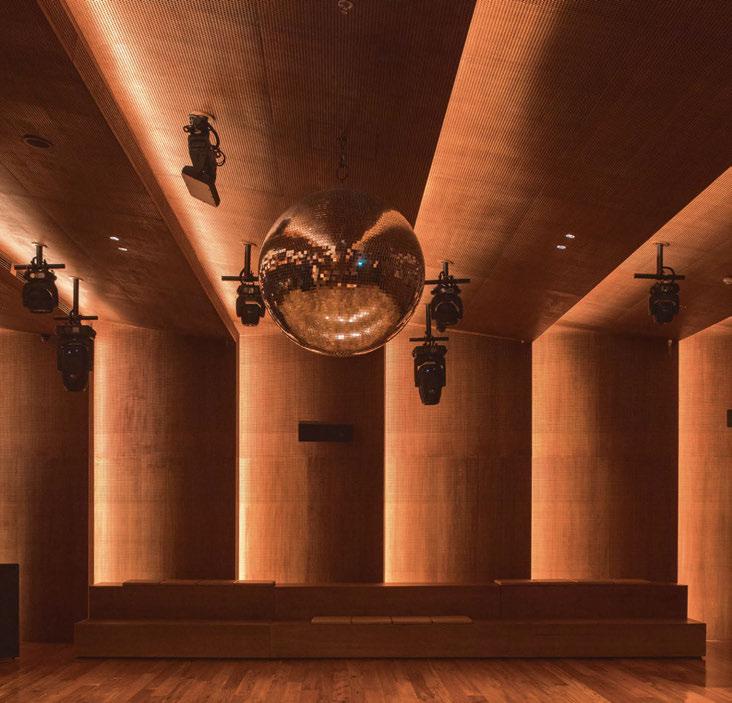
Sonic Sweet Spot
When Desa Potato Head opened on the shores of Bali in 2020, Ronald Akili achieved his dream of building a creative village. Featuring hotel accommodation, restaurants and bars, as well as a lab that repurposes waste as design pieces, the destination takes pride in its ‘Good Times, Do Good’ mantra, proving that a fun-loving attitude can align with a zero-waste goal.
In the latest instalment, the entrepreneur has opened a nightclub, adding to the hugely popular beach club that has pulled hedonistic crowds since 2010. Designed from ground to sound in partnership with the legendary DJ Harvey, Klymax Discotheque plays host to a curated lineup of international headline acts and local talent. Its interiors – by Potato Head Design Studio in collaboration with Dutch architects OMA – are acoustically treated to tame errant frequencies,
while a lighting scheme has been devised by Tokyo’s Real Rock Design.
Tapping into DJ Harvey’s expertise, the club also features a state-of-the-art sound system custom-built by revered audio engineer George Stavro, said to create a sonic sweet spot that presents the music exactly as it was intended to be heard – perfectly pitched with every nuance intact. From amp racks kept in their own airconditioned room to a sprung dance floor like that of London’s Ministry of Sound, every detail has been carefully considered and executed to contribute to a memorable disco experience.
The forthcoming schedule sees acts ranging from techno and electro to tribal and acid house, while a wider programme of sonic experiences at Potato Head Sound Space includes a listening bar, cinema screenings and mindfulness sessions.
The Tequila Ambassador
When Tomas Estes published The Tequila Ambassador in 2012, it was considered his seminal work on agave spirits. Credited for introducing the tipple to a European audience, the connoisseur led a storied life as a restaurateur, going on to launch his own brand of tequila having developed a passion for Mexican culture. Following the success of the first book, a second volume has now been released, completed posthumously by Phil Bayly (official global mezcal ambassador) and Mitch Wilson (global ambassador for Black Tot Rum), with support from Tomas’ son Jesse Estes (global brand ambassador for Tequila Ocho). Published by Wonk Press, The Tequila Ambassador V.O. was written from journal entries and articles that Estes compiled over the course of 40 years, as well as interviews carried out in the period leading up to his death in 2021. In passing his legacy to the next generation of tequila enthusiasts, Estes’ final wish for the book was for his share of the proceeds to be donated to The Drinks Trust. “My father’s passion for tequila and Mexico shone through in all that he did,” says Jesse Estes. “He would be deeply moved to know that his lifelong legacy lives on through the culture and spirit he so dearly loved.”

080 APÉRITIFS
© Tommaso
Riva
© Wonk Press





HAND-CRAFTED WELSH DRY GIN ENJOY CYGNET RESPONSIBLY CYGNET-DISTILLERY.COM @CYGNET GIN FOUNDED BY KATHERINE JENKINS
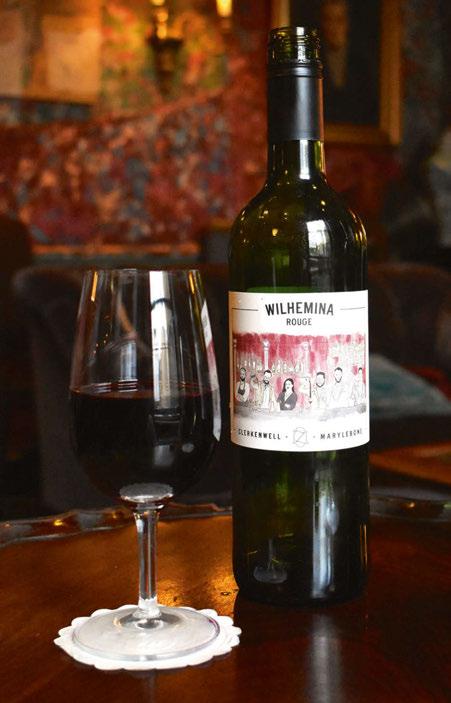
Wine by The Zetter
Having garnered a reputation for creatively crafted cocktails, The Zetter is now turning its attention to oenophiles, with the launch of its first wine collection. Available at The Zetter hotels in Clerkenwell and Marylebone, the new drinks experience has been developed by winemaker Chris Muret in collaboration with consultant Bert Blaize, and comprises two vintages. The Seymour Blanc is a blend of Chardonnay, Grenache Blanc and Muscat and offers lively acidity with refreshing citrus notes of lemon, lime and green apple; while The Wilhelmina Rouge is a medium-bodied red characterised by blackberry and plum, accompanied by a hint of spice. Both varieties feature a distinctive label designed by Chris Druitt, with key members of The Zetter team depicted in an ink sketch that encapsulates the ethos of the group. “Flavours are what give the wine its quality, but the label is how the personality is shown,” Druitt explains. “I wanted the team behind The Zetter to be front and centre, as without their hard work and dedication, this product wouldn’t exist.”
CGA by NIQ
The Global Bartender Report
Understanding how bartenders think and behave can power significant growth in drinks sales, according to a report from CGA by NIQ. Based on the BarSights survey comprising responses from 1,500 hospitality professionals, The Global Bartender Report provides intelligence to help brands generate advocacy. Here are five reasons why it matters:
BARTENDERS EDUCATE CONSUMERS
CGA’s research highlights the influence bartenders have on a consumer’s path to purchase. A third (34%) of on-premise visitors say they are interested in learning more about drinks choices from bartenders.
STAFF SWAY CHOICES
With 44% of consumers not deciding what they will drink until they are inside a venue, there’s great potential to steer people towards particular categories, brands and serves. Furthermore, over half (57%) of respondents say they can be swayed by a bartender’s suggestion.
RECOMMENDATIONS DRIVE TRADE-UPS
A bartender’s endorsements can help steer people towards more premium drinks brands. Despite the cost-of-living crisis, two-thirds (65%) of consumers prefer high quality drinks when they are out, so they are open to trade-ups if the price is right.
BARTENDERS CAN DELIVER INSTAGRAMMABILITY
Social media has become a vital factor in consumer choices, particularly amongst younger adults; suppliers that can help bartenders produce Instagrammable serves can further their online influence.
TEAMS ARE OPEN TO SUPPLIER SUPPORT
Bartenders want to give guests good service and suppliers can help them deliver it. Nearly half (46%) of hospitality professionals told CGA’s survey that providing a great experience is important to them, signifying that they would be open to training opportunities.
According to CGA, by leveraging the findings of this report, brands can gain a competitive edge, enhance product positioning and foster stronger relationships with the bartender community.
To see the full report and explore further insight from CGA by NIQ, visit www.cgastrategy.com
082 APÉRITIFS
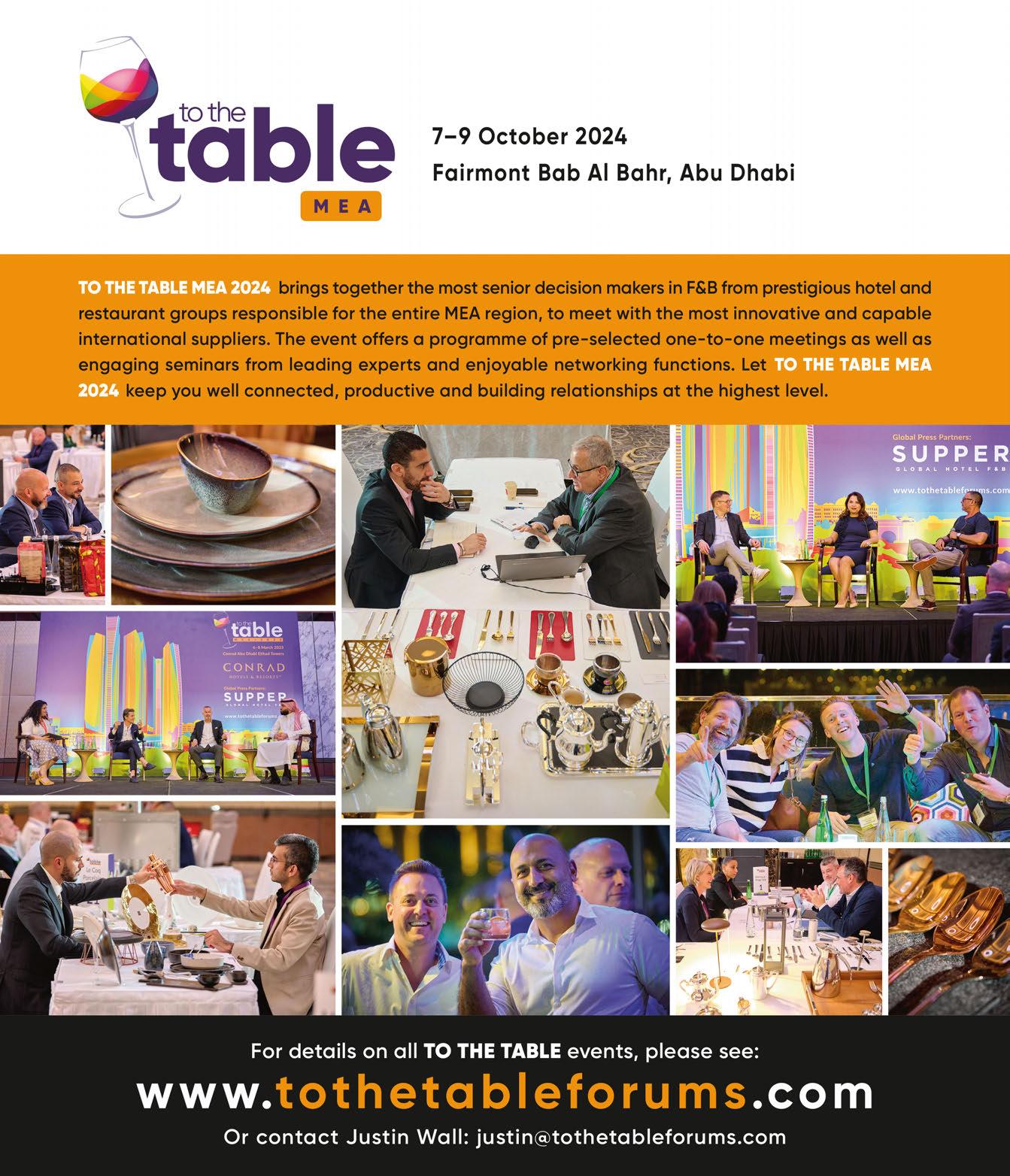
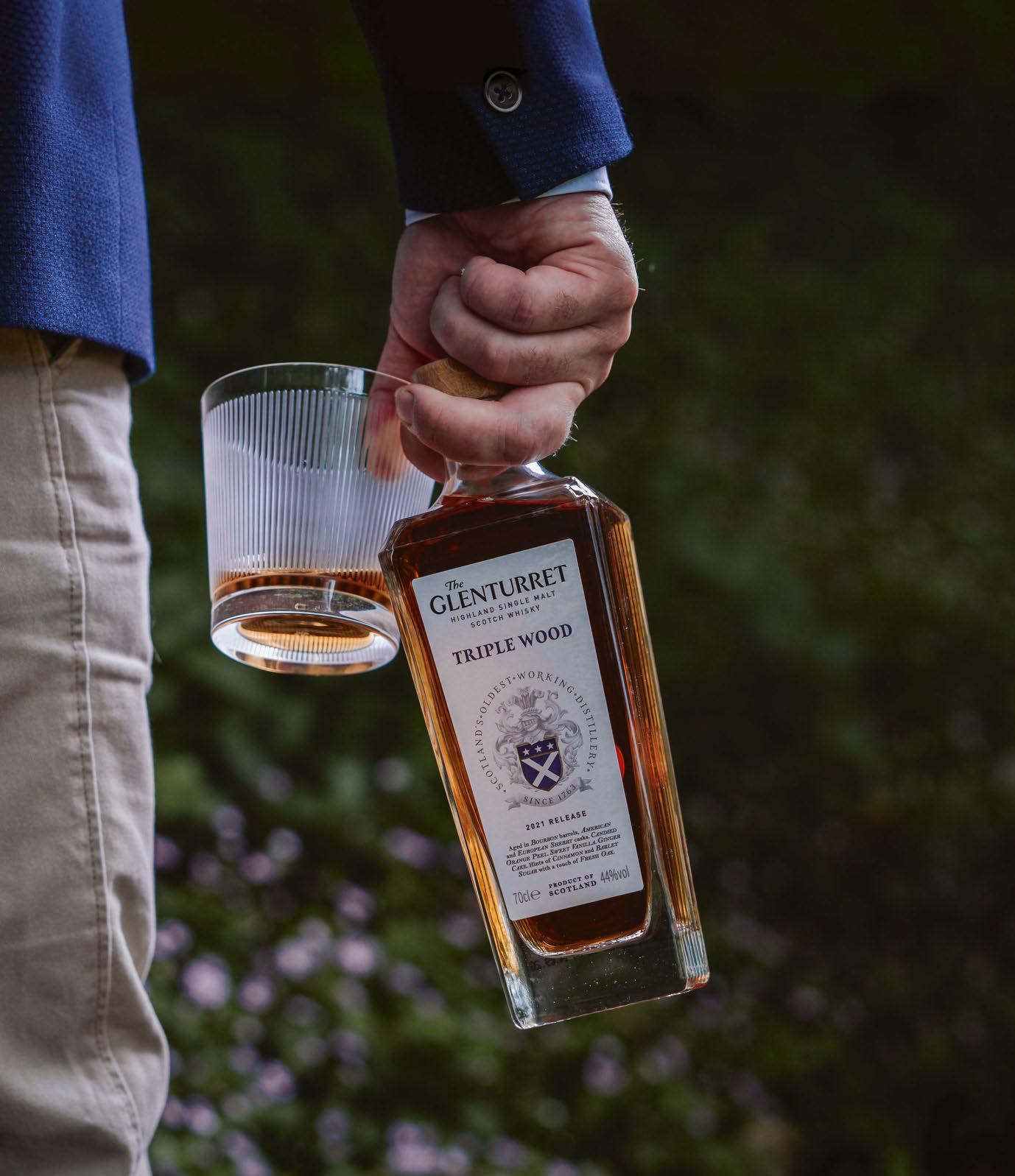
The Spirit of Scotland
Continuing a time-honoured tale of provenance, prowess and passion, The Glenturret adds accommodation to its awardwinning whisky distillery and Michelin-starred restaurant.
Words: Catherine Martin
Little has changed in the whiskymaking process over the past 250 years, particularly for Scotland’s oldest working distillery. Since its founding back in 1763, The Glenturret has taken pride in crafting single malt Scotch entirely by hand, passionately protecting the rich traditions and time-honoured skills of its forefathers. The values set by Sir Patrick Murray of Ochtertyre, the earliest-recorded owner, are as relevant as ever; his family crest still serves as the brand emblem; production methods have been passed from generation to generation; and the distillery stands proud in its original location, nestled in the Perthshire countryside close to the historic town of Crieff.
Though its identity remains deeply rooted in tradition, The Glenturret has a firm focus on the future, evolving and expanding to become much more than solely a spirit maker.
Having been acquired by Lalique Group and Swiss entrepreneur Hansjörg Wyss in 2019,

the distillery has bolstered its offering with a number of new ventures. It began with the launch of a new range of single malt, crafted by respected Whisky Maker Bob Dalgarno. Then came the release of The Glenturret 50 Years Old, aged to perfection over five decades and bottled in a black crystal decanter made by Lalique –decanter #1 of 150, presented in a bespoke case with mother-of-pearl inlay, fetched a cool £63,000 at a Sotheby’s auction. In 2021, a new restaurant helmed by Mark Donald opened its doors, winning a Michelin star within the first year, followed by a second just a few days before Supper’s visit. And in the latest instalment, The Glenturret has added accommodation in the form of an exclusive-use estate house.
Set in the lower glen overlooking the River Turret, a leisurely stroll from the visitor centre, The Aberturret is a six-bedroom country retreat with a dining room, lounge, cocktail bar and kitchen. Alongside the distillery and restaurant, the accommodation offer completes the line-up
SIPPING



© Simple
© Simple Photography
Photography
of hospitality experiences for the group, and comes at a time of sector-wide investment in bricks-and-mortar concepts as drinks companies tap into the lucrative lifestyle market. And though the venture is the first of its kind for The Glenturret, the owners both have a proven track record as hoteliers.
Wyss runs a farmhouse stay at Halter Ranch Estate, his vineyard in Paso Robles, California, while Lalique Group –helmed by Chairman Silvio Denz – has a growing collection of château-hotels across France. “With Hansjörg and Silvio’s experience, an accommodation offer at The Glenturret was a natural progression for the brand,” explains Colin Hart, Operations Manager and project lead on the development.
“As the distillery and restaurant are in such a rural location, we wanted to create a place for visitors to stay overnight –to relax, gather with friends and experience the best that Scotland has to offer.”
Surrounded by gardens and woodland, the accommodation occupies a stately pile dating back to the 1800s, formerly used as a dower house by the Murray clan. Interiors are designed by Will Nolan in the style of a contemporary country house, with furnishings that embrace the spirit of Scotland. Upholstery and soft furnishings are from Bute Fabrics, Harris Tweed and Lovat Mill – all woven in Scotland – while the impressive art collection has been curated by The Fine Arts Society in Edinburgh, with artists such as Joseph Farquharson, Edward Arthur Walton, George Harvey and Sir Eduardo Paolozzi on display.
Each of the six bedrooms has been individually designed and features a mix of contemporary and antique furniture. Original timber flooring uncovered during the refurbishment has been retained and restored, and in some rooms extends upwards to form a cocooning headboard – stained in a rich hue in reference to the American oak barrels used in the distillery. The en suite bathrooms are all unique too, some
“We have a lot of products around the £10,000 mark, and these consumers are also looking for if-you-know-youknow experiences. They don’t want something that’s accessible to all, they want that moment of discovery.”
COLIN HART
with spacious walk-in showers, others with freestanding copper bathtubs.
Downstairs, the communal spaces cater to a range of uses: there’s a formal dining room for entertaining; a kitchendiner with an Aga and fully-stocked larder for breakfast and lunch; and a cosy lounge with open-fire for a latenight dram. The cocktail bar serves as a setting for whisky tastings, with the knowledgeable team on hand to guide guests through the range. Much like the wine sector, The Glenturret releases its whisky in small-batch yearly vintages, meaning the spirit can be tweaked and improved upon as desired. Of the 2023 expressions, Triple Wood is a sweet and spicy spirit characterised by flavours of toffee apple and ginger having been developed in three cask styles, while the 12 Years Old classic embodies the essence of tradition, with American oak casks driving a salted caramel sweetness and the European oak layering dried fruits and spices. There are also peated varieties, such as the 10 Years Old Peat Smoked release, matured in both first-fill and second-fill European and American oak casks to form a complex single malt that offers a rich smokiness on the palate. All are the work of Bob Dalgarno, who joined after the takeover with the promise of creative freedom. To that end, the whisky maker has brought great success: The Glenturret Triple Wood 2022 release was awarded the world’s top single malt Scotch whisky at the International Wines & Spirits Competition in 2023, winning an Outstanding Gold medal with a score of 99. There are also special editions and brand partnerships, such as a single malt created exclusively for Gleneagles, and stocks at a selection of hotels including London’s The Dorchester. Prior to the new ownership, The Glenturret distilled whisky for other another brand, so in launching under its own label, a new identity and bottle profile was required. As it happens, Lalique Group already had expertise in this field; along with
087
SIPPING
Aberturret House has been designed by Will Nolan in the style of a contemporary country house, with furnishings that embrace the spirit of Scotland
“The best thing about visiting a distillery is the stories from the people behind it, and The Glenturret is built on authentic stories.”
ALEX THOMSON
perfumes and cosmetics, the portfolio includes a dedicated design studio known for the creations of René Lalique, ranging from chandeliers and vases to art and jewellery. The influence of the French glass designer is evident in the new bottle, featuring Art Deco-style grooves running vertically along the rectangular body – itself a break with convention in the world of single malts. The newly launched gin takes a similar form; designed by Claudio Denz in collaboration with Lalique’s Artistic and Creative Director Marc Larminaux, it sees the grooves run horizontally, and this time, the bottle is tinted dark green in reference to the nearby Highlands.
While the core range is bottled in receptacles designed by Lalique, special editions come in those that are also made by Lalique – the artisan crystal adding significant value and making for a highly collectible product. The most valuable is Eight Decades, a whisky drawn from eight casks ranging from 1987 to 1998, housed in a bottle designed in collaboration with master-of-light artist James Turrell; it retails at £80,000.
That a number of The Glenturret’s whiskies sell at £5,000-£10,000 per bottle, gives some indication as to the level of clientele The Aberturret will attract. There’s space in the grounds for helicopter landing, and activities such as archery and falconry can be arranged, not to mention off-site excursions for golf, fishing and hiking. “We have a lot of products around the £10,000 mark, and these consumers are also looking for if-you-know-you-know experiences,” explains Hart. “They don’t want something that’s accessible to all, they want that moment of discovery.”
Guests can also get preferential reservations at Lalique Restaurant, where Chef Donald’s Michelin-starred cuisine journeys through the Scottish culinary landscape. West coast prawns, langoustine and red mullet are sourced from nearby waters, while the use of wild ingredients hails from a formative season at Noma in Copenhagen. There’s an elevated take on the traditional tattie scone, and occasional reference to the distillery, as seen in the malted
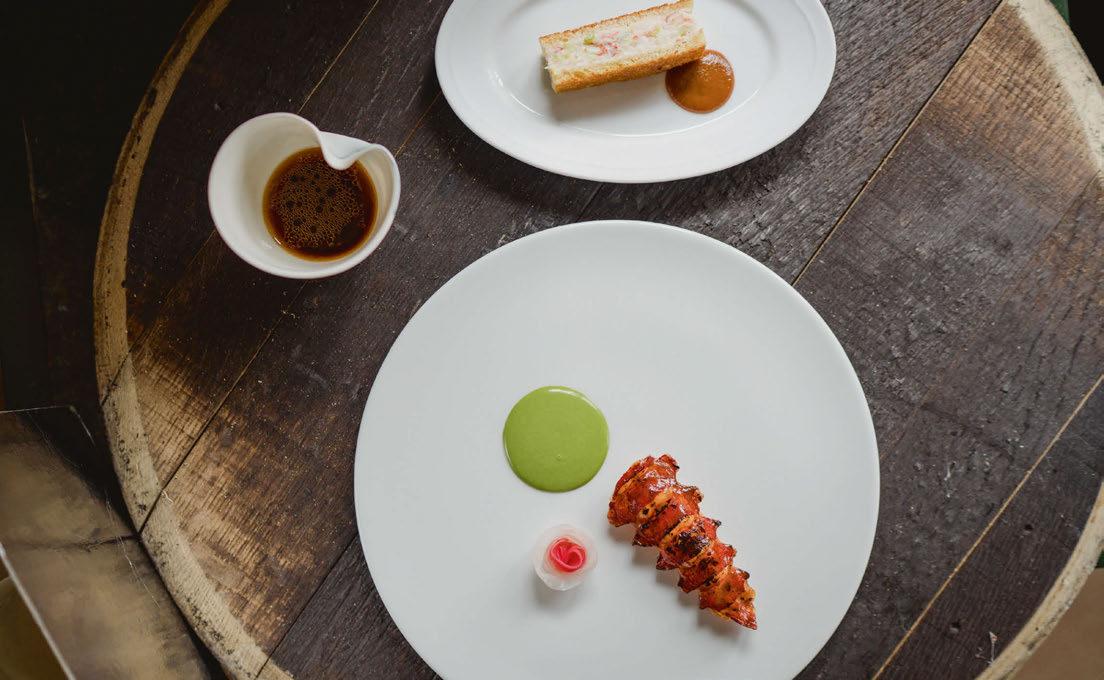
088 SIPPING
© Schnapps Photography
Bespoke products for front-of-house

www.rewthink.co.uk
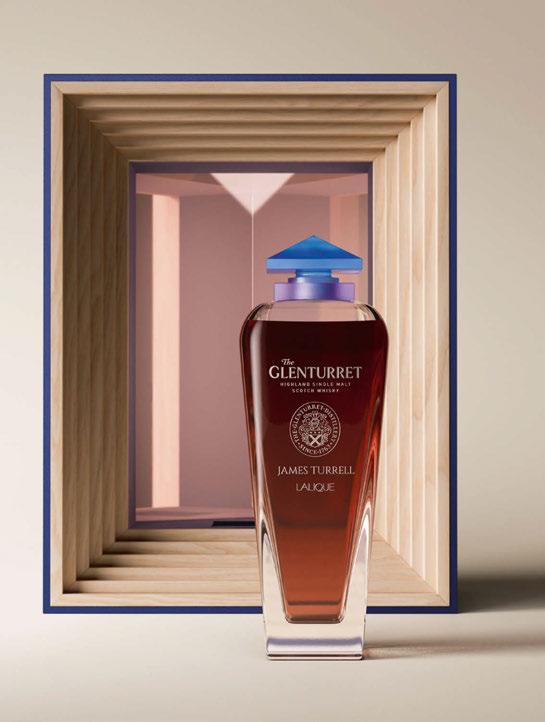
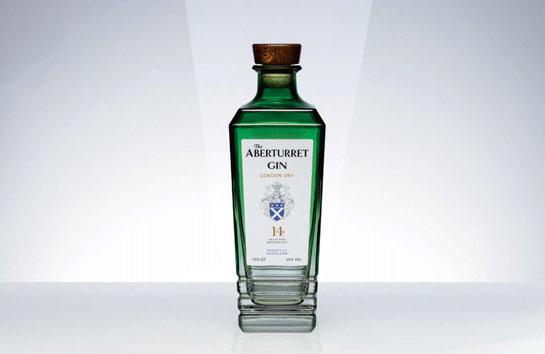
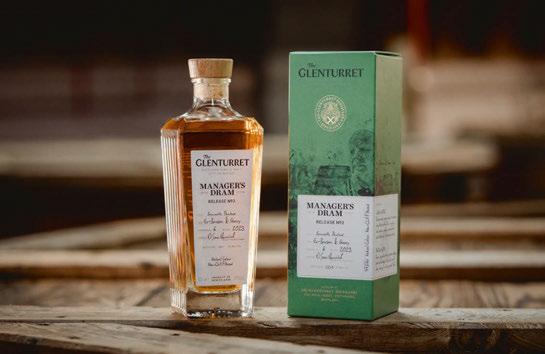
barley sourdough, the succulent junipersmoked roe deer, and for the sweet-toothed, a Maracaibo mille-feuille topped with a rich sauce spiked with The Glenturret Triple Wood. Even the serving trays are on brand, made by Rewthink from solid fumed European oak, much like the barrels used for ageing the whisky. Naturally, some of the dishes are served on Lalique tableware too – the Perthshire bramble is revealed beneath the undulating waves of the clear crystal Vibration Box, for example, while the refreshing Glen Fizz cocktail is served in the exquisitely carved Old Owl highball.
Completing The Glenturret experience is a Lalique Boutique and distillery shop, as well as guided tours of the distillery itself, where a handsome copper still steals the show and tales of the past bring the time-honoured whiskymaking process to life. And it’s these tales of the past that have proven particularly powerful for the brand. “The best thing about visiting a distillery is the stories from the people behind it, and The Glenturret is built on authentic
stories,” explains Alex Thomson, Visitor Centre Manager, adding that “whisky is intrinsically linked to where it comes from, evoking a sense of place with every sip”.
Thomson believes that this authenticity will help draw a younger crowd to the sector, a shift that is being driven by the mixologists and bartenders creating new whisky-based cocktails. For The Glenturret, of the 150,000 bottles sold globally per year, around 50% go to hotels, restaurants and bars, so there’s a clear focus on the on-trade market, increasingly so in the USA – the biggest whisky-consuming country in the world. With that in mind, The Aberturret will also serve as a brand home. “The accommodation completes the circle for visitors, but we also wanted a space that we can use as a brand,” concludes Hart. “If we can invite bartenders from New York, for example, and give them the opportunity to stay in The Aberturret, tour the distillery and sample the whisky, they can take their learnings home and spread the word on the spirit of Scotland.”
090
The Glenturret’s collection includes the new Aberturret Gin, as well as special editions such as Eight Decades, housed in a bottle designed in collaboration with master-of-light artist James Turrell
©
SIPPING
Schnapps Photography

ENJOY RESPONSIBLY | WWW.HARDYCOGNAC.COM

Safety Frappé Lyaness Sea Containers
LONDON
Lyaness, the flagship bar at Sea Containers London, is celebrating the launch of its third and final Cookbook cocktail menu. Conceived by award-winning mixologist Ryan Chetiyawardana – aka Mr Lyan – the 3.0 Cookbook takes a paredback approach to mixology, blending storytelling and flavour creation for a multi-layered drinking experience. “We created some very grand menus in the build up to this, and we wanted to strip back and focus on something that’s inherent to the food world but often misunderstood, or hazily embraced, and that was simply ‘flavour’,” explains Chetiyawardana. As such, the menu comprises 15 cocktails, each made with a one-of-a-kind ingredient not typically associated with libations. Goose & Gander #4 features a dash of Szechuan sauce for example, while the Kentakki Fried Cocktail is influenced by the unexpected pairing of Japanese spices and fried chicken. Pictured is Safety Frappé, a blend of Hendrick’s Gin, shiso absinthe, mint, anise and peach wine, inspired by various old wives’ tales said to ward off the troubling effects of certain foods. “We wanted to give insight to why we seek out the stories we do, and why we focused on bespoke ingredients,” Chetiyawardana concludes. “With this final cookbook menu, we’re taking guests behind the curtain of the way we make things the way we do, but also how important bars, people and flavour are to socialising in more interesting ways.”
COCKTAIL

100 Cavalli Principe Bar
Hotel Principe di Savoia
MILAN

Following Daniele Celli’s appointment as Bar Manager at Hotel Principe di Savoia, the Abruzzo-born mixologist has curated a new cocktail menu comprising six classic concoctions dating back to the 19th century, as well as six of his own signature serves. The latter includes 100 Cavalli, a unique highball inspired by the ancient Hundred-Horse Chestnut tree at the foot of Mount Etna in Sicily. “It is said that a queen, accompanied by 100 knights and ladies, was surprised by a storm during a hunting trip near the tree and found shelter right under the branches,” explains Celli. To make the concoction, a base spirit of Rum Zacapa 23 is combined with chestnut sherbet, Ceylon Orange Pekoe black tea, a lime and half a lemon. The ingredients are stirred together lightly before being poured into a highball glass and served with an ice stick to control the temperature and dilution. For Celli, what sets the libation apart is the interaction of the ingredients. “As I undertake the transformation of Principe Bar, my commitment is two-fold: honouring timeless classics and introducing innovative flavours to strike the perfect balance,” he concludes. “This curated drink list signifies not just a selection of beverages but a transition from the old Principe Bar to a new era, showcasing our evolution in the craft.”
COCKTAIL
© Andrea Di Lorenzo
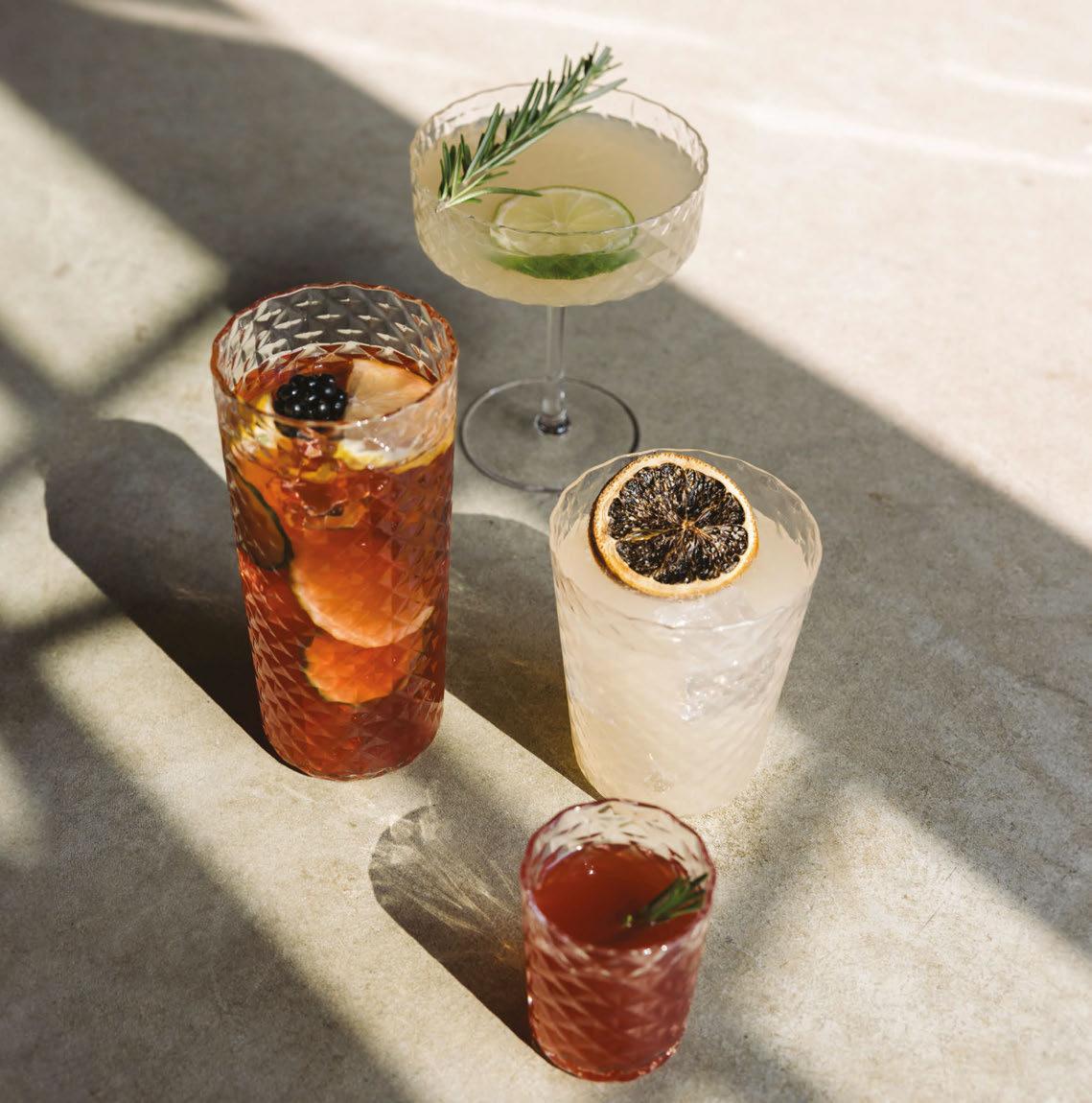
| Milan | New York Online store: zafferanoeshop.it
Stores: Treviso
Veneziano Mixology Goblet, tumblers and shot
Fine Drinking.
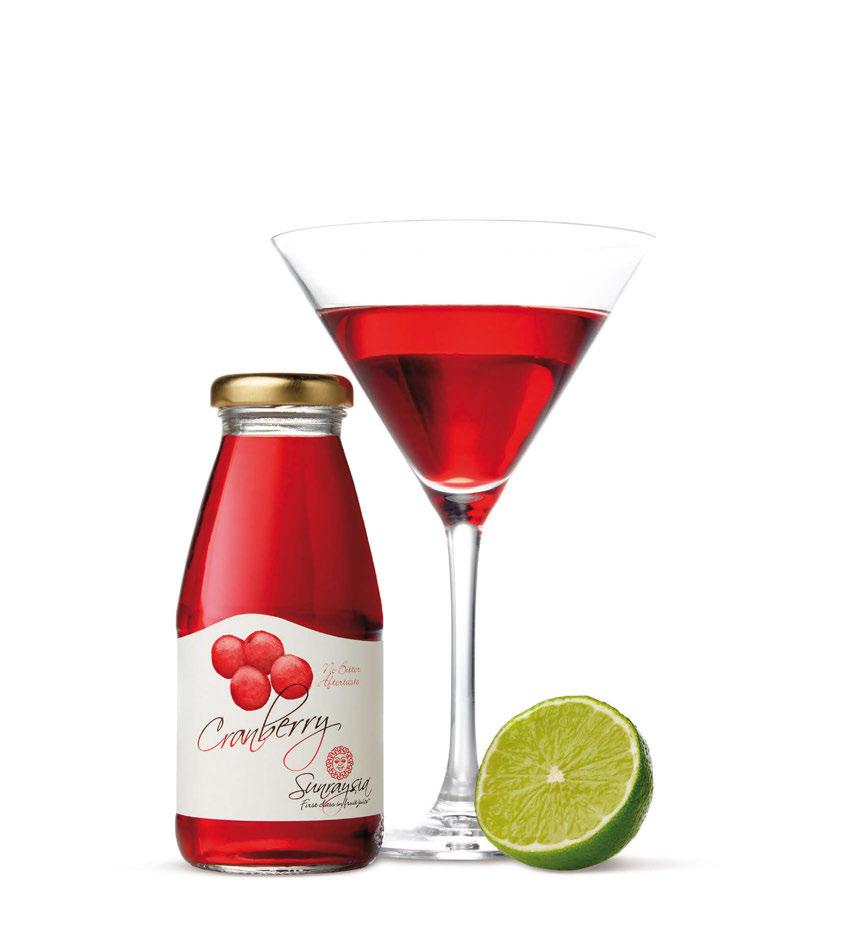



Sunraysia Five Star Cranberry is currently enjoying residency at the following fine hotels: The Lowell New York, Boston Harbor Hotel, Four Seasons Hotel Philadelphia, The
Setai Miami, Park Hyatt New York, The Langham Chicago, L’Ermitage Beverly Hills…
(Pictured Cocktail: Sunraysia Cosmopolitan, mix it from your hotel minibar.)
DRINKS
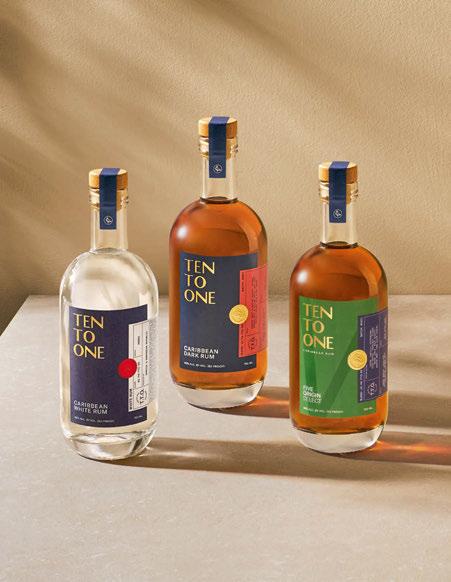
Ten To One Rum White Rum, Dark Rum and Five Origin Select
Caribbean rum brand Ten To One has launched Five Origin Select, a new blend of rums aged up to 15 years, highlighted by the inclusion of 11-15 year old Guyanese rum distilled on the famed Port Mourant double wooden pot still – the only one of its kind still in operation. Brought together alongside signature rums from Trinidad, Barbados, Dominican Republic and Jamaica, and bottled at 92 proof, Five Origin Select has mild acidity, a medium body and a long, clean finish. Featuring notes of crème brûlée, hazelnut, baking spice, orange zest and stewed stone fruits, this expression unfolds to reveal cacao, vanilla, peppercorn, toffee, hazelnut, ginger and crisp apple. Five Origin Select is the latest addition to Ten To One’s award-winning rum portfolio, standing alongside white and dark rums, each of which are suitable to be enjoyed on their own or within a cocktail. Founded by Marc Farrell in 2019, Ten To One is a brand designed to challenge expectations and reinvigorate the way people taste, experience and talk about the spirit. www.tentoonerum.com
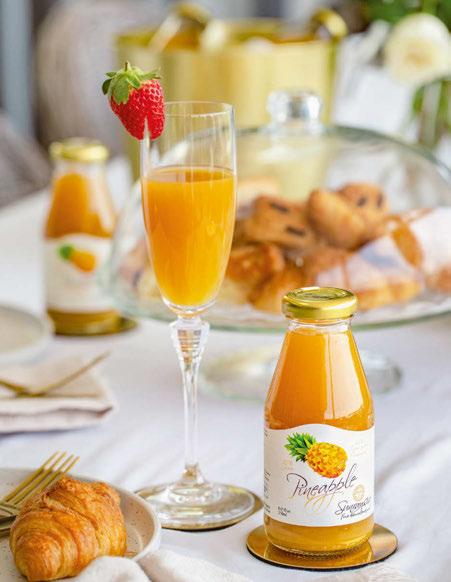
Sunraysia Five Star Sunraysia Five Star 100% Natural Juices
Dedicated exclusively to luxury hospitality, Sunraysia Five Star is a family-run Australian brand committed to producing 100% natural fruit juices made without artificial colours, flavours, preservatives or genetic modification. Stocked in more than 30 countries and destinations across the world, the Sunraysia Five Star range enhances the luxury guest experience by offering high-quality fruit juices in the hotel minibar, at restaurants and cocktail bars, as well as at selected conferences and events. As suppliers to some of the most exclusive luxury hospitality establishments and fine-dining restaurants across the globe, the company ensures each drop is pure, fresh, nutritious and delicious by sourcing fruit from specific regions that offer the highest quality produce, such as Valencia Oranges from the Murray valley region of New South Wales, Australia, or a blend of Pink Lady, Royal Gala and Red Delicious apples from the south hills of New South Wales. www.sunraysiafivestar.com
097

Hardy Cognac Legend 1963
Founded in 1863 by Anthony Hardy – an English wine and spirits professional with a passion for all things French – the Hardy cognac house combines tradition and innovation to offer a unique taste experience. In the 160 years since its creation, Hardy has continually sought out new markets across the globe, introducing a variety of products along the way, from anniversary vintages to crystal decanters. Today, heir Bénédicte Hardy upholds the family tradition, promoting Hardy’s distinct values with fervour and authenticity. To mark the house’s 160th anniversary, Hardy has adopted a new look, starting with the Tradition collection. Drawing inspiration from 1950s packaging, Hardy Legend embodies a modern reinterpretation of the maison’s storied past with notes of coffee and cappuccino that balance elegance and finesse whilst embodying the Hardy spirit. The introduction of Hardy Legend is a testament to the brand’s rich history and forward-thinking vision. www.hardycognac.com
DRINKS 098


IN A CLASS OF THEIR OWN



















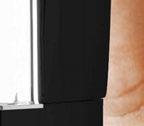


































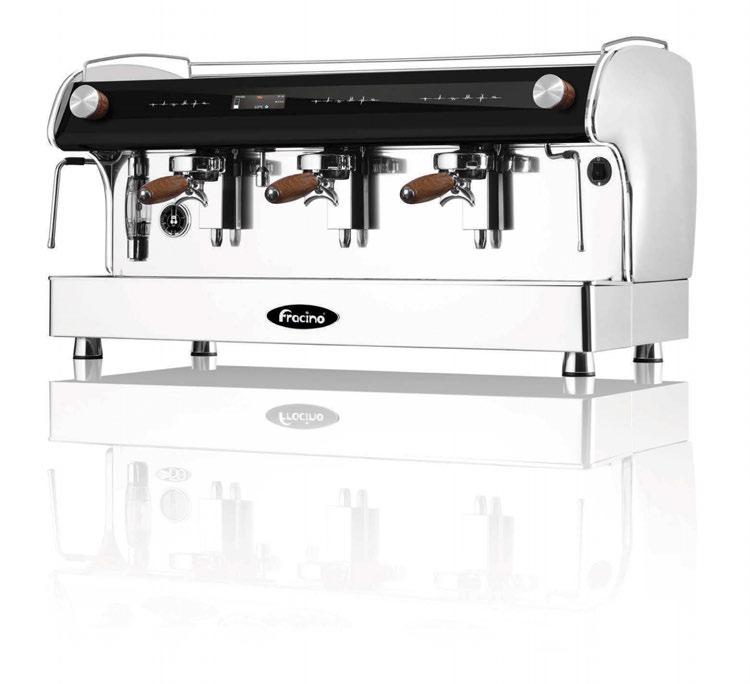
ROMANO-
S t y l e a n d Q u a l i t y
Our strikingly stylish Romano -R – the fusion of contemporary design and technology. Featuring a full length Touch Screen Selection Panel and LED Display, it’s stunning design is enhanced with Real Wood Handles, LED Edge Illumination and Barista Lighting in the coffee preparation zone.

Available in 2 or 3 group versions, the Romano -R boasts all the power, technical qualities and reliability synonymous with Fracino’s espresso equipment range
W / www.fracino.com E / sales@fracino.com T / +44 (0)121 328 5757 R
THE No1 CHOICE FOR BARISTAS
R

A Shot of Innovation
As the global coffee market continues to grow, the next generation of machines expertly blend technological precision and intelligent design.
Good coffee is an indisputable benchmark of the modern hotel F&B experience. The global rise in popularity of residential coffee machines has turned everyday guests into caffeine connoisseurs with a heightened awareness of all aspects of fourth wave culture, ranging from bean origin and barista technique to sustainability and presentation. And with data from the market research company Mordor Intelligence assigning the global coffee machine market an estimated value of US$10.22 billion in 2024 (projected to rise to US$ 12.31 billion by 2029), the sector looks set to remain buoyant for some time yet. Luckily, technological innovation is evolving to meet demand, with multiple recent product launches seeking to simplify or enhance the coffee-making and drinking experience in some way. It all starts, of course, with the beans. Premium brand Julius Meinl is addressing the ethics of coffee drinking head-on with the launch of three new artisanal blends as part of its product line The Originals, designed specifically for the horeca sector and inspired by Vienna’s coffeehouse heritage. In a first for the
company’s horeca product line, the new blends are both bio, meaning each bean is nurtured through responsible, organic agricultural processes, and Fairtrade, which sees farmers receive a fair price for their coffee crops. The trio comprises the Belvedere blend, named after one of the world’s oldest museums; the Gloriette Gold, which celebrates a 1775 baroque garden structure offering views over Vienna; and the Danube Delight, a tribute to its namesake river. “Double-certified products are the future –they are not only sustainably sourced, but they are also supporting farmers with the many social, economic and environmental challenges they may face, from unpredictable incomes to climate crisis,” explains Christina Meinl, Managing Director at Julius Meinl Austria. “In short, they are better for people, better for the planet and better for business.”
Maste ring the coffee-brewing process is paramount to the drinking experience, and consumers are increasingly exigent when it comes to barista technique. Manufacturers are constantly seeking ways to reduce the margin for human error when it comes to crafting the
SPOTLIGHT 101
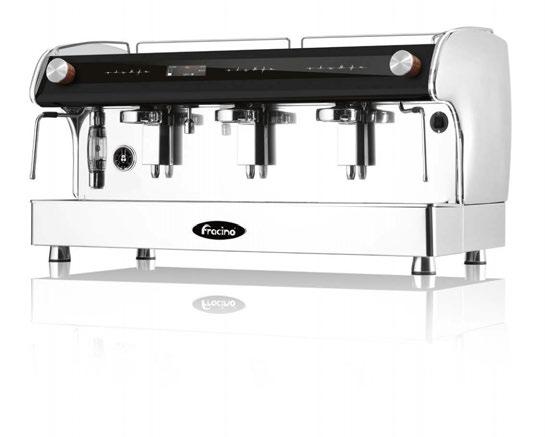


Machinery that focuses on streamlining the barista process is a priority for manufacturers such as Franke (previous page), Fracino (top), WMF (middle) and Melitta Professional (bottom)
perfect latte or flat white, developing automatic machines that support employees in hitting the mark. A fitting example is the British brand Fracino, whose take on this approach has been to focus on improving the quality of the coffee extraction – a process that can greatly impact the overall flavour of the drink, with under-extracted espresso running the risk of being too acidic, and over-extracted espresso often tasting dull and rough. The brand’s flagship Proportional Integral Derivative (PID) Romano espresso machine features an array of control and diagnostic features, such as an independent boiler, that allow for optimum temperature control and espresso extraction, helping to keep service consistent.
Another company aiming to streamline the barista training process with easy-to-use machines is the German automated coffee machine specialist WMF, whose espresso Next machine is designed for businesses grappling with staff shortages or frequent turnover. Its intuitive system supports new employees in getting up to speed, while an integrated grinder and tamper facilitate automatic dosing, ensuring consistency of results regardless of who is in charge of the machine. A new Americano function also makes it possible to easily brew a beverage at the simple push of a button, freeing up time for other tasks. The system has won the backing of the star barista and threetime winner of the German Latte Art Championships and WMF Brand Ambassador Daniel Gerlach, who was recently unveiled as Product Ambassador for the espresso Next. “The WMF espresso Next supports baristas over the entire brewing process,” explains Gerlach. “Whether you’re a newcomer or a professional: the WMF espresso Next gives you the perfect espresso every time.”
Space, as always, is at a premium in hotel F&B outlets, providing the impetus for manufacturers to come up with
102
© J Sunderbrink SPOTLIGHT


MODBAR.COM Boiler The Studio, Bucharest
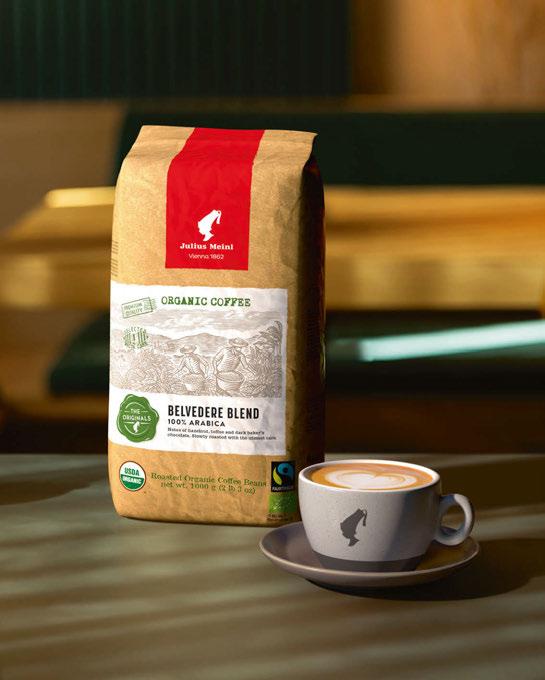

creative and compact solutions that blend seamlessly into high-traffic areas. US specialist Modbar has carved out a reputation as the go-to option for clients seeking a non-traditional, minimalist aesthetic that focuses on freeing up countertop space, thanks to a design that centres on a series of taps and accessories and a machine that sits out of sight at ground level. The modular, customisable system can be mixed and matched or used in standalone sections, and the full range comprises two configurations of espresso systems, a pour-over system and a steam system – all of which can be adapted to meet the needs of a variety of set-ups. Multiple options for colours, materials and finishes provide further opportunity for creative expression. The under-counter design also has the advantage of fostering greater connection and engagement between the barista and the customer.
Another essential hallmark of the modern automatic coffee machine is adaptability, with appliances that serve multiple purposes sure to be a hit with horeca clients. It’s here that heritage brand Melitta Professional comes to the fore; the German manufacturer recently debuted a new Cafina XT Aroma System that comprises a slim module, compatible with its XT5-XT8 fully automatic machines, that creates
the opportunity to whip up coffee-based cocktails, expanding the fully automatically prepared variety of beverages with up to five different flavours for several new mix ideas at the touch of a button.
What’s more, increasing requirements for efficiency and precision don’t necessarily need to come at the expense of design; elegant and stylish machines will always be in high demand, particularly in self-serve spaces and outlets. Among the slew of aesthetically pleasing machines on the market is Franke Coffee Systems’ Mytico, which combines Italian design flair with Swiss engineering and celebrates the craft of traditional coffee making without the need for extensive training. Developed by Emo Design in Italy in close collaboration with a cross-functional in-house team from Franke Coffee Systems, Mytico features a distinct shape, portafilter-like spout and angled feet that lend it a sleek yet industrial look. The result has been multiple design awards, the most recent of which was the iF Design Award Gold, in February 2024. Proving that innovative technology and traditional design principles both have a place in the future of the automated coffee machine, the product encapsulates the ambitions of the industry as a whole.
104
©
Martina
Orska
SPOTLIGHT
Julius Meinl’s new horeca range is both bio and Fairtrade (left), while Modbar has put a minimalist spin on the modular automated coffee system (right)
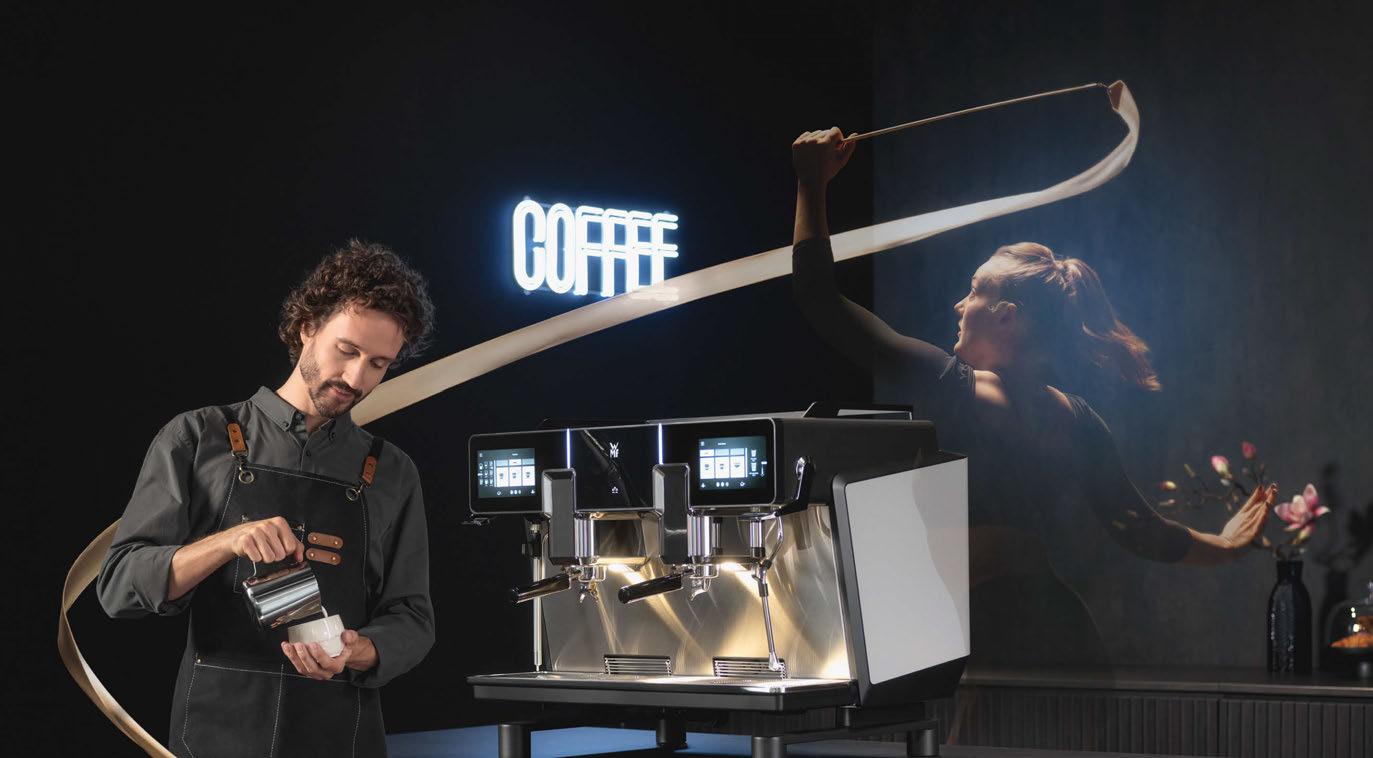































WMF espresso NEXT Making coffee is an artistic endeavour, involving passion at every step. The WMF espresso NEXT turns this process into an effortless, reliable and endlessly repeatable choreography. Just like a world-class athlete, the semi-automatic portafilter machine delivers passion, expertise and character every time. With the WMF espresso NEXT handling complex tasks like grinding, tamping and milk frothing, barista-quality coffee is guaranteed and the operator has more time for customers. Let your coffee business flow smoothly – with the WMF espresso NEXT.




COFFEE CULTURE‘S NEW CHOREOGRAPHY, PERFECT REPEATABILITY TURNED INTO ART. DESIGNED TO PERFORM
wmf-espresso-next.com

106
Design Heritage Goes Digital
Portuguese porcelain brand Costa Verde demonstrates the power of honouring tradition while embracing innovative digital printing technology.
The Portuguese porcelain tradition is as much about history and heritage as it is about design – but prestige tableware brand Costa Verde’s contemporary approach to technology is proving that even the very old can be enhanced by the new.
The company is making innovative use of digital printing processes to further develop the extensive Moods series it first unveiled in 2021, a range comprising 16 different collections, each aligned with and inspired by a specific emotion or feeling. The brand, which had already experimented with digital printing on porcelain in some of its other collections, presented the results of its new design strategy for Moods at Ambiente in Frankfurt in January 2024, to sweepingly positive reviews.
“This technology has opened up a range of possibilities and capabilities, both in terms of its application directly onto porcelain, and its application onto unglazed pieces, which are subsequently glazed and fired,” explains Marketing Director Paulo Pinto Santos of the company’s new direction. “Inspired by authenticity and driven by innovation, Costa Verde has explored new decorative alternatives by directly imprinting its designs on porcelain.”
The most recent examples of this cuttingedge approach to tableware design can be seen in two headline Moods collections – Bubbly
and Tense – both of which bear the artistic hallmarks of digital printing. Bubbly was born from an amalgamation of various Costa Verde collections and transports the diner to a joyful world of heightened sensory awakening thanks to the effervescence of its subtle textures and the calm, tranquil nature of its glaze. Tense, meanwhile, evokes notions of tension and adrenaline, offering both matte and glossy versions centred on colourful glazes. Both collections advocate for organic simplicity, and feature reactive ink applied via digital printing technology. The process begins with the printing of reactive ink on porcelain, which, when glazed, reacts with the glass, exploring sensory, natural and organic qualities emphasised by textures and chemical reactions between various colours. The result? Original, captivating designs that convey the traditional elegance of Portuguese porcelain, with a firm nod to the freedom of creative expression.
The strategy to modernise and refine technical processes is an astute one, given the competitive pace of change in the porcelain tableware industry today. “In what is still a very traditional sector, porcelain wants to reinvent itself and adapt to the current and future needs of global markets,” says Pinto Santos. “Costa Verde is continuing to succeed in doing so thanks to its strong investment in
research, development and innovation, and in the acquisition of equipment that allows it to pioneer experimental techniques.”
At its extensive production facility in Aveiro, Costa Verde benefits from the expertise and know-how of countless specialists, allowing the brand to forge strong connections between its research and development, technical and marketing departments. Furthermore, a solid commitment to investing in technology ensures that the company remains associated with the most important agents and opinion leaders in the horeca sector. Created by and for professionals, Costa Verde’s collections continue to convey a sense of efficiency and deliver on indispensability, thanks to an unwavering sense of focus on durability, replenishment capacity and timeless designs.
This consistent appetite for research and development means that Costa Verde – which was founded in Portugal in 1992 – now has a presence in more than 50 countries worldwide, making it one of the hospitality and catering industry’s major players and a top choice for some of the most demanding professionals in the sector. Three decades of steady growth have produced multiple global partnerships, to the extent that these days, some 70% of its revenue is attributed to the international market. www.costa-verde.com
SPOTLIGHT 107

PETITS FOURS

Fine Dining & Living
Fine2Dine – Calca
Fine Dining & Living brings together fine, contemporary and well-thought-out tableware, home and decoration brands all under one roof.
Fine2Dine stands for trend-based, high quality tableware for creative professionals, providing solutions for hotels and restaurants all over the world. Most recently, the brand unveiled Calca, a tableware collection that pays homage to the island of Santorini. Crafted from refined porcelain in a white-grey hue, Calca features gentle lines and subtle textures that evoke the charm of the Greek islands. www.finediningandliving.eu/brands/fine2dine
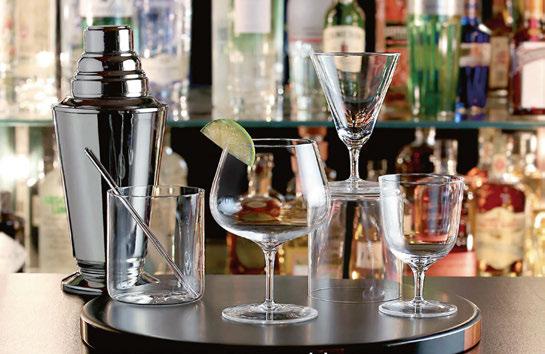
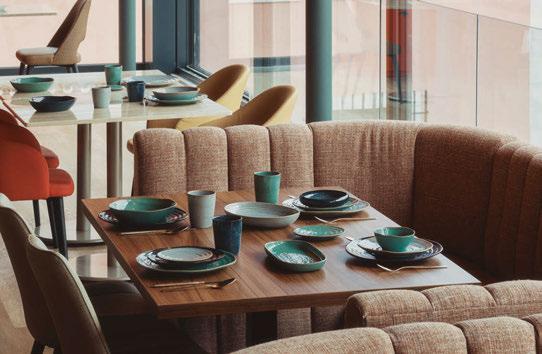
1. John Jenkins Havana
British glassware manufacturer John Jenkins has launched Havana, a collection of handmade cocktail glasses comprising four distinct shapes: a straightsided glass for either a cocktail or water; a balloon shape for cocktails; a flared version of Martinis and finally a traditional shape for cocktails or sake. John Jenkins is known for its diverse and extensive range of both handmade and machine-made glassware that runs the gamut from wine and cocktail glasses to classic tumblers, all of which are available for immediate delivery. The company also has an in-house design department that can create bespoke pieces and exclusive patters to suit specific requirements. Each pattern in the portfolio benefits from the latest advancements in glass-making technology, which are implemented to enhance the clarity, durability and scratch-resistance of the finished product. www.johnjenkins.co.uk
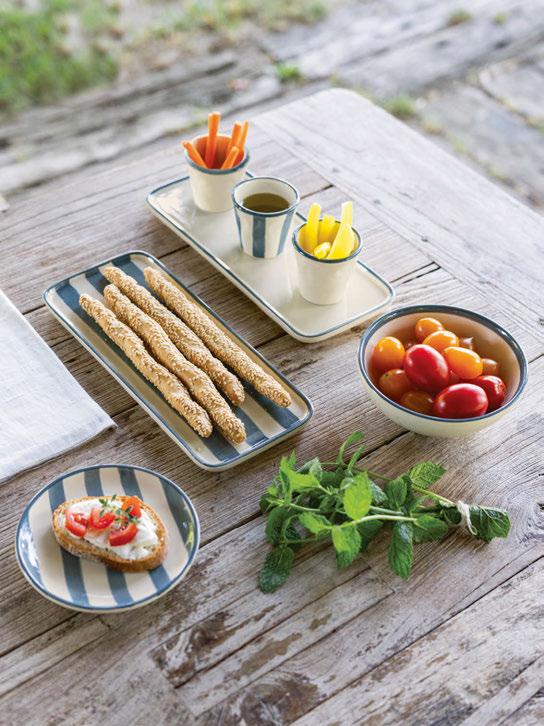
2. Vista Alegre Gemstone
Portuguese manufacturer Vista Alegre’s Stoneware
Collections feature a diverse range of colours and shapes with reactive glazes, making them suitable for sharing concepts. Each piece varies in pattern and colour intensity – an intrinsic element of this predominantly handmade manufacturing process – making them truly unique. Available in Jade, Lapis Lazuli, Moonstone and Coral – characteristic shades of semiprecious minerals – the Gemstone collection stands out due to the stoneware’s organic shapes and surprisingly irregularities, which enhances the opportunities for mix and matching. Established in 1824, Vista Alegre has always been associated with Portuguese history and cultural life, having built an international reputation for its portfolio of tableware, gifts, decoration pieces and porcelain articles for hotels that all maintain a strong link to design and culture.
hotelware.vistaalegre.com
3. Zafferano Lido
Envisioned by Venetian designer and Zafferano founder Federico de Majo to enhance food presentation and table service, Lido is a collection of vibrant and versatile tableware pieces that play with different colours and patterns. The range comprises small cups, plates, bowls, trays, and bottles that can be mixed and matched to bring liveliness and joy to the table, the terrace or a picnic. In keeping with the creative and innovative spirit that is part of Zafferano’s DNA, the brand has discovered a wealth of knowledge about the art of working with clay that dates back to the 10th century BC in the historic village of Civita Castellana, near Rome. Here, the mastery of ancient artisan techniques in the production of ceramics has encouraged a partnership that has allowed Zafferano to offer Made-in-Italy objects since 2001 that are hand-decorated with exclusive designs or can be customised upon request.
www.zafferanoitalia.com
110
3. 2. 1.
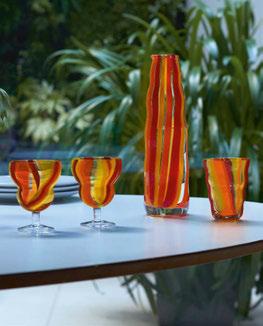


1. LSA International Folk
Founded in 1966, LSA International is a London-based design studio specialising in stylish and contemporary glassware across the bar, table and decoration sectors. One of its newest creations is Folk, a collection of glassware inspired by traditional Polish costumes. Staggered bands of alternating colour mimic Łowicki fabrics, and the exaggerated silhouettes of layered, billowing skirts are seen in the wide, undulating shapes. Solid, coloured glass rods are fused with a gather of clear glass and then mouth-blown into a bespoke mould. The skilled, handmade process produces distinctive folk-inspired patterns and organic forms, with no two vessels ever being the same.
www.lsa-international.com
2. Orrefors Pulse
Characterised by sharp, distinctive lines, the Pulse collection from Orrefors enhances both beverages and table settings. Designed by Ingegerd Råman, the new Pulse champagne glass epitomises the fusion of elegance and utility, elevating any event with its glamour, whilst ensuring enduring quality even through dishwasher cycles. Crafted with precision, it features a discreet laser point within that accentuates champagne bubbles. Orrefors has been producing glassware in collaboration with Sweden’s top designers since 1898. The manufacturer began making crystal products in 1914, and the glass produced today is based on 100 years of expertise.
www.orrefors.us

3. Zieher Leaf
Zieher is a name synonymous with innovative design in both the tabletop and buffet sectors. The brand counts five-star hotels and top class restaurants across more than 90 countries among its international client list. Most recently, the company reimagined its artful Reef bowls and baskets – made from highquality pewter alloy – as the new Leaf decor. The Leaf range takes on a lively and floral touch with delicate vines and branches, as well as intricate leaves. As a result, the series gives off a playful vibe and conveys a completely different charm despite its resemblance to the fossil-inspired designs of the original Reef series.
www.zieher.com
4. Rewthink Bespoke front-of-house products
Specialising in customisable boards, trays and trolleys that bring theatre, excitement and anticipation to the dining experience, Rewthink has worked with a range of chefs and restaurateurs from around the world to bring their creative ideas to life. With 10 years of experience focusing solely on front-of-house products, every aspect of the brand’s design is carefully considered to ensure durability and functionality, as well as aesthetics. Rewthink items are designed and manufactured in its workshop in Kent using a range of materials including sustainability sourced tumber, Cumbrian stone, bras, steel, copper, glass, leather, silicone and acrylic.
www.rewthink.co.uk
PETITS FOURS 111
1. 3. 4. 2.

French Touch
Francéclat reflects on the summery trends driving l’art de la table this season.

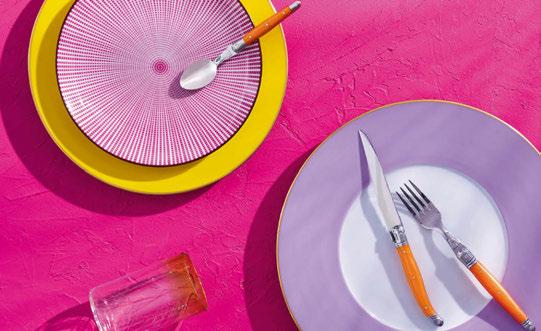
As Europe looks ahead to the summer, the French organisation Francéclat has identified the biggest tableware trends set to take over hospitality settings with the warmer days. The company, which is responsible for developing French timepieces, jewellery and tableware across the lifestyle sector, is forecasting an emphasis on joyful designs incorporating colourful and textured pieces couples with nostalgic shapes.
Colours and Harmonies
Candy-coloured ranges that pair marshmallow pastels with vibrant, juicy shades are set to have their moment in the spotlight this season, with soft pastels and bold, bright shades colliding in a high-contrast palette. Fuss-free two-tone designs will have their place at the table, alongside graphic multicoloured styles, for an upbeat effect. Francéclat highlights jewel-toned glassware from Bruno Evrard and Duralex, bold plates from Zeste Electrique and eye-catching cutlery from brands such as Capdeco and Jean Dubost as capturing the mood.
Materials and Motifs
Stoneware this summer will be vibrant and positive, with matte and glossy textures working in juxtaposition to create dynamic and artistic pieces. In a poetic take on tableware, whimsical drawings look set to remain popular, with delicate plates by Marie Daâge and Robert Haviland & C. Parlon playing into the trend. Nostalgia will also be key, with simple layered motifs paired with gingham in a nod to the tablecloths of childhood and summers gone by.
Shapes and Finishes
Artisanal-looking pieces that make the most of simple, functional forms and round, oval, airy shapes are leading the way this season. Voluptuous and curvy designs bring a sense of drama and playfulness to table settings, with finishes left purposefully uneven for maximum impact. From vivid cutlery at Sabre, to bold vases at Ogre la Fabrique, vivacious accessories will add summery sparkle to tablescapes.
www.franceclat-international.com
PETITS FOURS 112
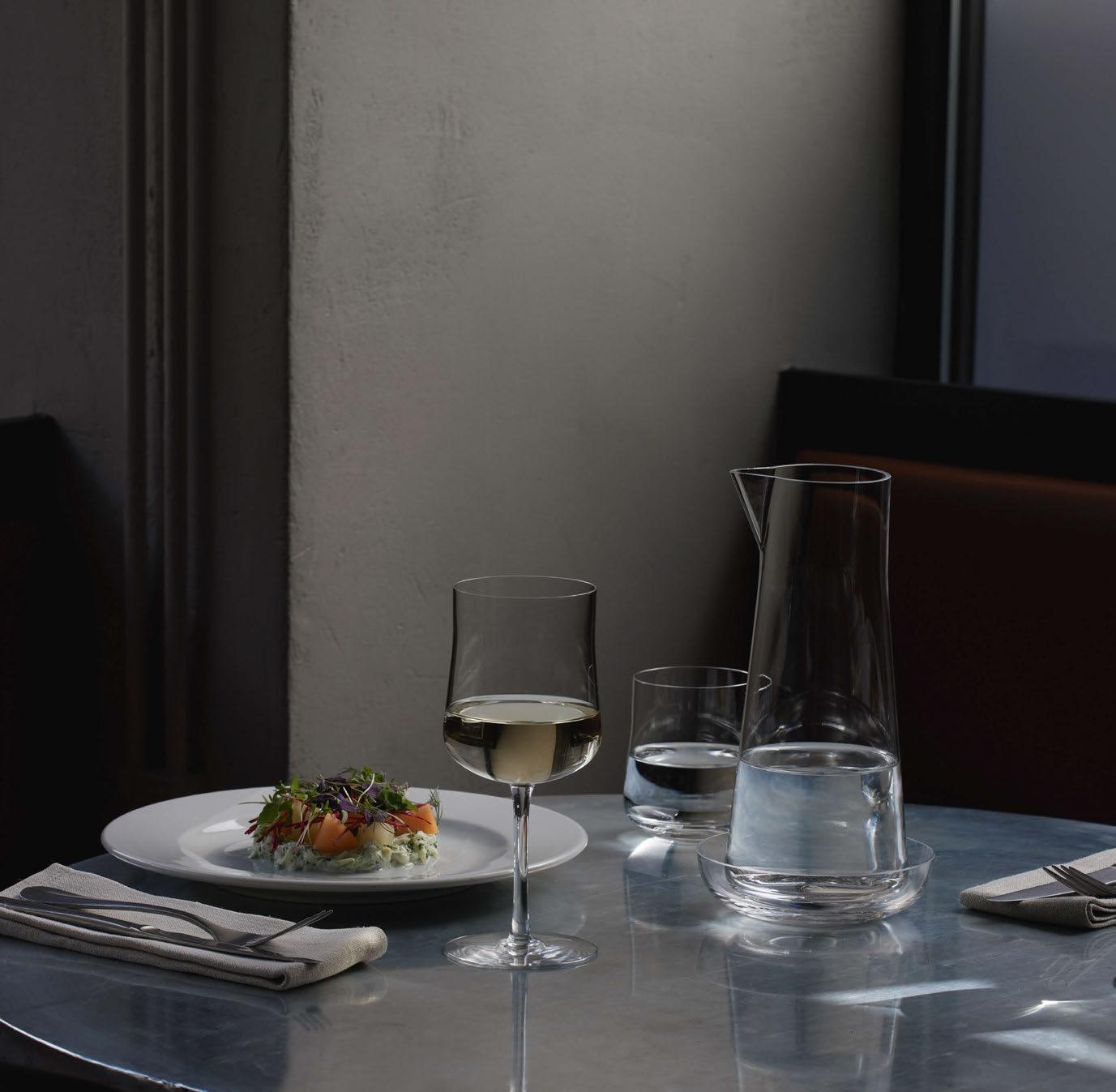

Informal
Where Artistry Meets Hospitality Orrefors NYC Showroom, 41 Madison Ave, 9th floor (800)-351-9842 | info@orrefors.us | www.orrefors.us You can easily order your Orrefors Crystal through Singer Equipment Co. www.singerequipment.com/lmt
Designed by Björn Dahlström

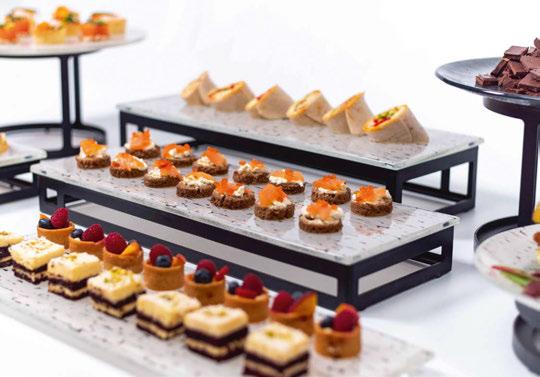
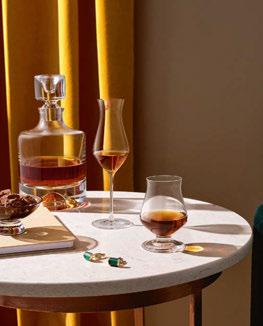
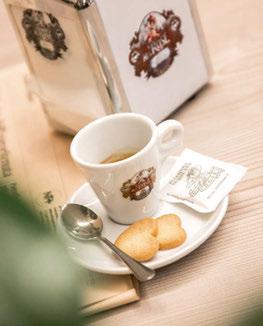
1. Narumi Luminar
Japan-based bone china manufacturer
Narumi has unveiled Luminar, a new dinnerware collection for modern tablescapes. Inspired by the luminous lights of the universe, the series is characterised by pearl tones, which are elegantly arranged to reflect room lights whilst providing a sparkling backdrop for culinary creations. All items in the Luminar range are designed with a different balance, allowing restaurants to create and enjoy a variety of tablescapes depending on the design combination. Luminar is an ideal signature plate for fine dining and lobby lounges where guests can relax and enjoy a premium atmosphere.
www.narumi.co.jp
2. MyGlassStudio Mid-Century Modern Canape
Display
Designed for functionality, simplicity and style, the Mid-Century Modern Canape Display collection comprises bowl risers, tiered canape trays, footed boards and tasting plates for buffets and receptions. Made for professional use, the series is dishwasher safe, ultra-durable and hygienic. The glass surfaces are nonporous, whilst the metal elements feature an anti-slip rubber powder-coating. The range is available in six non-toxic, peel and acid-resistant colour themes –cream white and grey, beach glass, grey metallics, black and gold, white and gold and olive grey – as well as with bespoke design options delivered in four weeks. www.myglassstudio.com/catalogues
3. Nude Glass Islands
The Islands collection by Nude Glass is characterised by a simple silhouette with a gently flared rim designed to direct the drink to the tip of the tongue, amplifying its flavours. The accentuated, tulip-shaped vessel with a generous base and tight mouth elevates the nosing experience, enhancing aromas and minimising the dissipation of fumes. Most recently, the Istanbul-based brand has expanded the Islands range beyond whiskey glasses to introduce a new beer glass with the same distinctive silhouette. Launched in 2014, Nude is the first contemporary design brand from the Sisecam Group, a world leader in glass manufacturing and design. www.nudeglass.com
4. Mrs. Rose Caffè
Mrs. Rose Caffè Tin
Mrs. Rose Caffè has selected six types of Arabic beans from the best plantations in the world across Central-South America to Ethiopia, to create a unique and unmistakable blend. The clear and elongated Arabic beans used by Mrs. Rose Caffè produce coffee that is aromatic, soft and delicate on the palate, simultaneously sweet yet acidic with a distinct fruity and cocoa aftertaste. The scent lingers on the nose, prolonging enjoyment to the bitter end. The Arabic beans’ low caffeine percentage allows customers to enjoy the pleasure of coffee at any time throughout the day. Mrs. Rose 100% Arabic coffee is also available in capsules, pods and ground in a tin. www.mrsrose.it
114
1. 3. 4. 2.

1. Chef & Sommelier Symétrie
Designed to meet the needs of restaurateurs, mixologists and caterers looking for delicate yet different glassware, Symétrie is characterised by the vertical lines that run through the bowl of its stemglasses creating a mesmerising optical effect – a new trend that highlights beverages without drawing attention away during tasting. While the 21cl coupe and the 58cl balloon are designed to spark creativity with mixologists, the 16cl flute is ideal for bars and caterers; its small capacity and size is particularly convenient for standing consumption. All Symétrie items are made from high-performance lead-free crystal glass material, Krysta. www.chefsommelier.com
2. Porland Seasons
Porland has unveiled Seasons, a new collection of statement tableware inspired by the 16th-century Japanese Wabi-Sabi philosophy, which emphasises and celebrates the beauty of imperfections. Perfectly imperfect, the range employs a reactive glaze to allow each piece to be unique whilst creating a harmonious balance throughout the collection. Available in five distinct and attractive colourways each inspired by elements of nature, Seasons accentuates the beauty of flaws with pattern differences resulting from hand-craftsmanship. The comprehensive collection encompasses various plates, bowls, presentation pieces and accessories.
www.porland.com.tr
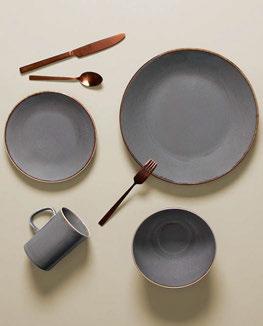
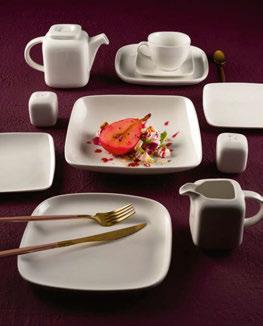

3. Ariane Fine Porcelain Vital Square
Since its inception in 2014, Ariane Fine Porcelain has become a leading force in the porcelain tableware industry, synonymous with technical excellence, professional expertise and creativity. With sleek curves and timeless elegance, Vital Square offers a complete tabletop solution in various sizes to suit today’s horeca environments. The collection withstands the demands of highvolume service, ensuring long-lasting performance without sacrificing visual appeal. Ariane Fine Porcelain creates meticulously tailored ranges for industry professionals by industry professionals, harmoniously merging artistry, practicality, durability and timeless designs. www.arianefineporcelain.com
4. Steelite International Signature
Steelite International is a designer, marketer, manufacturer and supplier of award-winning tableware, lighting and buffet solutions for the global hospitality industry. In 2024, Steelite is celebrating 15 years of collaboration with influential Thai designer Rene Ozorio with the launch of the Signature collection. Exuding quiet luxury, the series of bowls draws inspiration from diverse cuisines and cultures, celebrating nourishment and conviviality. Made from bone china – which is known for its luminosity, lightness, luxurious colour and durability – the Signature collection blends functionality and aesthetics with an appreciation for quality. www.steelite.com
PETITS FOURS 115 PETITS
1. 3. 4. 2.
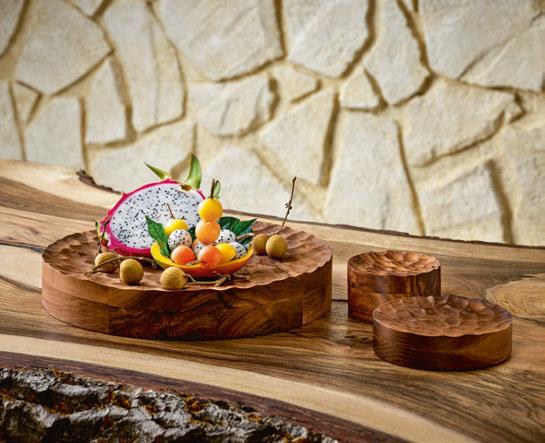

BHS – Playground
Elevate
Playground has unveiled Elevate, a series of wooden platforms with varying heights and diameters, offering visual appeal, whilst opening up new possibilities for food presentation. Available in either oak or walnut, the hand-milled platforms feature fine, regular indentations to mimic the surface of water rippled by the wind. Whether used solo atop a reception desk or as a table centrepiece, the wooden blocks from the Elevate collection make for striking and versatile statement pieces. Playground is one of three timelessly functional and trend-conscious brands from BHS Tabletop, a German manufacturer and supplier of professional, functional and inspiring tableware. www.playground.de
Pordamsa Marea
Founded in 1975, Pordamsa is a trend-setting Spanish porcelain and glass manufacturer known for distinctive and artistic designs that adapt to an ever-changing global marketplace. Specialising in tableware, its traditional manufacturing process ensures no two pieces are the same. Inspired by the constant movement and rhythm of the tide that marks the pulse of nature, the new Marea collection comprises two plates of different diameters, with the brand’s signature silky matte finish. Pordamsa offers creative solutions for the most demanding hotel projects, both aesthetically and functionally, accompanying the culinary creations of some of the world’s most renowned chefs.
www.pordamsa.com
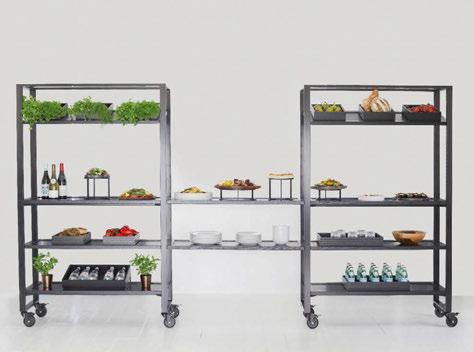
Craster Stak
Craster has unveiled its latest agile F&B furniture system, Stak. The innovative new system offers an ideal combination of F&B buffet and events furniture in a single system to reduce hospitality inventory across properties. Stak enables operators to deliver agile luncheon buffets, mass catering, moveable grab-and-go displays and back bars with ease. Intelligently designed around the Gastronorm footprint, the system shelves are crafted with discreet raised edges to secure trays from the Craster Flow range. Stak is engineered for easy assembly, with locking pins to angle and carry each shelf. Developed with a rigid steel frame, shelves may be placed and angled at any height within the structure, or bridged together to create large, continuous displays across interiors. Robust, discreet wheels enable back-ofhouse setup before movement to front-of-house in a single push.
www.craster.com
116
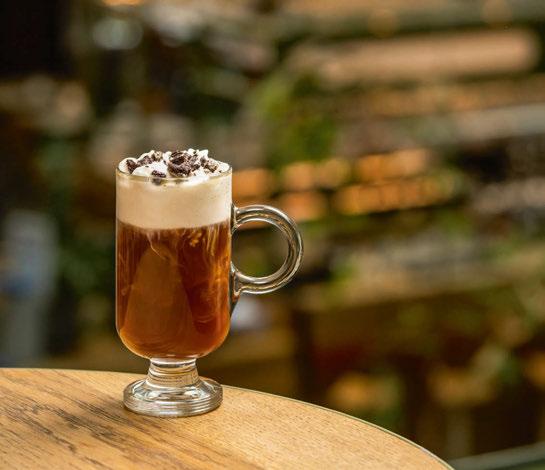
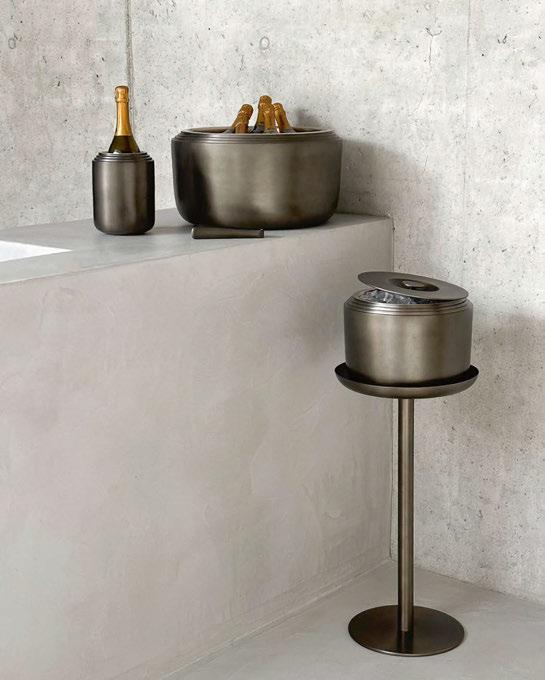
Onis
Sentido
Glassware brand Onis has created the Sentido collection in response to product innovation and creative serving styles within the coffee industry. Sentido – meaning to feel, notice or perceive – evokes the sensorial properties of modern coffee flavours and mixes. Embodying Scandinavian design with a retro touch, each piece in the collection is characterised by a round handle, sturdy base and smooth lines, making Sentido suitable for various demands within the foodservice industry. This ‘new coffee’ experience claims a distinct shape that can become a statement of the reinvention of coffee culture. Comprising four multipurpose capacities, the collection blends functional simplicity and a timeless silhouette to fit both traditional coffee and original mixes.
www.onis.eu
XL Boom Laps
Founded by Geert-Jan Van Cauwelaert and Ann De Cock in 1997, XL Boom is renowned for its innovative approach to contemporary design. With a commitment to quality and expert craftsmanship, the Belgium-based design brand consistently delivers elegant pieces that elevate any living space. The Laps collection embodies this dedication to excellence. Envisioned by Belgian designer Alain Gilles, each handmade piece reflects a dedication to detail and design. Available in two different finishes – brass and black aluminium – Laps offers exceptional versatility. With its clean lines and minimalist aesthetic, the series adds a touch of sophistication to a range of hospitality environments. Whether used for serving or displaying, this selection of carefully crafted pieces elevate everyday moments into special occasions.
www.xlboom.com
PETITS FOURS 117



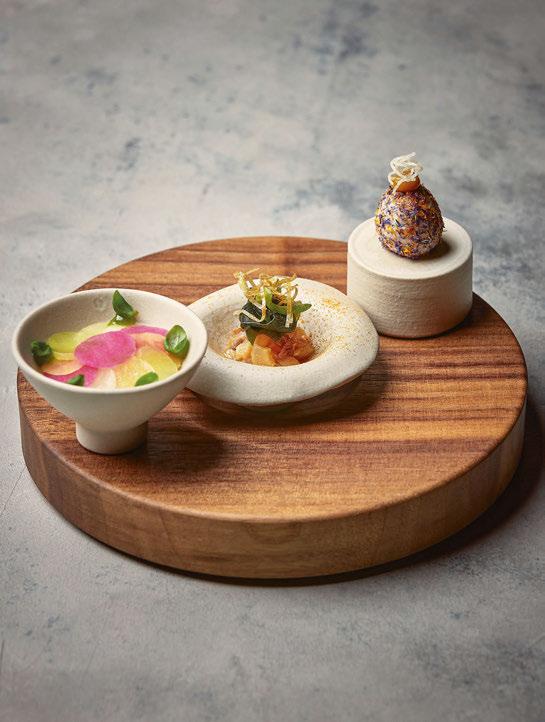
1. Corby Hall
Corby Hall, a family-owned business based in Randolph, New Jersey, has supplied the international hospitality industry with high quality flatware, holloware and bright white porcelain dinnerware for the past 40 years. With designs ranging from traditional to contemporary at competitive price points, the company can supply all F&B outlets associated with a full-service foodservice operation. Its global distribution network, coupled with production facilities in Europe and Asia, allows for seamless service for both new orders and re-supply. The Bolero range comprises 13 pieces made from 18/10 Forged Premium Stainless Steel with either a mirror or silver plate finish. www.corbyhall.com
2. Costa Nova Marrakesh
Designed by French floral artist Christian Tortu, the Marrakesh collection blends sustainable craftsmanship, nature’s essence and Moroccan mystique. Inspired by the enchantment of the Majorelle Gardens and the vibrancy of Moroccan markets, the range is characterised by delicate floral forms with a combination of speckled glazes and sandy, unglazed textures. Made from Ecogres, Marrakesh is not just an aesthetic tableware choice, but an invitation for restaurants to showcase their dedication to sustainability. Produced by leading stoneware manufacturer Grestel, Costa Nova, specialises in durable and timeless Portuguese fine stoneware products. www.costanovaprofessional.com
3. Rona 2Serve Edition
Rona 2Serve is a professional crystalline range created specifically for the catering sector. Edition showcases all the best features of Rona’s professional glassware with a classic design that is suitable for a range of occasions in a variety of settings. The line encompasses typical glassware for any drink, including a popular ‘Hurricane’ glass for mixed drinks, or two different sparkling wine glasses – a prosecco glass and a champagne flute. Launched more than 20 years ago, Rona 2Serve’s complete collection of glassware is continuously available from a large logistics centre in user-friendly quantities and sample shipments.
www.rona.glass
4. Goodfellow & Goodfellow Studio Mattes Matt White/ Storm Drip
As a trusted supplier for Michelin-starred restaurants around the world, Goodfellow & Goodfellow is renowned for its commitment to sourcing the finest cuttingedge tableware for its clients, enabling them to present their cuisine in the most stylish and innovative way. The Studio Mattes presentation pictured embodies this ethos. This marriage of ceramic and wood elements was designed specifically for a tasting menu is and is unique to this customer. G&G consults with each client in order to achieve memorable and distinctive solutions. The Goodfellow & Goodfellow London showroom serves as a hub of inspiration and project workshop. www.goodf.co.uk
118
Bolero 18/10
1. 3. 4. 2.
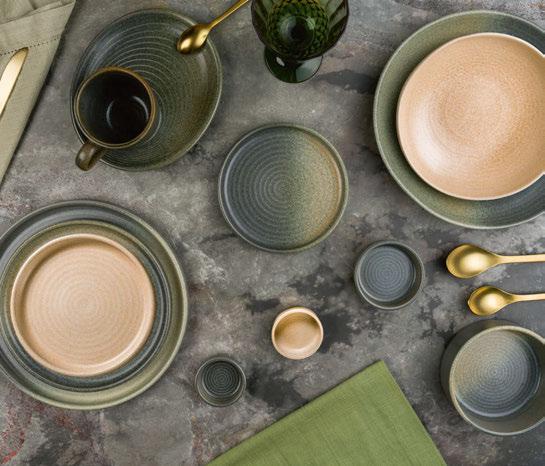
Bonna
Premium Vitrified: Hornfels & Mirage
Bonna Premium Vitrified elevates culinary creations by offering durable, sustainable and handcrafted dinnerware solutions that are both functional and aesthetically pleasing. The fully vitrified dense and high-quality clay body provides durability, each item has both an exceptionally long product life cycle and low water absorption. Reactive glaze technology also guarantees a unique and authentic design. Bonna Premium Vitrified is an environmentally friendly product category, supporting the company’s low carbon footprint initiative. Sustainable product quality and eco-optimised production principles are sustained by single-firing and locally sourced raw materials. This specially designed vitrified collection delivers an improved product life compared with stoneware, thanks to the improved recipe and higher firing temperature. www.bonna.com.tr
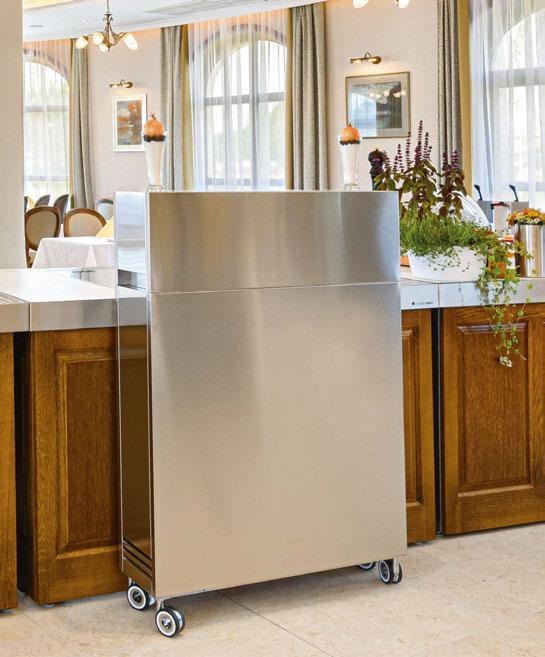
Meveca Moove
Specialising in mobile live cooking, buffet and banquet solutions, Meveca has recently enhanced the dining experiences at Raffles London at The OWO through the provision of its Moove tables. With customisable features, the versatile product ensures practicality and convenience during front-of-house service, without detracting from the design of a space. Meveca’s tables, trolleys and coffee cabinets are strategically placed throughout the hotel, adapting for use in both restaurants and events spaces. Based in Germany, Meveca’s team of designers and engineers are dedicated to delivering sustainable, high-tech solutions for the F&B industry, offering a variety of products ranging from bespoke furniture to the innovative livecookintable®; with plug-and-play systems and drop-in modules, the concept empowers its clients to create next-generation culinary experiences.
www.meveca.com
PETITS FOURS 119
ADVERTISING INDEX ISSUE 36
120
Arc 099 Ariane 124 BHS 033 Bonna 010-011 Corby Hall 002 Costa Nova 005 Costa Verde 067 Craster 035 Cygnet Distillery 081 Fine Dining & Living 068 Fracino 100 Franke 008-009 Goodfellows 023 Hardy Cognac 091 John Jenkins 077 Julius Meinl 011-012 La Marzocco Modbar 103 LSA 020 Melitta Professional Coffee Solutions 123 livecookintable 059 Mrs Rose 019 MyGlassStudio 043 Narumi 070 Nude 057 Onis 037 Orrefors 113 Pordamsa 075 Porland 014-015 Refork 093 Rewthink 089 Rona 108 Steelite 006-007 Studio Riviera 016 Sunraysia Five Star 096 Ten To One Rum 078 To The Table Europe 121 To The Table MEA 083 Vista Alegre 049 WMF Professional 105 WOC n/a XL Bloom 065 Zafferano Srl 095 Zieher 051

On The Map
From Fiji to France, a new study reveals the most searched-for chefs around the world.
In the world of fine dining, success is often measured by industry accolades, stars, quality of cuisine or number of covers. However, a new study by Explore Worldwide has revealed an alternative source for rating a chef’s popularity. The food and drink tour operator set out to uncover culinary leaders in all corners of the globe – those who have not only mastered their craft, but also captured the attention of foodies. To do so, they analysed the number of Google searches made for more than 1,700 contemporary chefs between November 2022 and October 2023, creating a map that pinpoints the most popular in each country. Gordon Ramsay – at the helm of The Savoy’s Restaurant 1890 and Savoy Grill –came out on top as the most-searched-for chef globally, having amassed a staggering 12 million searches. Other high-ranking European names
include the three-Michelin-starred Austrian chef Wolfgang Puck, whose Cut and Spago brands resulted in 1.32 million searches, and the French-Monégasque culinary icon Alain Ducasse (1.1m). In the Middle East, Turkey’s Fatih Tutak garnered attention for his recently opened restaurant Gallada at The Peninsula Istanbul, while Marcus Samuelsson of Four Seasons Hotel Montreal fame is the most popular Ethiopian chef. In the Americas, Venezuelan Lorena Garcia has been making waves on the net since joining The Venetian Resort in Las Vegas, while Four Seasons Resort Tamarindo’s Elena Reygadas has earned the title of Mexico’s most-searchedfor chef. Though the F&B sector is far from a popularity contest, in the competitive world of hotel dining, enlisting a chef with their name on the map could well be a recipe for success.
ELENA REYGADAS MEXICO
GASTÓN ACURIO PERU
CLARE SMYTH IRELAND
GORDON RAMSAY SCOTLAND WOLFGANG PUCK AUSTRIA
ALAIN DUCASSE MONACO
GIADA DE LAURENTIIS ITALY
LORENA GARCIA VENEZUELA NINA COMPTON SAINT LUCIA
DIANA TANDIA MAURITANIA
FATIH TUTAK TURKEY
MARCUS SAMUELSSON ETHIOPIA
CURTIS STONE AUSTRALIA
122
WASHING-UP
PRIYA DARSHANI FIJI CHING-HE HUANG TAIWAN
VINCE BUGTONG PHILIPPINES












www.melitta-professional.com
Professional.
Success with co ee needs passion. Visit us in Copenhagen! ® Registered trademark of a company of the Melitta Group.
World of Coffee Copenhagen June 27. – 29.2024 Booth – DE-013 Welcome to Melitta
Not being satisfied with the first available solution. But constantly improving. Always making things better. For example, discover the different brewing methods and the innovative milk system of our new fully automatic Melitta® Cafina® CT8plus.
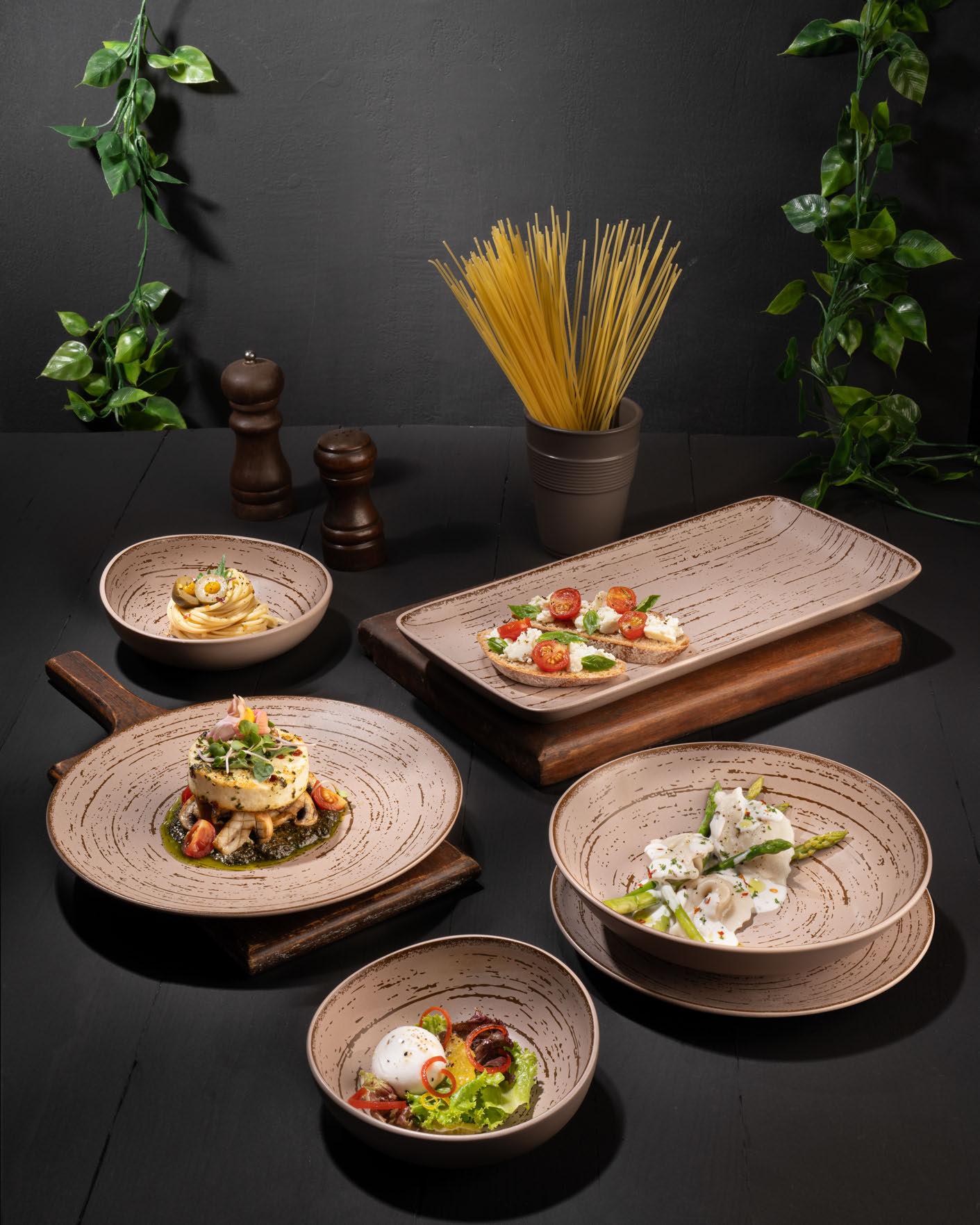
Create Unforgettable Dining Experiences with Ariane Fine Porcelain Tableware HALL: NORTH BUILDING BOOTH NO.: 7830 MAY 18 - 21, 2024 McCormick Place
Chicago, IL
 HOTEL FOOD & DRINK
HOTEL FOOD & DRINK






























































 © Josh Niland
© Josh
Niland
© Josh Niland
© Josh
Niland





















































 Photo by RAIZ PHOTOGRAPHY
Photo by RAIZ PHOTOGRAPHY



























































































































































































